 |
[ Outlaw Genealogy | Bruce
History | Lost Chords ] [ Projects | News | FAQ | Suggestions | Search | HotLinks | Resources | Ufo ] |
 |
[ Outlaw Genealogy | Bruce
History | Lost Chords ] [ Projects | News | FAQ | Suggestions | Search | HotLinks | Resources | Ufo ] |
Introduction
I have been researching the Outlaw family name for quite a while now and with the data that I have found, it does seem time to reflect on the information.
The history and origins of the Outlaw family (or families) has been the object of my investigation . I started out in the 1990's with interest in my direct family connection and that led to other questions as to the origins and history of the original John and Edward Outlawe brothers in Virginia. That led to collecting all the early history records of the family that I could find. Beginning around 2005, many records and books in England (and around the world) have begun to be scanned and included in web search engines, a wealth of data has been brought into the public domain.
Questions, Avenues to Research
Methodology: Prosopography
- is an investigation of the common characteristics of a historical group,
whose individual biographies may be largely untraceable, by means of a
collective study of their lives, in multiple career-line analysis.[1]
Prosopographical research has the aim of learning about patterns of
relationships and activities through the study of collective biography, and
proceeds by collecting and analysing statistically relevant quantities of
biographical data about a well-defined group of individuals. This makes it a
valuable technique for studying many pre-modern societies. Prosopography is an
increasingly important approach within historical
research. The term is a popular one, and the concept is easily inflated.
Now I am almost convinced that we are in some way related to the East Anglia Danes, Thurcytel AND Utlamhe "the Outlaw" notice that Utlamhe would be Utlaghe if replacing "g" for the "m" . Canute founded St. Benet's at Holme. Harold was also closely connected to St. Benet's , Harold Godwinson put the abbot of St Benet's, Aelfwold, in charge of defending the coast against invasion. After the Conquest, Aelfwold fled to Denmark. St Benet's is also connected to Earl Ralf II.
But Edgar/Edward "The Outlaw" supposedly was not married with no known children. So this legend may now have some legs. Born ~1051 and died between 1110-1125 57-70 years.
I find it hard to believe that the long lived Edgar never had any children. But if he did, why would any of them be known as "Vtlage" ? Would they be his illegitimate children?
Hereward - a Breton, his father was Leofric of Bourne, nephew of Earl Ralph the Staller; and his mother was Eadgyth, the great-great-niece of Duke Oslac. William the Conqueror appointed Ralph the Staller, an aristocrat of Breton ancestry born in Norfolk, to the earldom. On his death in 1069 he was replaced by his son Ralph Guader, who was one of the leaders of a rebellion against William, known as the Revolt of the Earls, in 1075. With the failure of this uprising Ralph fled to his lands in Britanny and no successor was appointed (Earl - of East Anglia) ...
Of course it's not all that clear when you look at the Latin. Turkillus AND Outlaw the Exile...
This Edgar/Edward "the Outlaw" Atheling, the uncrowned king. For this legend to be true, Edgar the Outlaw has to have children, and for some reason they end up using the surname of Vtlage around ~1080 or so, and that Ninety years later around 1169 there is a Walter Vtlage and a sizable group of Vtlage's around in area circa 1190.
Edgar Atheling went "Outlaw" and was part of several rebellions ~1070. It is hard to imagine that if he thought of some future dynasty that he did not have any thoughts family and children.
He would have been about 19, when he was with Hereward in 1070. Hmmm.
And as he travels around from town to town, one would think he'd be popular with the Saxon women?
Some woman has an affair with "The Atheling Outlaw", what's she going to call the children? And since he was on the move there may have been several women in different parts of Norfolk/Kent England.
So even though "never married" and no children are reported to be of Edgar Atheling, it makes you wonder...
I also would propose that "The Utlage's" might have traveled with Edgar the Atheling as his men and bodyguard's which explains the later distribution of "Utlages" from Durham to Kent.
I know , it is quite a stretch.
Research timeline: Edgar The Outlaw Atheling Timeline
Edward "The Outlaw" Atheling
was born 1016 in The exile; the Outlaw Edward. He died 1057 in London, England and was
buried in St. Paul's Cathedral, London, Middlessex, England. Edward married Agatha Aroad , Of Hungary Van Brunswick before 1045.
Then there was "Edgar" alias Edward "The Outlaw"
Edgar 'Atheling' b. circa 1053, d. between 1125 and 1130
- Edgar 'Atheling' (?) was born circa 1053 at Hungary.1 He was the son of Edward 'Atheling' (?) and Agatha (?).2 He died between 1125 and 1130,
unmarried.
In October 1066 He was chosen to become King of England after the Battle of Hastings (by Archbishop Aldred, the citizens of London, and the earls Edwin and Morkere). However he submitted to William the Conqueror
before Christmas
Edgar Atheling, or Prince Edgar, son of Edward Atheling, also called Edward the Outlaw, and grandson of Edmund Ironside, was probably born in Hungary, whither his father and uncle, then children, had been sent after the accession of Canute. He came to England with his father in 1057, but though he was rightful heir to the throne on the death of Edward the Confessor, his claims were passed over. After the fall of Harold at the battle of Hastings, he was actually proclaimed king at London, and appears to have been recognized for some time as such; however, he was one of the first to profess submission to the Conqueror, whom in the next year he followed into Normandy.
In 1068 he was in Scotland, and his sister Margaret was married not long after to King Malcolm.
1069 - He took part in the invasion of England and the storming of York Castle in 1069, and was induced on several occasions subsequently to make rash attempts of a similar kind, followed by formal reconciliation with William.
In 1086 he went to Italy, and is said to have joined the Norman bands there.
In 1098 his nephew Edgar, with his aid, was raised to the Scottish throne. In the civil war between Henry I. and his brother Robert, duke of Normandy, Edgar joined the latter, and was captured by Henry at the battle of Tinchebrai in 1106. The year of his death is unknown.
He
died abt 1110
Edgar the Ætheling
- c. 1051 – c. 1126) was the last male member of the royal house of Cerdic
of Wessex (see House
of Wessex family tree). He was proclaimed, but never crowned, King
of England in 1066.
...
There is no evidence that Edgar had married or produced children apart
from two curious references to an "Edgar Adeling" found in the Magnus
Rotulus Pipae Northumberland (Pipe
rolls) for the years 1158 and 1167[19].
Edward Freeman writing in The History of the Norman Conquest says that
either this was the same Edgar and aged at least 110 years (an exceedingly
unlikely thing) or it was a son of his or it was some other person known by the
title "Ætheling". Nevertheless, as far as anyone knows, the death
of Edgar extinguished the male line of the original royal family of England.
Edgar Atheling - Story Video
The Golden Falcon
Cum quibus nec non et alii in militia probatissimi adhus computati sunt, Lefricus Diaconus et Villicus de Draitone, atque Turkillus et Utlamhe, id est Exhulis, cocus Herewardii, Hogor cognatus Herwardi, Winter et Liueret duo praecleri et Rapenaldus dapifer de Ramesis
Edward Outlaw (Utlamhe) or Atheling, son of Edward Edmundson called Ironside, was heir to the English
throne.
Turkillus was Thorkill of Ardern, sheriff of Warwickshire, a pre-Conquest Norman. Thorkill possessed vast lands in Warwickshire in 1086, part of which had been seized from other Englishmen. The property was valued at more than £120 (increased by a third between 1066 and 1086), assessed at over 35 hides for the geld and consisting of nearly 220 ploughs. The major part of Thorkill's lands passed to Roger of Beaumont, Earl of Warwick and Leicester - Thorkill's heirs were Beaumont's military tenants.
Normans came into England as early as 1002 in the retinue of Emma Aelfgifu, daughter of Richard, Duke of Normandy. She was wife of Ethelred the Unready by whom she had Edward the Confessor and secondly of Canute, by whom she had Hardacanute. Her niece's stepson was Baldwin V of Flanders at whose court Emma took refuge during the reign of Harold I (1037-9), Canute' son by his first marriage. Emma returned to England during Hardacanute's reign and died in 1052. William the Conqueror was her great nephew.
Notice here how we have "The" Outlaw - Thurkill - Ketel
and Hereward and St. Benet
Holme Abbey connection:
1014 - Danish
Earl Thurctel -(Thurkill) - sides with the Cnut - Scandinavian
loan-words in Middle
1019 - St.
Benet's - Scholars have accepted that Canute founded the abbey in 1019
1069 - Three
sons of King Swein came from Denmark, with two hundred and forty ships into
the Humber, together with Earl Osbeorn and Earl Thorkil.
1070 - Thurcytel
Utlamhe "Utlaghe" "the Outlaw" - with Hereward "the
Wake" (also "The Outlaw")
1086 - Thurkil
the White
and his wife Leofflæd are mentioned in the Domesday book, Thurkil as
pre-Conquest holder of Wellington
10?? - Here in this document it is made known how I, Thurketel,
grant my possessions after my day. First, I grant that land at Caister and at Thorpe
with meadow and with marsh, with ingress and with egress, to God and St Benet
and St Edmund at Bury and at Holme, for the redemption of my soul.
And my wife's portion is to be for ever uncontested, for her to hold or to give
where she pleases. And to my lord his due heriot.
And my daughter Ælgwyn is to have the estate at Ormesby witht the proviso that
she may not forfeit it; and after her time the estate is to go to Holme for my
soul and for hers, except that land which Omund had; that my nephew Ketel
is to have. And my nephew's children, the sons of Swegn and of Ealhmund, are to
have the estate at Scratby.
And the Abbot of Holme is to have a pound and the Abbot of Bury
another. And my men are to be free, those who will work for it (?). And
whosoever wishes to despoil this will, may God deprive him of the kingdom of
heaven, unless he repent it here.
There are three of these documents: one is at Holme and the second at
Bury; the third with Thurketel himself.
Source: The
will of Thurketel Heyng
Lands: Caister and at Thorpe ( there are other Outlaw references to Thorp or Torp )
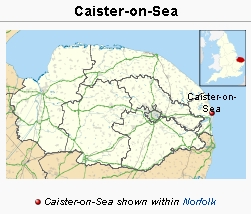
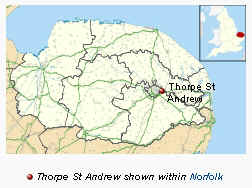
Caister-on-Sea - is a seaside resort and civil parish in the English county of Norfolk. It is situated on the coast, some 3 miles (4.8 km) north of Great Yarmouth - The Romans arrived in Caister-on-Sea in the 1st century AD. The name Caister-on-Sea derives from the Latin castra meaning castle, and Caister-on-Sea was the site of a Roman fort associated with the Saxon Shore.
Burnham Thorpe - is a small village and civil parish on the River Burn and near the coast of Norfolk in the United Kingdom.
This Thorp fits much better: Thorpe St Andrew - Thorpe is in the Domesday Book, in which it is spelt ‘Torp’, which is a Scandinavian word meaning village (see Thorp). It is thought that the Danes were in East Anglia as early as 870 AD and in 1004 Sweyn and his ships came up the river to Norwich. There is also evidence that Thorpe was occupied by the Romans with the discovery of various remains. The earliest references found that relate to the parish are under the names of ‘Thorpe Episcopi’ and ‘Thorpe-next-Norwich’. In later years it has been known as ‘Thorpe St Andrew’
Now if we look a hundred years later we see a nexus of Normans, Bretons and Danes (some by marriage) , Vtlage and Ketel and Torp (Thorpe), Geoffrey the priest of Honinges is also from St Benet's and on and on......
Notice here also that Walter Vtlage is a "main man" mentioned right along with Glanville's uncle and others that I have been able to document. So the question might be was Vtlage a descendant of Edgar "The Outlaw" Atheling? :
1150~1169 - Bromholm Priory - House of Glanville - Charter of Bartholomew de Glanville To Bromholme Priory - Walteri Utlage - Et duas partes decimarum meorum hominum: scilicet avunculi mei Rogeri de Bertuna: Et Galfridi presbiteri de Honinges: et Turstani despensatoris: et Warini de Torp: Et Ricardi Hurel: et Walteri Utlage: et Roberti de Buskevill: et decimam totam Ricardi filii Ketel. - An Essay Towards a Topographical History of the County of Norfolk: Tunstede ... By Francis Blomefield, Charles Parkin
" And two thirds of the tithes of my men: that is, of my uncle by my mother, Roger de Bertuna: And of Geoffrey, priest of Honinges: and Turstan despensatoris: Warini de Torp, Ricardi Hurel, Walteri Utlage: et Roberti de Buskevill: And the tenth of the whole Ricardi filii Ketel. "
Then 120 years later we have a marriage between the Ketel's and the Outlaw's:
1280 - Jose
de Keteller father of Alice Kyteller died - Alice Kyteller was about 10 years
old - Alice
Kyteler's father died , Alice, who was an only child, inherited his business
and properties
1298 - Dame
Alice Kyteler marries William Outlawe brother
of Sir Roger Outlawe, Chancellor of all Ireland
List of Outlaw's of the Sea :
1230 - 3 May - King
Henry
III leads an army to France,
and marches on Bordeaux.
1230 - Peter
- Petrus le Utlage de Depa (Dieppe France) - ship license -
Patent Rolls of Henry III - Dieppe,
Seine-Maritime
1385 - Operation of the ferry to West Lynn was farmed to Thomas Outlagh for 13s.4d.
1399 - Thomas Outlawe purchased the right of a little ferry boat for 13s. 4d. from the Gild of Corpus Christi
1468 - Robert
Deryng of Lynne, maistre of the ship called the Marye of Lynne,
wherof is owners Richard Outelawe and Aleyne Thomsone, satth, he sailed from
the towne of Lynne towardes Pruce in Dantzike - DRÁP BJÖRNS. -
VERZLUN
1481 - Feoffment
by Adam Outlawe of West Lynn, chaplain, to John
Dawson of Northlenn, chaplain, 1 September 1481 Thomas
de Acre's chantry and which were granted with other lands by William Walton,
esquire, to Adam Outlawe and
John Harold of North Lynn, shipmaster
1481 - 1st Duke of Norfolk - Lord John Howard, commanded the fleet in the war with Scotland with great success - In the late spring of 1481 John Lord Howard sailed into the Firth of Forth destroying and capturing Scottish ships and burning Blackness - Mary of Lynne - take mariners for the said ship, as the king has ordered an armed force to go to sea to resist his old enemy the king of Scots. - The schippes that foloweth goeth to Scotland with the Lord Howard - The Mary of Lynne
1533 - London and Middlesex Fines: Henry VIII - London & Middlesex - Adam Owtlawe, 'maryner,' - Easter Anno 25 1533
1543 - Adam
Owtlawe - send four ships to the Downes - Feb 23 - Sir Francis Bryan
to the Kings Council - Scotch prisoners
1544 - July
1544 Expedition to Calais - Captain Adam Owtlawe
1544 - Ships
- Great Shallop of Dover (Adam Owtlawe, c) - Cavendishe Shallopp
(Adam Owtlawe, c.) November 28 1544
1544 - Ships
The Newe Barke 160 t., 120 m., Adam Owtlawe. (fn. 7) - Caleis
- Greate Shalop (D.), Oct 29 1544
1647 - May
16 - Edward Cooley of Lymehouse Shipwright and Evah Outlaw, M. Marriage
- St. Dunstons Stepney Lymehouse London
1658 - Nov
16 - John Outlawe of Lymehouse Shipwright and Elizabeth Baker of
Ratcliffe, W. (marriage) W.=Widow - St. Dunstons Stepney Lymehouse
London
1665 - Capt.
John Outlaw sails
"The Olive Branch" ship of six guns with 96 men of crew back to
Virginia from Florida. Part of Edward Morgan's fleet preparing to attack
the Dutch West Indies
1682 - Captain
John Outlaw - serves as mate on the Bachelor’s Delight, HBC -
Hudson Bay Company , commanded by Benjamin Gillam* who sailed from New
England to the the Nelson River
1692 - Captain John Outlaw (Jean Outelas) married Françoise Denis - Boucherville, Quebec
1711 - The
Salamander, John Ralph, master,
was built for the coastal trade and for no other service in the Elizabeth River,
Virginia about 1707 for Lewis Connor, a merchant.
In April 1708 molasses and sugar were laden on the ship in the James
River. Given a permit to sail to
the Potomac, no further security was needed for such a trip.
The sloop was seized in the Potuxon River in Maryland.
EDWARD
OUTLAW, ship’s carpenter and builder of the Salamander,
filed a two page deposition on July 30, 1711 in the case.
List of Outlaw's associated with the church :
It is interesting that we don't find any earlier priests...
1311-1340 - Sir Roger Outlawe - The Grand Prior - Hospital Of Saint John Of Jerusalem In Ireland - Priory of Kilmainham - Lord Justice - Not a priest in the regular sense, many references to Roger and his Nephew William being military men and engaging in many actions around Dublin Ireland.... as "Prior's" of Kilmainham - Hospitallar's
1340 - Presentation
of Reginald le Outlawe, parson of the church of Esthattele,
in the diocese of Ely, to the church, of Risshenden, in the
diocese of Lincoln, in the king's gift by reason of the temporalities of the
priory of Lenton being in his hands, oni an exchange of benefices with Hugh
de Luffenham.
1374 - Adam
OUTLAWE signed
ordinances of the Guild of St John the Baptist in West Lynn (ref.
BARDSLEY) - Adam
Outelawe - Original Ordinances -
The history of freemasonry Volume4 - Early British Freemasonry
- Such guilds were everywhere under the patronage of the Holy
Trinity, or of certain saints
1392 - Isle of Ely - Priory of Barnwell - in Cambridgeshire, - John de Bernewelle, or John Outlawe, elected March 1392, died Nov. 1408 - John de Bernewelle, (fn. 213) whose personal name was Outlawe; (fn. 214) possibly a canon of West Dereham, and one of the three brothers of that name
1437 - John
Utlawe, chaplain to the Precentor - Lincoln Cathedral (
The Lincoln Cathedral
was used for the filming of The
Da Vinci Code )
1463 - Outlawe,
Thomas, capellanus (Chaplain), of Walsyngham Parva - Will
1472 - FEOFFMENT
by Agnes Balle, of Lenn Episcopi, dau.and heir of John Balle, to Thomas Cokkeson,
of North Lenn, William Greneland, William Herald, Richard Dunnysby, and Adam
Outlawe, of West Lenn, chaplain, of two acres of land in the field of
Clenchewardton at Gripgate.
Witn. John Dawe; Robert Moote; Geoffrey Bedelle; etc.
1481 - Feoffment
by Adam Outlawe of West Lynn, chaplain,
to John Dawson of Northlenn, chaplain, 1 September 1481 Thomas
de Acre's chantry and which were granted with other lands by William Walton,
esquire, to Adam Outlawe and
John Harold of North Lynn, shipmaster
1501 - Sir
ADAM OUTLAWE, of West Lenn (Lynn), St. Peters, priest, died
1501 - Adam
Outlawe Will
1503 - Outlawe
(Outelawe), Adam, Sir, priest, of Westlen, St Peter - Will
1646 - Owtlawe,
Radulphus - Ordi (ordination) - priest - 4/6/1646
1661 - Ralph
Outlaw, A. M. Tho. Thorowgood, rector of Cressingham Magna
1678 - Rev. Robert Outlaw to a messuage and land in Yardley. 4 October, 1676
1683/4 - Ralph
Outlaw, parson of Bintry, declared his assent to
the Prayer Book and the Thirty-nine Articles, and read the Bishop's
certificate of his subscription to the declaration that it is not lawful to take
arms against the King.
1688 - Ralph Outlawe, Rector of Bintry, who Was the son
of Ralph Outlawe of Little Wichingham in the County of Norfolk. He
departed this life ye first day of February 1688
Early Family Groupings
It is interesting to note in these early entries that "THE
VTLAG'S" seem to be a known family.
Outlawed people are listed differently, typically they are specified as
"John Doe, an Outlaw". ( Not "THE Outlaw")
That is NOT how these Vtlage entries are listed.
Also note in these entries, the Vtlage's have property which Outlaw's would no
longer legally have.
Norfolk family - Walter Vtlage ?-> Robert Vtlage -> Alan son of
Robert , Emma his wife (Move to Essex) ->also a Warin Vtlage (Brother?)
Bristol Family (possibly related to the Norfolk family) - Ralph Vtlage
-> John Vtlage son of Ralph
Kent Family - de
Helias Vtlagh - Haghenild
Vtlaghe Dower,
Hildith daughter, Simon,
Adam, Henry , Roger son of Thomas
brothers , Philip
and Henry and Richard and William and Jordan,
sons of Vtlag (Same Henry ?)
It is interesting that in these listings the FATHER's name is never
mentioned, only the widow, we don't know if Helias (Elijah ) is related or if
that's even his name and not a place.
(Canterbury/Kent seems to have been the home of the Vtlage clan , It is
interesting that in 1066 the "men of Kent" made a separate peace with
the Conqueror which allowed them to keep most of there lands at least for a
while )
Walter, Robert, Warin and Alan of Norfolk may have originally been from
Kent.
York Family Isabel widow of William Vtlage This widow Isabel is destitute and referred to as a "native" (so which William?)
London Family: William Utlaghe - London (same William from Kent?)
Dieppe France - Peter
- Petrus le Utlage de Depa (Dieppe) ( Same Peter later went to
York ? )
| - - - - - - - -
1169 - Bromholm Priory - House of Glanville - Charter of Bartholomew de Glanville To Bromholme Priory - Walteri Utlage Ricardi filii Ketel.
1198 - Philip and Henry and Richard and William and Jordan, sons of Vtlag’ - Kent Pipe Rolls - John 1198
1200-1212 - De
Helia Vtlagh (Vtlagh
from Elim [ Elham?] )
- The rents which is due to the court of St. Augustine about Mildelton
- (Milton
Kent)
1200-1212 - Haghenild
Vtlaghe - lands
of Newton and Newington - Heirs One part to Hildith married
to a Norman William , two parts to Simon,
and Adam, and Henry and Roger son of Thomas and his heirs - The
register of St. Augustine's abbey, Canterbury, commonly called the Black
book (Kent)
1207 -
Robert de Utlagh, their several nine parts of two knights fees in Runton
and Beeston and Hinderingham, for which they paid castle gaurd to Dover. 9th
of King John *
1207 - Alan
the son of Robert de Vtlage, granted the land of Beston and Runton to
the Prior of Walsingham by deed , sans date, bounded as there.
1210 - Margam Abbey - John, son of Ralph Utlage, of the land in the meadow of Leowine, known as Lewin's-mead, near to St. James' Church, Bristol. - dated in the early years of the thirteenth century.
1218 - Alan
le Ultage
- 21 Aug. Winchester. Suffolk. Alan Outlaw gives the king 20s
1225 - Warin
le Utlage- gives the king half a mark for having a pone
before the justices
1228 - Warin
le Utlagh
1230 - Peter - Petrus le Utlage de Depa (Dieppe) - leads the ship - Patent Rolls of Henry III - Dieppe, Seine-Maritime
1232 - Emma who was wife of Alan Le Vtlage - Suffolk - 16 HENRY III
1236 - William
Utlaghe - London
1241 - Isabel
widow of William Vtlage, their native in the vill of
Fraistingthorp - GRANT by Matilda Constable, Prioress of Swina - Priory
of Bridlington in East Riding of the county of York
1276 - the courtyard of Peter the outlaw ("Utlag'"); Richard of Sureis to Sir William Constable property all the service of 5ac. in Esthalsham - Halsham Yorkshire? - (Sir) William CONSTABLE was born circa 1265 in Flamborough, East Riding, Yorkshire, England
Early Lands of Outlawe:
Bristol:
1210~ - Margam
Abbey - John, son of Ralph Utlage, of
the land in the meadow of Leowine, known as Lewin's-mead, near to St.
James' Church, Bristol. - dated in the early years of the
thirteenth century.
1313 - Willielmus
Outlagh - The Tallage of 6 Edward II - Bristollia Bristol - Tallage
- Bristollia
or, memoirs of the city ... - Gloucestershire
- Bristol
1392 - Simon
Outelawe, Michael Brailes plaintiffs - 1392 Sept. 29.-Oct. 5] York - Premises:
9 messuages, 18 shops in Bristol and suburbs
Durham / York:
1241 - Isabel
widow of William Vtlage, their native in the vill of Fraistingthorp - GRANT by
Matilda Constable, Prioress of Swina - Priory of Bridlington in East Riding of
the county of York
1340 - Seal
- William Utlage (?), - Used by Robert of Durham, merchant.-
Inscription: SIGILLVM WILELMI VTLAGE - Seal design: Round,
armorial, a lion rampant. - pdf
1385 - Exchequer
Lands. —The tenants jointly hold the pasturage of a cottage called Colynfield,
and pay xls. John fil. Richard holds a plot and two acres of land
called Outlawe, once of Simon the Headborough, 2s..- Cleadon -
Whitburn - Durham
Norfork:
1169 - Bromholm
Priory - House of
Glanville - Charter
of Bartholomew de Glanville To Bromholme Priory - Walteri
Utlage
1199 - IBER FEODORUM
- Alanus Utlage, iij. quarteria in Hindringham et Homeresfeld
1204-1220 - Deed
of grant, Lynn - 1d annual rent from a certain [piece of land] 4 feet wide
in Damgate held by Peter Strac
Grant by Laurence Outlaw (utlator) of Len to
the Hospital of the Blessed Mary Magdalen of Len
1207 - Hubert
de Burgh purchased of Roger de Burnham and Julian, his wife, William de
Noiers, Robert Fitz Ralph, and Alice his wife, and
Robert de
Utlagh, their several nine parts of two knights fees in Runton and
Beeston and Hinderingham, for which they paid castle gaurd to Dover. 9th
of King John - The
Norfolk antiquarian miscellany - West
Runton - Beeston
Regis - Hindringham
1207 - Alan
the son of Robert de Vtlage, granted the land of Beston and Runton to
the Prior of Walsingham by deed
Also I have found a reference for "De Outlagh" in "Hindringham Outlagh Manor" An essay towards a topographical history of the county of Norfolk The fees held of the Bishop of Norwich, were the manors of Ringsted Magna, Holkham Wake, Cockthorp, Sniterle, Glanford, Sniterle-Morley, South Birlingham Rightwise, Boyton South Birlingham, Hindringham Outlagh , ... in Norfolk
North Erpingham Hundred -
Beeston Regis - Hugh de Montfort, a Norman, (assistant justiciary of England, with Odo Bishop of Baieux, the Conqueror's brother, and William Fitz-Osborn Earl of Hereford,)
was lord of a manor, out of which Bund, a freeman, was ejected; there belonged to it one carucate of land, with 8 borderers, one carucate in demean, half a one amongst the tenants, pannage for 5 swine, one acre of meadow, one runcus, 2 cows, &c. 20 goats; and 3 socmen held 12 acres of land, and the moiety of a borderer, with half a carucate, then valued at 20s. at the survey at 30s. (fn. 1)
In the 9th of King John, Robert de Utlaghe granted by fine, to Hubert de Burgh, the 3d part of a knight's fee, in this town and Runton, and the 3d part of 2 carucates of land in
Hindringham; and in the 11th of that King, Hubert purchased of Robert Fitz-Hugh, the 3d part of a fee in Beeston, and Runton, and the land in Hindringham, that is his right in them; this Hubert was after created Earl of Norfolk, and held them in capite of the castle of
Dover.
Kent: ~1190-1220 :
1200-1212 - De Helia Vtlagh (Vtlagh from Elim [ Elham?] ) - The rents which is due to the court of St. Augustine about Mildelton - (Milton Regis Kent)
1215 - Haghenild Vtlaghe - lands of Newton and Newington - Heirs One part to Hildith married to a Norman William , two parts to Simon, and Adam, and Henry and Roger son of Thomas and his heirs - The register of St. Augustine's abbey, Canterbury, commonly called the Black book - Hubert de Burgh, the justice of England
Canterbury -
Newenton -
afterwards spelt Newenton, and Newington - Manor of Walworth - The manor of
Newington remained part of the possessions of the monastery of St. Augustine,
till its final dissolution...
Newington, Swale - a village in Kent, England on the A2 road (originally a Roman road) between Chatham to the west and Sittingbourne to the east. The local district council is Swale. The village has its own Railway Station which is situated on the Chatham Main Line between Sittingbourne and Rainham.
Milton Regis -
...the Norman Domesday Book of 1086AD records the town as Middleton Terra
Regis ( Royal lands ) the Kings town of Kent. Noting it as a town and a port of
wealth, whereby William the Conqueror, took it into his personal possession
and gave it into the hands of his half brother Odo for safe keeping, and also
appointed a portreeve (a port sheriff) whose name was Hugh de Port,to
precide over the town - he was later to become Sheriff of Kent
North Petherton
(includes North Newton) - The name derives from the area's location to the north
side of the River
Parrett, from the Latin
Paradæ 'barge' and from the Old English nor tun - The
former Royal Forest
(hunting ground) of North Petherton dated from long before the Norman
Conquest
(Eventually St. Augustine's Canterbury and others get all the land )
"Robert abbot of St Augustine of Canterbury ...
Out of the land of Newton, Hagenild granted to Hagenild 'sister' s and the
heirs of Hildith Hagenild ,
...
the mother of the land [ the Motherland ] which Haghenild Vtlaghe in the day when
living, and dead to be held in Newetun to farm in the forty
shillings yearly from Saint Augustine, granted, and gave unto the sons
and the heirs of the aforesaid Haghenild, Hildith his
sister's Haghenild "
Elham or Darent / chapel of Helles:
De Helia Vtlagh' xvd. ob. - Vtlagh from Elim [ Elham Kent?]
Elham - Boyke Manor - Park Gate Down just under a mile north west of Elham is a small nature reserve but one of the top orchid sites in the country
1195 - Rochester Priory. - For the manor and church of Lambeth, given the manor and church of Darenth, "with the chapel of Helles" , "a sheepcote in Cliffe called Estmers" and the Tenants... "the widow Hagenild" (Vtlage?) . Ranulf de Glanville...Gilbert de Glanville - Lambeth was a royal manor belonging to Countess Goda, sister of Edward the Confessor. ... On these terms the business was concluded 7 Richard I (1195)
or "De Helia ": Refers to "the Darenth manor, St Margaret Helle (or Helles)"
... archbishop of Canterbury, in the year 1195, anno 7 Richard I. with the king's consent, and for the mutual benefit of the churches of Canterbury and Rochester, exchanged, among other premises, a sheepcote in Clive, which was called Estmers, with two hundred and twenty sheep, and certain land in Clive, belonging to it, and certain tenants in this parish, with the lands which they held, and the rents, serv ices, and customs, without any reservation to the archbishop and his successors, for the manor of Lambeth, &c. with the monks of St. Andrew's, in Rochester,
A sheepcote in Cliffe, called Estmers ...Parishes - Cliff British History Online
The location of Clovesho has never been conclusively identified...Older suggestions were Cliffe near Rochester, Kent, previously known as Cliffe-at-Hoo.
Blean - is located in the Canterbury district of Kent, England. It is the name of the civil parish as well as the village within it: the latter is scattered along the road between Canterbury and Whitstable, in the middle of what was once the extensive Forest of Blean.
Here we find the earliest use in literature of "Outlaw" as a proper last name in French 1150-1199 AD:
Renaud de Montauban - Reinout van Montalba(e)n) was a fictional hero who was introduced to literature in a 12th century Old French chanson de geste - The oldest extant version of the anonymous Old French chanson de geste Quatre Fils Aymon dates from the late 12th century (1150-1199 A.D.) and comprises 18,489 alexandrine (12 syllable) verses grouped in assonanced and rhymed laisses (the first 12,120 verses use assonance; critics suggest that the rhymed laisses derive from a different poet).[1] It is one of the longest of all the chansons de geste.[1] Other versions range from 14,300 to 28,000 verses
Charles en apela duc Namlon devant soi, Richars de Normandie et Ullage L'englois.
Charles Duke apela Namlon ahead, Richard
of Normandy and Ullage The englois.
Britain in Medieval French Literature
... the creation of a character named ' Ullage l'Englois ' , Here the
poet seems to have heard the English word 'utlage' (outlaw), occasionally
found in the twelfth century French and frequently in Anglo-Norman
literature in the sense of 'pirate', and to have taken it to be a typically
English proper name.
[ Is he talking about OUR Outlaw's? because WE know that English Utlage's
actually existed in that contemporary time period [ 1150-1200 A.D.]
SO THIS WAS NOT A "MISTAKE" by the POET!
Flanders - Flanders was the traditional refuge for the Saxon royalty of England. The Flemings were Saxons who fled to the Netherlands (called Fleanderland or the "land of those who fled" [ "land of the Exile"] and its Counts were descended from King Alfred the Great.
Flanders - Even earlier in British and Irish history, the Flemings or Flemish were important allies of the Normans in their conquest of England (1066) and invasion of Ireland (1169–1171)
In feudal times, Flanders formed a county, the County of Flanders, which extended over the present day:
During the late Middle Ages Flanders' trading towns (notably Ghent, Bruges and Ypres) made it one of the richest and most urbanized parts of Europe, weaving the wool of neighbouring lands into cloth for both domestic use and export. As a consequence, a very sophisticated culture developed, with impressive achievements in the arts and architecture, rivaling those of Northern Italy. Ghent, Bruges, Ypres and the Franc of Bruges formed the Four Members, a form of parliament which exercised considerable power in Flanders.[3] ... owing to widespread European population decline following the Black Death of 1348, the disruption of trade during the Anglo-French Hundred Years' War (1338–1453), and increased English cloth production.
Flemish weavers had gone over to Worstead and North Walsham in Norfolk in the 12th century and established the woolen industry.
County of Flanders - The county existed from 862 to 1795. It was one of the original secular fiefs of France and for centuries was one of the most important regions in Europe
Flag and Arms
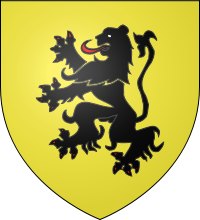 The arms of the County of Flanders
were created by Philip
of Alsace; a climbing or rampant black lion on a gold field. In the
story about the Guldensporenslag,
the arms and its corresponding battlecry Vlaendr'n den leeuw
("Flanders, the Lion!") plays a crucial role in the forming of a
Flemish consciousness, which was popularised in recent times by the book De
Leeuw van Vlaanderen by Hendrik
Conscience. As a result, the arms of the county live on as arms of the Flemish
Community.
The arms of the County of Flanders
were created by Philip
of Alsace; a climbing or rampant black lion on a gold field. In the
story about the Guldensporenslag,
the arms and its corresponding battlecry Vlaendr'n den leeuw
("Flanders, the Lion!") plays a crucial role in the forming of a
Flemish consciousness, which was popularised in recent times by the book De
Leeuw van Vlaanderen by Hendrik
Conscience. As a result, the arms of the county live on as arms of the Flemish
Community.
It is said that Philip of Alsace brought the lion flag with him from the Holy land, where in 1177 he supposedly conquered it from a Saracen knight, but this is a myth. The simple fact that the lion appeared on his personal seal since 1163, when he had not yet set one step in the Levant, disproves it. In reality Philip was following a West-European trend. In the same period lions also appeared in the arms of Brabant, Holland, Limbourg and other territories. It is curious that the lion as a heraldic symbol was mostly used in border territories and neighbouring countries of the Holy Roman Empire. It was in all likelihood a way of showing independence from the emperor, who used an eagle in his personal arms. In Europe the lion had been a well known figure since Roman times, through works such as the fables of Aesop.
1340 - Seal
- William Utlage (?), - Used by Robert of Durham, merchant.-
Inscription: SIGILLVM WILELMI VTLAGE - Seal design: Round,
armorial, a lion rampant. - pdf
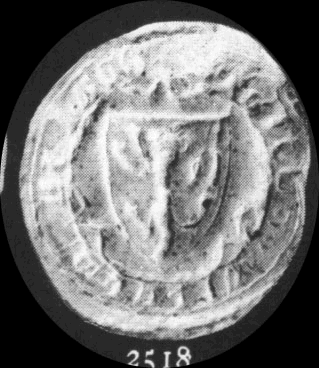
The story of Bruges - ... A race ignorant alike of the refinement and the corruption of Roman civilization, and which, because it was barbarous itself, had never had its spirit crushed beneath the heel of barbarism, a race which hailed from the same fatherland from whence came our own ancestors, akin to them in habit of thought and speech and blood, animated by the same intense passion for liberty and hatred of servitude, by the same reverence for woman and love of home, by the same keen admiration for the brave and the true, was destined to build up that marvellous stronghold of mediaeval freedom, culture and commercial enterprise called Fleanderland, the land that is of the Fleming, of the exile, the land whose hospitable shore had given to the victorious Viking a haven for his ships and a foot or two of solid earth on which to pitch his tent.
How or when the first Flemings came here are subjects wrapt in mystery. Perhaps the same upheaval which, in the middle of the four hundreds, drove our own Saxon forefathers from their old homes in Jutland and Friesland and Sleswicke-Holstein to seek new homes in Britain, impelled also the Saxon Flemings to the northern shore of Gaul. Be this as it may, all along the coast line of the Netherlands were scattered, at a very early date, settlements of men of Saxon origin, of this there can be no doubt, who possessed in a very marked degree the qualities and characteristics of their race. They were chaste, proud, daring, avaricious, given to plunder. Mutual responsibility was the basis of their social system ; the Karl, or free land-holder, the pivot on which hinged their entire political organization. Like all Saxons, they had a horror of slavery. Courage for them was the queen of virtues ; freedom dearer than life ; vengeance but the cultus of filial piety, and family ties the most sacred of all.
Wolves Teeth
The Wolf Almanac: A Celebration of Wolves and Their World By Robert H. Busch
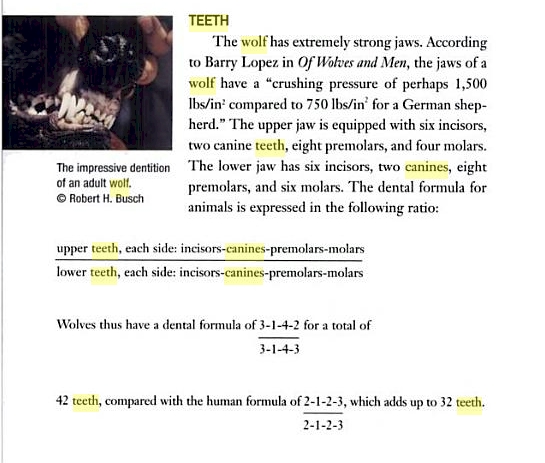

Dental Differences
Wolves and dogs have the same number of teeth, 42 in all. However, wolf teeth are much larger in comparison to the size of the skull, with their canine teeth reaching up to 2 inches long. They also have stronger jaw muscles than dogs of similar size.
Bite Types
All wolves, as with most dog breeds, have a scissors bite, meaning the upper and lower teeth align and rest smoothly together when the mouth is closed. Some breeds, however, have been bred to have an undershot bite, such as an English Bulldog with its lower jaw protruding beyond the upper jaw.
A proper scissors bite is necessary for a carnivore to catch prey and eat the meat and bones efficiently. No wild carnivore would survive without a proper scissors bite, unlike an undershot dog
This research has been moved to Early Outlaw's in Kent - Follow this link for detail
1195 - Rochester Priory. - For the manor and church of Lambeth, given the manor and church of Darenth, "with the chapel of Helles" , "a sheepcote in Cliffe called Estmers" and the Tenants... "the widow Hagenild" (Vtlage?) . Ranulf de Glanville...Gilbert de Glanville - Lambeth was a royal manor belonging to Countess Goda, sister of Edward the Confessor. ... On these terms the business was concluded 7 Richard I (1195)
We are interested in Hindringham because of the early Utlage/Utlagh
references:
Notice Bromholm is in Bacton and Bacton is only 15 miles from Runton/Beeston
Regis and 27 miles from Hindringham home of Robert de Utlagh is associated with
along with his son Alan Utlage.
I have also found a reference for "Outlagh" in "Hindringham
Outlagh Manor" An
essay towards a topographical history of the county of Norfolk
- (no date to connect the reference with)
1169 - Bromholm
Priory - House of
Glanville - Charter
of Bartholomew de Glanville To Bromholme Priory - Walteri
Utlage - Et duas partes decimarum meorum hominum: scilicet avunculi mei
Rogeri de Bertuna: Et Galfridi presbiteri de Honinges: et Turstani despensatoris:
et Warini de Torp: Et Ricardi Hurel: et Walteri Utlage: et Roberti
de Buskevill: et decimam totam Ricardi filii Ketel. - An
Essay Towards a Topographical History of the County of Norfolk: Tunstede ... By
Francis Blomefield, Charles Parkin
1207 - Hubert
de Burgh purchased of Roger de Burnham and Julian, his wife, William de
Noiers, Robert Fitz Ralph, and Alice his wife, and Robert de Utlagh,
their several nine parts of two knights fees in Runton and Beeston and Hinderingham,
for which they paid castle gaurd to Dover. 9th of King John *The
Norfolk antiquarian miscellany - Google Books - West
Runton - Beeston
Regis - Hindringham
1207 - Alan
the son of Robert de Vtlage, granted the land of Beston and Runton to
the Prior of Walsingham by deed , sans date, bounded as there.
So that makes finding of a silver ingot at Hindringham very interesting:

(
Figs. 1,2)The first stray find of a Viking-Age ingot to be recorded in England was discovered at Easingwold, Yorkshire in 1989. 1 Following the publication of this two further isolated finds of ingots were recognized from Norfolk.
One was found in January 1989 with the aid of a metal detector at Hindringham, c. 10km ~E. of Fakenham (Norfolk SMR no.2507I), on a site which has yielded prolific evidence, in metalwork and pottery, of mid and late Saxon occupation.2 The finder, Mr P. West, offered it for identification by the Norfolk Museums Service, but it was unrecognized. After the Ditchingham ingot described below had been given some publicity at the Norwich Detector Club, Mr West resubmitted the Hindringham piece, which was then identified as of Viking-Age origin.
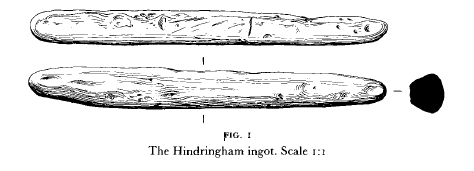 FIG. I The
Hindringham ingot. Scale I: I
FIG. I The
Hindringham ingot. Scale I: I
The Hindringham ingot (Fig. I) measures 10mm long, 8 mm wide and 82.5 mm deep (maximum dimensions). Its weight is 38. I 2 g. In cross-section it resembles a triangle with the peak cut off and with rounded corners. The broad base was presumably uppermost in the casting mould, although it is convex and one might expect it to have been either flat or slightly concave due to shrinkage of the metal on cooling. The ingot does not appear to have been deliberately worked after casting, but there are shallow abrasions, particularly on the base, as ifit had been moved over a rough surface, and there are a number of dents that could be the result of accidental knocks. Two cuts with a sharp instrument (a knife?) into the rounded edges on each side of the base seem to be deliberate 'pecks' (or 'nicks'), i.e. test marks that are often found on metalwork from Scandinavian or Anglo-Scandinavian finds of the Viking Age.
The Hindringham ingot is similar in character to that from Easingwold and others which have been found in Britain in, for example, the mixed coin and silver hoards from Cuerdale (deposited c. 905), Scotby (c. 935) and Chester 1950 (c. 970) and in the l0th-century hoard, mainly of ingots, from Bowes Moor.3 There is considerable variety in their size and shape, but a triangular or, as here, squared triangular cross-section is commonly found. The weight of the Hindringham ingot (38. I 2 g) falls well within the general range of this type of ingot, although it does not fit conveniently into any of the weight standards postulated for this period. 4
The second specimen was found in February 1991 by Mr M. Bone while metal-detecting on a ploughed field at Ditchingham, 2km N. of Bungay in S. Norfolk (Norfolk SMR no. I 1674). It was reported by the finder to the Norfolk Museums Service. Crop-marks, suggesting enclosures of uncertain date, have been photographed in this field. To date only one other artefact has been recovered, a sherd of Ipswich ware of the mid 7th to late 9th centuries.
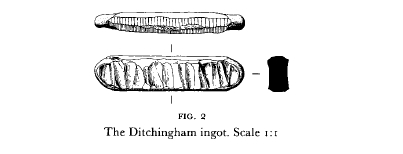 The
ingot (Fig. 2) is rectangular in cross-section, measuring 35 mm long, 7mm wide,
and 5mm deep (maximum dimensions), and weighing 8.81 g. It differs from the
Hindringham ingot in that on its upper surface it has a series of transverse
lines created by hammering, and on each long side it has been hammered to
produce three smooth facets. The base as illustrated was probably the upper
surface during casting, for it is slightly concave due in part to contraction of
the metal as it cooled in the mould and in part to the hammering of the sides.
The surfaces of the base and the two rounded ends do not appear to have been
hammered, and are indeed somewhat pitted from the casting process. No 'pecks' or
other test marks are evident.
The
ingot (Fig. 2) is rectangular in cross-section, measuring 35 mm long, 7mm wide,
and 5mm deep (maximum dimensions), and weighing 8.81 g. It differs from the
Hindringham ingot in that on its upper surface it has a series of transverse
lines created by hammering, and on each long side it has been hammered to
produce three smooth facets. The base as illustrated was probably the upper
surface during casting, for it is slightly concave due in part to contraction of
the metal as it cooled in the mould and in part to the hammering of the sides.
The surfaces of the base and the two rounded ends do not appear to have been
hammered, and are indeed somewhat pitted from the casting process. No 'pecks' or
other test marks are evident.
Ingots with similar transverse hammering are common in
Scandinavian hoards from the mid l0th century onwards, and they are the dominant
type during the late 10th and 11th centuries. In Britain they are found in
as early a context as the Cuerdale hoard (dep. c. 905), but they are
rare. Kruse has noted only fourteen examples out of almost 500 ingots from
England; twelve from Cuerdale and two from the Chester 1950 hoard.s Transverse
hammered ingots are also known from late Roman/Migration Period hoards, notably
from Scandinavia, but not so far as we know from Britain. However, an ingot of
this size, found in the Danelaw, is very likely to have been lost during the
later 9th or early 10th centuries.
...
A bullion economy, exemplified by these ingot finds, does not seem to have
been employed extensively in East Anglia or to have survived for long after the
initial Scandinavian conquest and settlement of the later 9th century.
Edgar, King of the English, 959-975: new interpretations By D. G. Scragg
8_001_019 Sutton Hoo-The Evidence of the Documents By J. L. N. O'LOUGHLIN
Bjorkman, while in no doubt that the Wylfings were to be localized in southern Sweden, hazarded the conjecture that, if the Wylfings were not, in fact, Geats (Gotar}, their most probable home was in Blekinge. He then identified them with the Gothic Wulfings, the Heruli, who were known to have settled in southern Sweden, in Blekinge or in southern Smaland, on their return from southern Europe.
St Seaxburh - the Wuffing princess Seaxburh
St Seaxburh [also known as Saxburga or Sexburga]
According to Bede, Seaxburh was the eldest daughter of Onna (HE III, 8).
Through her marriage to Eorconberht, King of Kent (640-64), she was to become the mother, grandmother, and great-grandmother of kings and saints.
Her children from the marriage include Ecgberht I, King of Kent (664-73), Hlothere, King of Kent
(673-85), St Eorcongota [21st Feb], and St Eormenhilda [13th Feb].
Seaxburh's daughter Eormenhilda married Wulfhere (son of the formidable Penda), king of Mercia (657-674), by whom she had a son, Coenræd, king of Mercia from 704 until his abdication and retirement to Rome in 709 (Bede HE V, 13, 19, & 24), and a daughter, St Wærburh. The latter is associated with several places including Ely and Chester.
Seaxburh's son Hlothere died of wounds received in battle against his nephew Eadric (Ecgberht's son) in 685.
Seaxburh's grandson by Hlothere, later known as St Richard of Lucca, was the father of three saintly children: St Willibald (first Englishman to visit the Middle East and apostle of Bavaria), St Wynbald (or Winnibald) (apostle of Thuringia and Abbot of Heidenheim), and
St Walburh (Abbess of Heidenheim). The latter's feast day was on 1st May and her name came to associated with the pre-Christian spring festival of this date - hence it became known in Germany as Walpurgisnacht.
These and other royal and saintly descendants of the Wuffing princess Seaxburh can be seen in the genealogy below.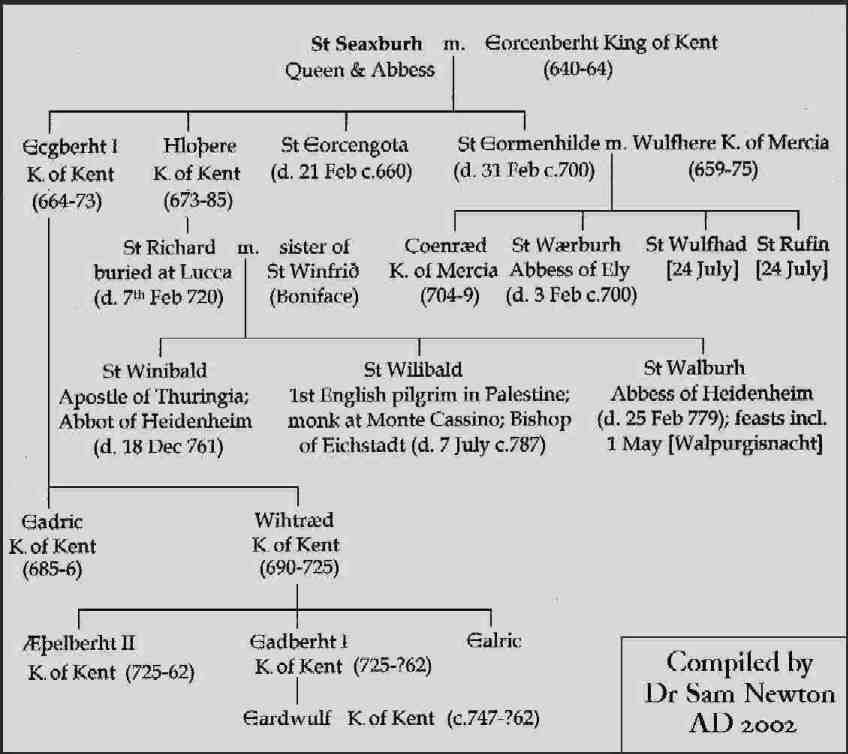
Although subsequent genealogical relations are uncertain, St Seaxburh’s line may have continued through to
Ecgberht II of Kent, who ruled c.765-84, and Ealhmund, king of Kent c.785. The latter was
the father of Ecgberht, king of Wessex (802-839), grandfather of Ælfred the Great. This would mean that
Seaxburh would embody a genealogical link between the Wuffings and the West Saxon
dynasty, from whom our present royal family is descended. For a discussion of other possible connections between the Wuffings and the West Saxon kings in the ninth century, see Chapter Six of my book on
Beowulf.
During her time in Kent, Seaxburh became founding Abbess of Minster on Sheppey, Kent, the church of which still bears her dedication. In 679 she succeeded her sister Æthelthryth as Abbess of Ely. Bede relates that here she directed the translation of the body of Æthelthryth into a white marble sarcophogas obtained from the ruined Roman city of nearby Grantchester (Cambridge) which she enshrined at Ely (HE IV, 19)
Seaxburh passed away by about 700 [6th July] and was entombed close to her sister at Ely.
Further Reading
D.H.Farmer, The Oxford Dictionary of Saints (Oxford 1978)
D.P.Kirby, The Earliest English Kings (London 1991, 2000)
Barbara Yorke, Kings and Kingdoms of Early Anglo-Saxon England (London 1990)
Kingdom of Kent - (Cent in Old English, Cantia regnum in Latin) was a Jutish colony and later independent kingdom in what is now south east England. It was founded at an unknown date in the 5th century by Jutes, members of a Germanic people from continental Europe, some of whom settled in Britain after the withdrawal of the Romans. It was one of the seven traditional kingdoms of the so-called Anglo-Saxon heptarchy, but it lost its independence in the 8th century, when it became a sub-kingdom of Mercia. In the 9th century, it became a sub-kingdom of Wessex, and in the 10th century, it became part of the unified Kingdom of England which was created under the leadership of Wessex. Its name has been carried forward ever since as the county of Kent.
Saxon Shore - Two interpretations were put forward as to the meaning of the adjective "Saxon": either a shore attacked by Saxons, or a shore settled by Saxons. The latter hypothesis receives at least partial support from archaeological finds, as Germanic-style artifacts have been found in burials, while the settlement of Saxons in large numbers in the area of SE England and the northern coasts of Gaul around Boulogne-sur-Mer and Bayeux is clearly attested from the middle of the 5th century onwards
Since we have established the early Utlagh's were resident's of Kent. I find this this - Cambridge (Ely) - Milton (Kent) connection interesting , also the comparison of Hagenild "mother of the Outlaw's to Seaxburh
A Milton Legend Saint Sexburga, Queen of Kent
There is a legend attached to Milton parish church that in AD 680, Queen Sexburga died at the door of the church. Early records of Ely cathedral, now held at Cambridge University, have confirmed this to be so, but for the mostpart, modern historians generally accept and agree that Sexburga actually died at Ely in AD 699. The legend is compounded by at least five different authoritative historians so how could they have got it so wrong and who was Queen Sexburga?
“Sexburga gave her life at Milton church”,
you can see how the wrong meaning was applied. Over a period of 1300 years it
could have easily been changed to “Sexburga died at Milton church”.
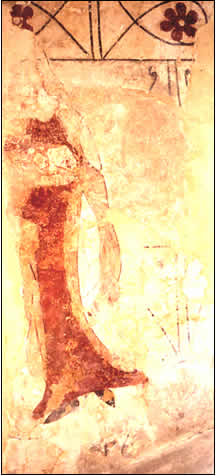 Saint Sexburga, Queen of Kent
Saint Sexburga, Queen of Kent
Thought to be the only pictorial representation of her, this painting is on a wall of
Willingham Church, Ely,
Cambridgeshire. She is shown here carrying a book and wearing a veil. It is thought that she has been depicted here as
she was Ethelredas Sister and successor as Abbess to Ely Monastery.
Some similar wall paintings have been found at Milton, did one of them once show Sexburga too?
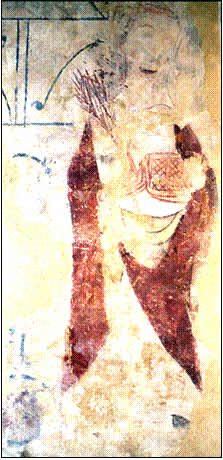 Saint Ethelreda, Sister of Sexburga
- Taken from a painting on the opposite wall to Sexburga in Willingham
Church. Ethelreda (or possibly Aethelthryth) married twice but remained chaste and founded a double monastery at Ely in 673. She was a victim of Plague, her doctor removed a tumour in her neck but to no avail. 17 years later her body was examined and found to be uncorrupted and the neck wound completely healed. It was for this that she was made a saint not, strangely, her founding of the monastery.
Saint Ethelreda, Sister of Sexburga
- Taken from a painting on the opposite wall to Sexburga in Willingham
Church. Ethelreda (or possibly Aethelthryth) married twice but remained chaste and founded a double monastery at Ely in 673. She was a victim of Plague, her doctor removed a tumour in her neck but to no avail. 17 years later her body was examined and found to be uncorrupted and the neck wound completely healed. It was for this that she was made a saint not, strangely, her founding of the monastery.
Willingham Church, Ely, Cambridgeshire -
The oldest paintings of all are in the south aisle, up at the west end. Here we see one of the few features that reveal the true age of the building – surrounded by big Decorated and Perpendicular windows, flooding the aisle with light, there is a much older lancet. It sits in a very deep recess, the sides of which are decorated with paintings. There are two layers. The oldest, on the left, is thirteenth-century, and depicts relatively plain floral motifs. On the right, probably also thirteenth-century, are two female saints in conversation. These are St Etheldreda (or Aethelthryth, or Audrey), and her sister St Sexburga (or Seaxburh), two pious princesses, patrons of Ely and of Cambridge respectively. Theirs was an interesting story, though a bit involved: you may want to skip the next few paragraphs if you’re not interested in Anglo-Saxon political and religious history.
They were born in the seventh century, two of the five daughters of King Anna of the Wuffings - the royal family of East Anglia. Anna himself was the nephew of the famous King Raedwald, who had ruled for twenty years not only as king of East Anglia but also as Bretwalda, which is to say roughly an overlord over a large part of the Anglo-Saxon kingdoms of England. Raedwald himself was a pagan – indeed, the marvellous ship burial at Sutton Hoo in the Deben Estuary in Suffolk is sometimes said to be his – but Anna was a Christian, possible even converted by St Felix while he was involved in missionary work at Dunwich (on the Suffolk coast) and Soham (then an island in the fens, west of the boundary of Anna’s kingdom). He acted as an important patron of early Christianity, helping St Felix, granting land to St Botolph for his monastery at Icanho (probably Iken in the estuary of the Alde), and hosting St Hilda for a year while she was visiting her sister at his court.
It sounds like Anna was an astute political operator. He used Northumbrian backing to seize East Anglia back from Mercian control, and then exploited the mutable balances of powers between the three principal Anglo-Saxon kingdoms to maintain some measure of independence for the small kingdom of East Anglia. This was always a difficult balance, and alliances with Northumbria and Wessex could not in the end save him from the fearsome (and resolutely pagan) King Penda of Mercia. In 651 Penda attacked him at the rich monastery of Cnobheresburg (probably Burgh Castle in south-eastern Norfolk), and while Anna held on long enough to allow the monks to escape, he was eventually defeated and fled to exile in Shropshire. In 653 he returned, but was defeated and killed, along with his son Eormin, in a great battle with Penda in Suffolk.
Anna had five daughters, several of whom were
important political and religious figures in their own right, and all of whom
were canonised (at least partially through successful lobbying by the family).
The most famous was Etheldreda, born in about 632 at Exning on the
Suffolk border. She was first married in 652 to Tondberct, a minor prince of the
fens, enabling her father to extend his kingdom westwards beyond the Devil’s
Dyke to include the territory around Ely. After Tondberct’s death in 655 she
retreated to Ely for a while, but in 660 was sent to marry the key ally Ecgfrith
of Northumbria. This was not an especially successful marriage. Etheldreda had
supposedly remained a virgin throughout her marriage to Tondberct, and wanted to
do the same with Ecgfrith, to this end she became a nun shortly after the
marriage. Her new husband wasn’t keen on this idea, first trying to bribe
Archbishop Wilfred of York to persuade her to yield, and thereafter trying to
take Etheldreda from her cloister by force. She evaded him and fled back to Ely,
where in 673 she founded the great monastery. (Ecgfrith, meanwhile, remarried
and spent several years arguing with Wilfred to distract him from his
disappointment). She died in around 679.
The other princess in this painting was the eldest sister, Sexburga (or
Seaxburh). In 640 she was sent by Anna to marry Eorcenberht of Kent, and
lived happily with him until his death in 664. She then ruled as regent for a
little while, during the minority of their eldest son Ecgberht. Retreating from
high politics she founded a monastery at Minster-in-Sheppey eventually leaving
to join Etheldreda in Ely, succeeding her as Abbess and ruling until her death
in 699.
The two least interesting sisters were Ethelburga (or Aethelburg) and Sethrida (or Saethryth). They didn’t marry any kings, instead becoming nuns at the Abbey of Fairmoutiers in the French region of Brie, which had just been founded by Saint Burgundofara. First Sethrida, and then Ethelburga, succeeded Burgundofara as abbess, the latter eventually dying in 664.
The youngest sister was Withburga or Wihtburga, born in the years just before Anna’s death at Bulcamp. She founded a convent at East Dereham in Norfolk, and – presumably much to her sisters’ annoyance – enjoyed the most successful crop of miracles of the lot, including the gift from the Virgin Mary of a pair of does who provided milk for her workers. She eventually died in 743 and was buried first in the cemetery, and then – after fifty-five years, in which her body had (predictably) not decayed at all – in a fine tomb in the abbey church. This made Dereham something of a centre of pilgrimage, and prompted some envy from other religious establishments in the area. In 974, Abbot Brithnoth of Ely decided to steal her relics so as to add to the stock of holiness (and, presumably, also augment the revenues) at Ely. The story goes that Brithnoth and some confederates visited Dereham and organised a feast, getting the locals drunk and then stealing Withburga’s body. The Dereham party woke and discovered this, and chased the Brithnoth and his party. There was something of a fight, but the Ely group got away, and Withburga was interred with her sisters in the great Fenland monastery. Dereham had to be content with a spring which appeared in Withburga’s tomb, though in later years that proved to be as miraculous and remunerative as the original relics had been.
Ely definitely benefited from the theft, though, and was throughout the Middle Ages an important centre of pilgrimage. Since one of the old routes to Ely passed through Willingham, lots of pilgrims presumably stopped off at the church here: I wonder whether Etheldreda and Sexburga approved of their successor’s ill-treatment of their sister’s remains.
Æthelwold of East Anglia - The region of East Anglia around Rendlesham, the royal dwelling of the Wuffingas, evidently enjoyed royal patronage: the cemetery at Sutton Hoo, the monastery at Iken, the East Anglian see at Dommoc and the emerging port of Ipswich all being in the vicinity of Æthelwold's seat of power. Remarkably, when Swithelm of Essex was persuaded to adopt Christianity and was baptised, not in Essex, but at Rendlesham, with Æthelwold present as his sponsor.
Rendlesham Site of the Hall of the Wuffing Kings - St Gregory’s Church at Rendlesham is a good place to consider some of the current evidence for the site of the Wuffing royal hall and church at Rendlesham. Bede tells us that the East Saxon king Swiðhelm was baptised there by St Cedd, with Rædwald’s nephew King Æþelwald standing as his godfather, around the year 660 (Historia Ecclesiastica, III, 22).
Rendlesham, Suffolk - near Woodbridge, Suffolk was a royal centre of authority for the king of the East Saxons, of the Wuffinga line; the proximity of the Sutton Hoo ship burial may indicate a connection between Sutton Hoo and the East Saxon royal house. Swithhelm, son of Seaxbald, who reigned from 660 to around 664, was baptised at Rendlesham by Saint Cedd with King Aethelwald of East Anglia acting as his godfather. He died around the time of the great plague of 664 and may have been buried at the palace of Rendlesham.
Its name is recorded in Anglo-Saxon about 730 AD as Rendlæsham, which may mean "Homestead belonging to [a man named] Rendel", or it may come from a theorized Anglo-Saxon word *rendel = "little shore".
More recently Rendlesham was the site of the Rendlesham Forest Incident, a series of reported sightings of unexplained lights and objects in the sky in December 1980.
1169 - Bromholm Priory - House of Glanville - Charter of Bartholomew de Glanville To Bromholme Priory - Walteri Utlage - Et duas partes decimarum meorum hominum: scilicet avunculi mei Rogeri de Bertuna: Et Galfridi presbiteri de Honinges: et Turstani despensatoris: et Warini de Torp: Et Ricardi Hurel: et Walteri Utlage: et Roberti de Buskevill: et decimam totam Ricardi filii Ketel. - An Essay Towards a Topographical History of the County of Norfolk: Tunstede ... By Francis Blomefield, Charles Parkin
Ricardi Hurel - Richard Hurel
1144 - Order of Citeaux - Cistercians - it had four benefactors Richard Hurel and his sons - Notre Dame de la Trappe - Trappists
The Knights Templar are known to history as the warrior monks, but what is not as commonly known is the kinship the Order shared with the Cistercians, the true and original white-mantled monks.
On March 21st, 1098 just a year before the Crusaders would storm over the wall of Jerusalem, a Benedictine monk by the name of Robert of Molesme led twenty-one of his followers to the inhospitable brush and mud of Citeaux where he would set up a new abbey.
The reasoning behind the move was that Robert was fed up with how the Benedictines were not observing the rule of St. Benedict, which the Templar Rule of Order would latterly be based upon. He believed that by setting up in a secluded wilderness he could begin with a fresh slate so to speak. The monks of his former abbey at Molesme were unhappy with his departure and begged the Pope to make him return which he did, being replaced at Citeaux by Alberic.
Many claim it was Alberic who is responsible for the White Mantle of the Cistercians, but it is more likely to have been his successor, the English Abbott Stephen Harding. Whether Harding is responsible for the white robes that would ultimately distinguish the Cistercians and latterly the Templars form all other monastic institutions or not is of little importance. Harding’s most notable contribution to the cause came when he accepted a young man from Fontaines named Bernard who came to the abbey with thirty of his relatives seeking membership in the order.
Bernard would soon rise in the eyes of the order of monasticism and soon set up his own abbey at Clairvaux. The land was, like so many of the Cistercian abbeys that followed granted by Burgundian Nobles. In fact no less a noble than Hugh Count of Champagne, who would eventually become a member of the Templars.
The young Abbott Bernard was instrumental in not only in preparing the rule of order for this new order of knighthood, but also through his letter to friend Hugues de Payens, propelling the order to incredible heights as we examine in another section of this web site.
Almost in unison with the Templars, the Cistercians grew in wealth. Like the Templars the Cistercian order was free of taxes and tithes and were expert at all manner of farming, industry and commerce. Lead for the Abbey roofs were mined in their own mines and smelted in their own facilities.
It is a shame that these roofs do not exist today in England as Henry VIII had them all melted down for his own usage many years later.
The construction of the Abbeys is a marvel to behold, for in a day when fresh water was a concern, the Cistercians had plenty. They always sought out locations that were secluded and on a running river or stream. The monks would dam sections to create enough flow to carry water to every portion of the Abbey. Water would flow through kitchens, to basins for washing and they even had indoor plumbing where waste would drop into the river and be carried away from the Abbey. But as complex as their system of water and waste management was, the order was simple to the core when it came to ornamentation. In a day when their Benedictine rivals had altars and candles of gold, the Cistercians opted for plain cloth on the altar and a simple wooden Cross on it. No gold of any kind was found in the Abbey although the order soon grew rich enough to have all they wanted.
So rich were the Cistercians that they gave a year’s supply of wool as a means to finance the ransom of King Richard I, who was captive in Germany.
The connection with the Templars is not merely one of coincidence.
The very rule of the Templar order held this monastic institution in highest regard and there is no doubt of the many cooperative ventures between the two. For example, if a knight was expelled from the order, he did not merely rejoin a secular life. The knight was required to seek shelter in a Cistercian monastery in the hopes that he could be rehabilitated. In fact one Templar Master who quit the order sought shelter in the cloisters of the Cistercians and lived out the balance of his life there.
This research has been moved to Early Outlaw's in Kent - Follow this link for detail
1194 - Jordan Utlag, Richard Uthlag and William Utlag - Rotuli curiæ regis - Sixth year of King Richard I - 1194, 18-20 Nov - 6 Ric. I
Index - Page 57, 58 - Jordan Utlag, Richard Utlag ( Ric. Uthlag ), William Utlag
....
| - - - - - -
Unfortunately , I can't get a good translation from the translation software...
Maud Godfrey , Adam the Deacon, Richard Utlag, Land of Niwent, Julian saw the wife of Ham, Jordan Utlag, William de Tid . (Utlag ? as indicated by the INDEX) Notice that they use of capital letters for reference to the Utlag's
What is interesting is that it refers to the "Region of Niwent"- although from what has been found, this is most likely Newington, Kent
[ ...
(but, it could also be another Newington in Gloucester (Not likely) ...since there is a mention of Gilb le Berkier which could be Gilbert le Berkeley) like:
Maud
de Landa, widow, and Kingswood Abbey. - [3 May] 1212
Maud has leased to the abbey, for 13 years, all her lands, men and rents in Niwent'
and in Dureslega, at a rent of 2 marks a year.
Witnesses: Philip de Berkelai, Thomas parson of Niwentun, William
de Scai, Adam his son, Peter de Upthrop, Adam de Scai, Nicholas de King', Thomas
de Planca, Adam Loch, William Trussi, Robert de Landa, John brother of Maud.
Kingswood, Gloucestershire - is a village and civil
parish within the Stroud
district of Gloucestershire,
England
Kingswood Abbey was a Cistercian abbey, located on the NE edge village. The abbey was founded in the year 1169 by William of Berkeley in accordance with the wishes of his uncle, Roger II of ; Berkeley, and colonised from the Cistercian house at Tintern.[3] All that survives today is the 16th century gatehouse, which is under the care of English Heritage.ikipedia, the free encyclopedia
Bagpath - Newington Bagpath is a hamlet in Gloucestershire, England, set in the Ozleworth valley, near the village of Kingscote and forms part of its Civil Parish. The hamlet consists of two separate settlements of Bagpath and Newington Bagpath, although residents of both frequently refer to both as 'Bagpath'.
The parish Church of St Bartholomew was united with the neighbouring parish of Owlpen from medieval times to the late 19th century
Owlpen - is a small village and civil parish in the Stroud district of Gloucestershire, England, set in a picturesque valley in the Cotswold hills. It is about one mile east of Uley, and three miles east of Dursley.
The principal feature of the village is the famous Tudor manor house, Owlpen Manor, of the Mander family. The main economic activities in the village are agriculture, forestry and tourism... Owlpen (pronounced locally "Ole-pen") derives its name, it is thought, from the Saxon thegn, Olla, who first set up his pen, or enclosure, by the springs that rise under the foundations of the manor, about the ninth century
There are records of the de Olepenne family (who must have named themselves after the place) settled at Owlpen by 1174. They were local landowners, benefactors to abbeys and hospitals, and henchmen to their feudal overlords, the Berkeleys of Berkeley Castle, whose wills and charters they regularly attest as their attorneys and witnesses.
Records
of the Anglo-Norman house of Glanville from A.D. 1050 to 1880 ... By William
Urmston Searle Glanville Richards
At
Orford, twenty miles from Ipswich, there was a royal castle in the
time of Henry III., who granted a charter to the town, which was previously a
borough by prescription; it is now a mere village. Only the keep of the castle
remains; it is a polygon of eighteen sides, with walls ninety feet high, and has
square towers in its circuit, which overtop the rest of the building; the
architecture is Norman, and it was erected by Glanville; [fn 14] and
in the year 1167, when he [Bartholomew de Glanville]
was residing there, the fishermen took in their
nets a wild man, having the human shape complete, with hair on his head and a
long and sharp beard and a large amount of shaggy hair on his breasts. The
fishermen were not able to keep him long, as he stole away to sea privately, and
was never seen afterwards. [fn 15]
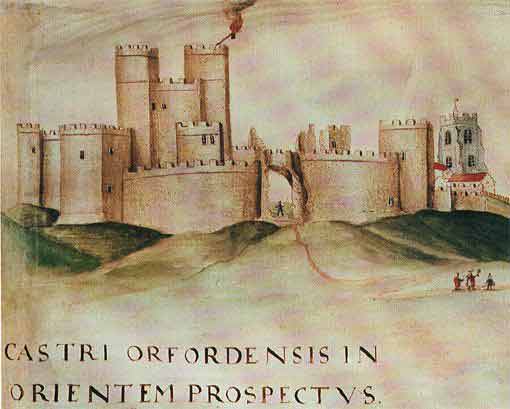 Orford-Castle
- The small Suffolk town of Orford at the time of the Domesday book was only a small hamlet. Less than one hundred years later it was
transformed by Henry II into a busy port with a magnificent castle to guard
it. The area before the castle was built was dominated by the Bigod family from their castle at Framlingham. Hugh Bigod, Earl of Norfolk was one of a band of dissenting Barons in the reigns of Stephen and Henry II. Henry was keen to regain his authority in the region, and the Bigods were a threat to this which needed to be countered, there was also the threat of a foreign invasion.
Work begun on the castle at Orford in 1165 and Henry also drained the marshes around the area which in turn utilised the coastal geography, turning Orford into a newer sheltered port. There had been a market at Orford since 1105 and this helped to consolodate and build the local economy along with the port and castle. The building of the town church also begun at the same time as the castle. Orford's future looked suddenly secure.
- One of the first constables of Orford , Bartholomew de Glanville, was a
local man who took up his post in 1167
Orford-Castle
- The small Suffolk town of Orford at the time of the Domesday book was only a small hamlet. Less than one hundred years later it was
transformed by Henry II into a busy port with a magnificent castle to guard
it. The area before the castle was built was dominated by the Bigod family from their castle at Framlingham. Hugh Bigod, Earl of Norfolk was one of a band of dissenting Barons in the reigns of Stephen and Henry II. Henry was keen to regain his authority in the region, and the Bigods were a threat to this which needed to be countered, there was also the threat of a foreign invasion.
Work begun on the castle at Orford in 1165 and Henry also drained the marshes around the area which in turn utilised the coastal geography, turning Orford into a newer sheltered port. There had been a market at Orford since 1105 and this helped to consolodate and build the local economy along with the port and castle. The building of the town church also begun at the same time as the castle. Orford's future looked suddenly secure.
- One of the first constables of Orford , Bartholomew de Glanville, was a
local man who took up his post in 1167
Are you an Outlaw male ? Are you left handed? Send me an email
Alexander the Great (king, conqueror, military leader)
Charles (prince of Wales)
Charlemagne (Karel de Grote) (king)
English Royal lefties:
Elizabeth II (queen)
Elizabeth (Queen Mother) (queen-mother)
William (British prince)
Julius Caesar (ruler)
Louis XVI (king)
Ramses II (pharaoh)
Found more information - Matheas- Matthew Outlawe Lakenheath Suffolk:
1311 - Commission of oyer and terminer to William de Ormeaby, Williiam de Colneye, John de Peyton and William de Goldyngton, on complaint by Gilbert de Clare, earl of Gloucester and Herford, that John prior of Ely, Ralph de Derby, William de Lenghare, William de Denton, Matheas Outlawe, Nicolas le Charetter, Nicolas Dykeman and William Benard, with others rescued Richard Bathman from the custody of his bailiff, John Donne, who had arrested him for the larceny of an ox in the earl's moiety of the town of Lakingbethe, co. Suffolk, in which he had the liberty of 'infangenethef'. - Gilbert de Clare, 8th Earl of Gloucester - March 1311 he was appointed guardian of the realm while the king was still in Scotland. - Matheas OUTLAWE in connection with Lakinghethe (Lakenheath) Sfk. - Lakenheath
1314 - Matthew Outlawe of Lakenheath Suffolk - "borrowed" a cart for a visit to Ipswich - Case is record in the court Sept 1314
1326 - Suffolk manor of Lakenheath - Matthew Outlawe was said to owe half of the cost of trees needed to build a house - Matthew Outlawe of Lakenheath
found: KENT WILLS TO 1650
Owtelaw Thomas - Milton 1501pa
|R 6*.63 | m;
Outlaw John - Deptford
1639/40p |R 22.352 30 | shipwright
Found: 1360 - 1376 - Outlawe (Outelagh), Joan wife of John - Essex
Full text of Feet of fines for Essex. Edited by R.E.G. Kirk -
34 EDWARD III. - 1360 COUNTY OF ESSEX. .
1239. Quin. of Hil. William atte Wode of Crishale and Walter Pytee of Chisell, pl. John Outelagh and Joan his wife, def. 1 messuage and 1 carucate of land in Great Chisell, Little Chisell, Heyden and Crishale. Pl. and the heirs of William to hold of the chief lords. Cons 100 marks.
49 EDWARD III - 1376 - COUNTY OF ESSEX
1376- 1793. Mich, and Oct. of Hil. John Rydere, parson of Heyden. and Nicholas son of Hugh Parys of Heyden, pl. by John Heyden. William Manewod of Heyden and Alice his wife, def. 2 messuages, 2 tofts, 76 acres of land, 3 acres of wood and 2s. rent in Heyden, Cristeshale, Elmedon and Great Chyshull. Pl. and the heirs of Nicholas to hold a moiety of the chief lords, with the homages and services of John Upstret, Katharine Arneys, Richard Curteys and Joan Outlawe and their heirs, and also the remainder of the other moiety, which John atte More of Heyden holds for life by the law of England. Cons. 20 marks.
Outlawe (Outelagh), Joan wife of John, 127, 175.
, John, 127.
Elmedon = Elmdon
Great Chisell = Great Chishill
Little Chisell = Little Chishill
Crishale/Cristeshale = Chrishall - (pronounced krishul or krishawl) is a small village in the English county of Essex. It is located 20 kilometres (12 mi) south of Cambridge and lies equidistant [10 kilometres (6 mi)] between the two medieval market towns of Saffron Walden and Royston. Although in Essex, Chrishall lies close to its borders with Hertfordshire and Cambridgeshire and has a 'Hertfordshire' postcode (SG8).
The village was listed in the Domesday Book as Cristeshalla, or "nook of land dedicated to Christ". It is one of only two English settlements whose name contains the word "Christ". The Icknield Way, a Neolithic track, passes through the parish.
Chrishall's location is key to its character; as the village sits at the highest point in Essex, at 147 metres (482 ft) above sea level, road construction has avoided this high ground and therefore Chrishall is off the beaten track...Chrishall's population has remained largely unchanged over the last 170 years. In 1841 it totalled 518 and today about 450 people live in the village... The village has been home to a church for over a thousand years. Prior to the Norman invasion a small church dedicated to the Virgin Mary was situated on the site of the present church...The church contains a number of brasses, including a notable one in memory of Sir John de la Pole and his wife, dating from 1380...Chrishall was given to Eustace of Boulogne who built and occupied a house on a hill to the south of the current church. He named the house "Flanders" and it was there that his daughter Matilda of Boulogne, later wife of King Stephen was raised.
Elmdon - is a village in the Uttlesford district of Essex, England, near the boundary with Cambridgeshire and Hertfordshire. The undulating nature of the local topography differentiates it from countryside to the north which is predominantly fenland and flat. The name means 'hill of elms' and this village homes the only three elm trees in Essex.
Melbourn Rural District - The three parishes historically in Essex (Heydon, Great Chishill and Little Chishill) were part of Melbourn RD
Great Chishill - The Domesday Book of 1086 refers to Cishella which was held by Ulfeih, a freeman, and Little Cishella which was held by Sired, a freeman. William the Conqueror bestowed Cishella to Henry de Farers and Little Cishella to Count Eustace of Boulogne.
Great Chishill was divided into five manors , the Manor of Cardens, alias Bassets Hall, the Manor of Belknaps, the Manor of Tewes alias Lisles, the Manor of Friers alias Chishall-Grange and the Manor of Chishall alias Over Chishall-Hall.... St. Swithun’s Church, situated on high ground at the crossroads was founded in 1136 by Geffrey de Magnaville under the Monastery of (Saffron) Walden.
1372 - Chishall - It was holden in 1372 by William Cardon, under Geofrey de Magnaville; and under Humphrey de Bohun, earl of Hereford and Essex, by the heirs of ... John Outlaw
http://archive.org/stream/historytopograph02wrig/historytopograph02wrig_djvu.txt
190 HISTORY OF ESSEX.
Hundred of Uttlesford
CHISHALL.
A district at the extremity of the hundred and county, divided into two parishes,
Chishall. bears the names of Chishall, Great and Little; in Domesday, written
Cishel.
...
In the reign of Edward the confessor, the lands of Great Chishall belonged to six freemen, one of whom was named Ulfith ; and to Edric, and Lewin ; at the survey
they had been granted by the Conqueror to Geofrey de Magnaville, and Roger Otburville. There have been
five manors, or reputed manors, in this parish.
The families of Cardon and Basset gave occasion for the names applied to a manor Hall. in this parish, which was also named Wandens;
it was holden in 1372 by William Cardon, under Geofrey de Magnaville; and under Humphrey de Bohun, earl of Hereford and Essex,
by the heirs of John Depham, John Outlaw, Nicholas Jobyn, with several others ; and also the abbots of Walden and Tiltey : it consisted of two knights' fees.
Found more: Search The National Archives_Outlawe
1418/19 - Robertson
of Richard Outlawe appoints Richard Reed and Thomas Fullere to deliver
seisin to Geoffrey Stonham of Bertonbendyche of 3 acres of land in Fyncham
- 6 Hen V - 14 March 1418/19 - Norfolk Record Office
1420 - Lease
for life of 2 - Johanna Outlawe widow of John Outlawe sen. peautner (sic)
Premises: parcel of land in churchyard 30ft long and 14ft broad which John
Outlawe held - 8 Hy.V (1420) 12 May - Bristol Record Office
1433 - Confirmation of Grant: John Akeman of Clenchwardton, chaplain, to Wm. Herford, Wm. Pye, butcher, burgesses of Lenn Episcopus, Henry Outlawe of Westlenn and Thos. Dekone of Clenchwardton: 2 half acres of land in CLENCHWARDTON, one of which lately purchased of Agnes Theversham and Katherine her sister deceased, lie between the land of Thos. Bellezet', burgess of Lenn Episcopus, on the west and the land of the heir of Jas. Akeman by villeinage and payment of Kenewyk on the east, and extends in length from the land of said Thos. to the north as far as the common way to the south, and the other half acre lies in the same place between the land of Thos. Jekkysson, chaplain, on the east and the said villein-held land or property of Kenewyk on the west, and extends in length from the land of said Thos. to the north as far as the common way to the south: to hold of chief lords: warranty and sealing clauses: given at Clenchwardton: witn: John Bataill the elder; Roger Bataill; John Sutton the younger; Henry Sutton, his brother; Thos. Bataill; Henry Wrych; Henry Akeman - 11 Hen. VI - Leicestershire, Leicester and Rutland Record Office - Clenchwarton - Norfolk Churches - St Margaret Clenchwarton
Here, Evidently there was some trouble between the Woodhouse's and King's Lynn and The Outlawe's - a star chamber was a serious situation and notice this happens when QEI makes her trip thru Norfolk in 1578 and stays with the WoodHouse family at Kimberley and Henry's the Vice Admiral and he and brother Roger are Knighted and all. Oh and Sir Ralph Shelton the High Sheriff of Norfolk is their Brother-in-Law (he's married to Mary WODEHOUSE ) So don't mess with the Queen's favorites!
I love the bit for their "Stubborn answers" a 100 pound fine! The Mayor loses his job and I am assuming one of the "aldermen" might have included an Outlawe. I don't know which one yet.
There seems no record of Outlawe's in King Lynn for that time period . There was a Ralph Outlawe at Little Witchingham in the time period but that's quite a way from "Bishops Lenn ":
1552 - Bargain
and sale, Henry Rychers of Swannington, gent., to Robert his brother: manor
called Turtevilles in Witchingham St Faith and all messuages, lands etc., in
Witchingham St Faith, Witchingham St Mary, Alderford - lease of 20 years to
Raffe Owtlawe, and said manor acquitted of title
of dower of Elizabeth, wife of grantor
1590-1592 - Outlawe,
Ralph, of Little Witchingham - Will.
It is interesting also that the Shelton's are connected to the Virginia Company ...
1578 - Queen
Elizabeth I journeys to and from Norfolk in 1578 - Roger Wodehouse
and his wife Mary Corbet were hosts to Queen Elizabeth I at their
fortified and moated house, Kimberly Tower
1578 - Henry
Woodhouse - Roger Woodhouse made Knights by the queen
1578-1579 - Woodhouse
v. Outlawe -
Court of Star Chamber: Proceedings, Elizabeth I - 21 Eliz - So was
an Outlawe an Alderman of Lynn at the time?
1578
- The Star chamber, notices of the court and its proceedings, with a few ... By John Southerden Burn
History of the borough of King's Lynn Hillen, Henry J Free Download & Streaming Internet Archive
September 1576 - communication from the Privy Council was addressed to " the Mayor (Christopher Graunt) and his brethren"- ...Some, to whom the election apperteyned, had not so good consideracion as they shold have had ; but without regarding their Lordships advice [they had] made choice of one that had lately been noted before them in the Sterre (Star) Chamber, for some undutifull misdemeanours within that towne much to their sclaunder... The "better choice" refers to the recent election of Gregory Baker on the 29th of August, who was to succeed Christopher Graunt on the 29th of the next month
THE QUEEN IN NORFOLK.
The Queen made several provincial tours. She visited Suffolk (July 1561) and Norfolk (August
1578), when her "progresses" were
unusually extended. At the end of July 1578 she stayed at Long Melford and Hawsted; on the 7th of August her Majesty entered
Bury St. Edmunds, and Euston on the 10th. Great preparations were made at Norwich for her reception, and workmen were brought
from Lynn and Yarmouth to assist. Thomas Churchyard, in the service of Henry Howard, Earl of Surrey, was for three weeks busily
engaged arranging the masques, ceremonies, and festivities. ...
1600 - Robert
Bulwer of Wood Dalling, Norfolk, gentleman and Humphrey Levett of Swaffham
Market, Norfolk, gentleman v Thomas Gybson of Thorpe, Norfolk, gentleman and Thomas
Outlawe of Norwich, Norfolk, broker. Defrauding of first plaintiff over a
loan; common law suit for debt against both plaintiffs.
1617 - Indenture
of convenant to levy a fine relating to lands in Burnby -
Witnesses: Henry Outlawe, Desmond Fortescue, Robert Scruton - 22
Jul 1617 - East Riding of Yorkshire Archives and Records Service
The Shelton Family - Father of Sir Ralph Shelton, Sir Ralph Shelton, Knighted by Elizabeth I. Sir Ralph SHELTON was the 23rd Lord of Shelton. He was High Sheriff of Norfolk in 1571 and was Knighted by Queen Elizabeth at Norwich, 22 Aug 1578 and Knight of the Garter. "The Sheltons Lineal Descendants from Ancient...", by Kathryn Morris Brown, p 31 says "He was the high sheriff of Norfolk in 1571 and Knight of the Garter. He was knighted Queen Elizabeth in 1578. In the Shelton family church, the tomb of ten panels on the left side of the altar is the record of his marriage to Mary WODEHOUSE and the birth of their children: Margaret, Thomas, John, Ralphe, and Edward. Sir Ralph was living in Warwickshire in the late 1500's. At the time of this death he owned Shelton Overhall in Shelton and Shelton Netherhall and diverse lands in Norfolk; Barrett in Hardwicke; Snoring 2, Magna and Parva; Thursford 2, Magna and Parva and Barret's held by the Earl of Arundel. He named son Thomas, Prother of the Tower of London, as his heir." Pages 33-8 lists three children of Sir Ralph SHELTON and Anne BARROW: Andrew, William, and Henry and lists their descendants. Mary WODEHOUSE (Wife) Marriage: 15 SEP 1551 in SHELTON, Norfolk, England
Father of James, Sir Ralph Shelton 1560-1628, Knighted 1607 by James I, married 1607 to Jane West (Jane West is a descendant of King Edward I and Charlemagne) . He was Knighted at Theobald, Warwickshire in 1607. He was a member of Parliment in 1611; Minister to Spain; Secretary to the Prince of Wales; of the London Company for settlement of Virginia. Sir Ralph never came to America. He was killed at the Battle of Isel de Rhe, in the war with France, two miles off the coast near LaRochelle where the Huguenots were under seige by the French Catholics. Birth date given by Kathryn M Brown from a record in the Shelton Family Church, in the book "The Sheltons", p 31. Page 39. Page 39 says he was a member of the Second and Third London Companies. In all the Colonial records of the Second Charter granted to the London Companies, 23 May 1609, the names of Sir Ralph SHELTON of Norfolk, England, a Captain SHELTON and a James SHELTON, Gentleman, appear. The Second London Company sailed under Lord De La Ware with nine ships and 500 people. The Admiral's ship was named "Sea Venture". They landed in America in 1610
Father of Jane West, her dad: William West 1520-1595 married to
Elizabeth Strange....
George West, born in 1490-1510--- Queen Elizabeth re-created the de la
Warr title, so he is known as the first Baron de la Warr of the second creation.
He died in December 1595 at Wherwell in Northamptonshire. He and Elizabeth had
four children: Thomas, the heir; Elizabeth, married Richard Blount;
Jane, married Sir Thomas Wenman, James Cressus, Thomas Tasburgh, and Sir Ralph
Shelton; and Mary, married her sister's widower Richard Blount.
Elizabeth Strange died sometime in the 1560s, and William married Anne Swift. As
a widow she was married again,to Thomas Oliver.
Oh and we need to keep in mind that the Shelton's were QEI's guardian's in those troubled years:
John SHELTON (Sir Knight) - In Apr 1533, Anne Boleyn, daughter of Sir John Shelton’s brother-in-law, was crowned as Queen of England, and it is certain that her Shelton relations would have attended, and Margaret (called “Madge”) Shelton, daughter of Sir John Shelton and Anne Boleyn, personally attended the Queen. Sir John Shelton and his wife were appointed governors of the household of Princess Elizabeth. Anne Shelton became the governess of Princess Mary, the daughter of Henry VIII first wife, Catalina of Aragon. Mary and Elizabeth remained in the Sheltons' care until at least fall of 1536.
Anne Shelton (courtier) - Anne Shelton nee Boleyn (28 November 1475 – 6 January 1555) was a member of the Boleyn family, which enjoyed considerable influence during the reign of King Henry VIII of England. She was the elder sister of Thomas Boleyn, 1st Earl of Wiltshire, and an aunt of his daughter Anne Boleyn, the second wife of Henry VIII....She was married to John Shelton, by whom she had nine children, including the courtiers Margaret and Mary Shelton. From 1533, she and her husband were in charge of the households of the King's two daughters, Princess Mary and Princess Elizabeth.... Anne was born at Blickling, Norfolk to Sir William Boleyn and Lady Margaret Butler...When Princess Elizabeth was so persecuted during her [sister Queen Mary's] reign she fled to Sir John [21st Lord of Shelton] and Lady Shelton for protection. She was later secreted in the tower of Shelton Church when Sir John's mansion was not sufficient protection. When Elizabeth was crowned she summoned Sir John's family to the Palace where his descendants lived during her reign."
| Margaret | unknown | bef.11 Sep 1583 | married Thomas Wodehouse (or Woodhouse) |
| Ralph | unknown | 26 Sep 1561 | married Amy Wodehouse or Woodhouse (sister of Thomas, who married Margaret Shelton |
Earl De La Warr - In the United States, Thomas West, 3rd (or 12th) baron is often named in history books simply as Lord Delaware. He served as governor of the Jamestown Colony, and the Delaware Bay was named after him
Isabella P. Writes to me ( and thank you very much) some new information:
I was doing a bit of research about the village of Bourn in Cambridgeshire,
UK, and came across a John Outlawe who was there in
the 1300s.
He was working for the monks of Ramsey Abbey I believe at their manor
there. He's talked of in a book called "Medieval Bourn: A Cambridgeshire
Village in the Later Middle Ages" by David Baxter, published by Mission
Computers, Cambridge, 2008.
So it would be interesting to know exactly the dates involved with Ramsey Abbey/Manor...
Ramsey Abbey - Huntingdonshire , England, was founded by Ailwine (Ethelwine, Egelwine), a Saxon noble, in 969
1002 - The body of St. Ives (Ivo) was miraculously discovered in the neighbourhood and this led to the establishment of the dependent priory of St. Ives. Another dependent priory or cell was Modney, in Norfolk. The abbot had a seat in Parliament and ranked next after Glastonbury and St. Alban's
1130 - The
Round Church of Cambridge was built in about 1130 and was
originally a wayfarers' chapel - but soon became a parish church, served by
the Austin Friars from the nearby Hospital of St. John (now St. John's College)
1143-1144 - Geoffrey
de Mandeville, 1st Earl of Essex - Geoffrey maintained himself as an
Outlaw and a bandit in the fen-country,
using the Isle
of Ely and Ramsey
Abbey as his headquarters. He was besieged by King Stephen and met
his death in September 1144 in consequence of an arrow wound received in a
skirmish. Denied burial because he died excommunicate, his body was
wrapped in lead. Eventually it was taken to the Templar
community in London. He was buried in the Temple
Church in London. His son arranged for an effigy to be placed on the
floor, where it still can be seen today.
1169 - Preceptory
of Denny (Denny Abbey - Cambridgeshire) the site Waterbeach was handed to
the Knights
Templar
1230 - Alan le Utlage in the Tax Rolls 'Feet of Fines' for the county of Essex
This connects possibly to John de Bernewell "Outlawe" and the formation of "Guild of Corpus Christi"
There were a not just few John Outlawe s' in Cambridgeshire are in the
1300's see: Isle of Ely - Outlawe - Templar Priory
monks - Barnwell Priory
and Barnwell Priory -
Cambridgeshire - John Outlawe (de Bernewelle)
and it was interesting that I found that a John Outlawe was a BAILIFF for
Cambridge in 1327 - Documented!
John and Reginald Outlaw may have been brothers from Barnwell...
1303 - Michael
de Baskervile, Last Preceptor of the London Temple, 1310's - Michael de
Baskervile was recorded as the Preceptor (something like a chief administrator
and estate manager) of the New Temple of the Order of the Knights Templar in
Fleet Street, London in 1303 and again at the suppression of the Order in 1308.
1314 - John
Outlawe v. Henry le Pescour of
Cantebrigg' & Joan his wife in Gransete - Cambridge- EDWARD II. 79
1317 - Simon
de Everesdon and Margaret his wife v. John le Utlawe junior and Alice his
wife in Brunne - Cambridge * Edw II 83
(So there must have been a John Utlawe Senior)
1327 - Mayors and Bailiffs - Mayor Eudo de Helpringham - Bailiffs - John Outlawe, Alan de Badburgham - History of the town of Cambridge pg 138 - Edward III. (25 Jan. 1327) - Township and borough - History of Cambridge
1339 - The parson of the church of
Potton was robbed in 1339 of wheat, barley, beans, peas and other goods and
chattels to the value of forty marks by
William, son of William de Hurle of Potton, John Wymond of Potton and John
Lettice of Potton, The same William
de Hurle and another assaulted Reginald
Outlawe, parson of the church of Esthattelee
at Potton and wounded him, and William was presented as a
common assaulter and disturber of the peace. -
THE LANDS OF THE SCOTTISH KINGS IN ENGLAND - Potton
- Wikipedia
1340 - Presentation
of Reginald le Outlawe, parson of the church of Esthattele,
in the diocese of Ely, to the church, of Risshenden, in the
diocese of
Lincoln, in the king's gift by reason of the temporalities of the
priory of Lenton being in his hands, oni an exchange of benefices with Hugh
de Luffenham.
[ Esthattele is connected to Barnwell Abbey - St
Michaels Cambridge - St John's Hospital - John de Hattele
- Estenhale:
its eastern extremity towards Barnwell Priory was called Estenhale
Notice that Henry de Tangmere is associated with John Outlawe just prior to the Black Death and Henry's founding of the Guild of Corpus Christi.:
1347 - Grant
to Henry de Tangmere and John de Bernewell (Outlawe), burgesses,
of a messuage as in 58, 60, and 61. Messuage
- Buildings and land
1349 - The guild
of Corpus
Christi was founded in Cambridge
in 1349 by William Horwode, Henry
de Tangmere and John Hardy[4]
in response to the Black
Death.
Ramsey
Ramsey has an Interesting early connection to Saxon King Edgar and a "foster brother" Ailwyn and Ailwyn's younger brother Alfwold :
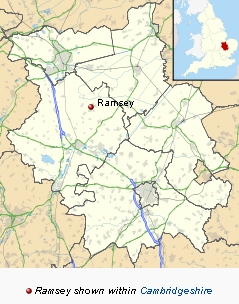 Ramsey, Cambridgeshire
- The town manor is built on the site of (and using materials from) the
ancient Ramsey Abbey,
and is the seat of the Lords
de Ramsey, one of the major landowners in Lincolnshire
and Cambridgeshire.
... The remains of the Abbey are now home to part of the town's secondary
school. Abbey
College, Ramsey resulted from the amalgamation of the previous two secondary
schools, Ailwyn School and Ramsey Abbey School ...
Ramsey, Cambridgeshire
- The town manor is built on the site of (and using materials from) the
ancient Ramsey Abbey,
and is the seat of the Lords
de Ramsey, one of the major landowners in Lincolnshire
and Cambridgeshire.
... The remains of the Abbey are now home to part of the town's secondary
school. Abbey
College, Ramsey resulted from the amalgamation of the previous two secondary
schools, Ailwyn School and Ramsey Abbey School ...
Early and Middle Saxon Ramsey remains elusive. For the later Saxon period, documentary evidence for the foundation of the tenth century Benedictine abbey at Ramsey has been recently substantiated by archaeological evidence for activity associated with the pre-Conquest monastery.
Tradition has it that Ailwyn, foster brother of King Edgar, founded a hermitage at Ramsey. It received a series of substantial grants of land by King Edgar who confirmed all the privileges in 975, ...
Graveley -
Manor and other estates British History Online - An estate at Graveley was among the four that
Athelstan Mannesson (d. 986) left to the newly founded Ramsey abbey after the death of his widow, (fn. 47) perhaps the 'matron' Leofgifu to whom the abbey later ascribed the gift. (fn. 48) In 1066 and 1086 Ramsey held all five hides in
Graveley ... Thereafter GRAVELEY remained a Ramsey demesne manor until the
Dissolution....
...
Ramsey abbey's manor house included by 1250 a hall and chamber, by 1300 also a kitchen and a chapel, (fn. 75) licensed in 1254. (fn. 76) The house probably stood within the 14-a. Home close (fn. 77) east of the church, later occupied by the college's farmhouse, which had six hearths c. 1674. (fn. 78) That house, a four-bay building in brick with stepped end gables, (fn. 79) probably late 17th-century, was pulled down in 1948. (fn. 80)
Parishes -
Bythorn British History Online - Bierne (xi–xiv cent.); Bytherne (xii–xv cent.); Byerne (xiii cent.); Bithorne (xiii–xvi cent.).
The parish lies on the Northamptonshire border ... Alfwold (d. 990), younger brother of Aylwin, the founder of Ramsey Abbey, granted BYTHORN to the monks
Wistow Village - Photograph - Wistow Church at Night
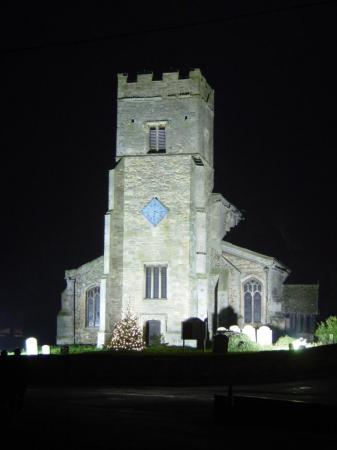 Parishes -
Wistow British History Online - It would appear from the Ramsey Cartulary that
KINGSTON, later known as WISTOW (fn. 8) was a recognised area before Ramsey Abbey was founded about
969. It comprised the districts covered by the later manors of Wistow, Bury, and Little Raveley. As its name indicates, it was royal demesne and belonged to King Edgar. We are told that
Oswald, Archbishop of York, the friend of Aylwin, founder of Ramsey Abbey, bought Needingworth from King Edgar with the intention of giving it to Ramsey Abbey, but realising the inconvenience of its distance from the abbey, exchanged it with the king for Kingston, which he bestowed on the abbey. (fn. 9) In 974 King Edgar confirmed Oswald's gift, under the description, according to the Ramsey Chronicler, of Kingston, with Bury and Raveley its berewicks or outlying hamlets. (fn. 10) The
confirmations by Edward the Confessor and again by William the Conqueror in
1078, are in the same terms.
Parishes -
Wistow British History Online - It would appear from the Ramsey Cartulary that
KINGSTON, later known as WISTOW (fn. 8) was a recognised area before Ramsey Abbey was founded about
969. It comprised the districts covered by the later manors of Wistow, Bury, and Little Raveley. As its name indicates, it was royal demesne and belonged to King Edgar. We are told that
Oswald, Archbishop of York, the friend of Aylwin, founder of Ramsey Abbey, bought Needingworth from King Edgar with the intention of giving it to Ramsey Abbey, but realising the inconvenience of its distance from the abbey, exchanged it with the king for Kingston, which he bestowed on the abbey. (fn. 9) In 974 King Edgar confirmed Oswald's gift, under the description, according to the Ramsey Chronicler, of Kingston, with Bury and Raveley its berewicks or outlying hamlets. (fn. 10) The
confirmations by Edward the Confessor and again by William the Conqueror in
1078, are in the same terms.
The Church of ST. JOHN THE BAPTIST is built of rubble with dressings of Barnack stone; the roofs are covered with lead and slates. It consists of a chancel (26 ft. by 15 ft.), nave (33 ft. by 17 ft.), north aisle (11½ ft. wide), south aisle (9 ft. wide) and west tower (10½ ft. square). All measurements are internal.
A church existed here in 1086, when it is mentioned in the Domesday Survey, but nothing now remains of this 11th-century building.
Wistow Church
- In the Ramsey Chronicle Wistow is mentioned as being in existence prior to the founding of Ramsey Abbey. At that time it was known as Kingestune (Kingston). We are told in the Chronicle that Oswald purchased Needingworth from King Edgar intending to give it to Ramsey Abbey. However as Needingworth was quite a distance from the Abbey he exchanged it with the King for Kingestune which he then gave to the Abbey. This gift of Oswalds was confirmed by King Edgar in 974 and later by Edward the confessor and then by William the Conqueror in 1078.
Ramsey Abbey - History - The Island called Ramsey - The Chronicler tells us, that in the eastern corner of Huntingdonshire, between the boundary made by the river Ouse and the extensive marshes that existed, a notable island was situated, the most beautiful of the fen islands in proportion to it's size
Genealogy of Aethelwine (Ailwyn)- The Ealdorman
In the days of Athelstan, formerly King of all England (Mercia then Wessex), a certain
leader of the East Anglians, whose name was also Athelstan was judged to be a remarkable man.
Because of his nobility, his wealth, and his abundant wisdom he became very useful to the King in running the business of the kingdom. For this reason he was called by everyone
“Athelstan Half - King” which is “semi-king”.
Athelstan “Half –King” married - Aelfwynn (whose lands later formed the nucleus of the endowment of Ramsey Abbey), who afterwards nursed and brought up with maternal devotion the glorious King Edgar (King of the English, 957 – 75 son of Edmund King of Wessex and Aelfgifu (died 944) ).
When Edgar became King of England, he was grateful for the benefits he had received from his nurse, he bestowed on her the manor of Weston (now old
Weston), which her son the Ealdorman (we know him as Ailwyn ) granted to the Ramsey Abbey in perpetual alms for his mothers soul when she died.
Aelfwynn bore four sons to Athelstan .
The first was called called Aethelwold , the second Aelfwold , the third
Aelthelsine , and the fourth Aethelwine ( Ailwyn ), who was to become founder of the Abbey. (Ref 7)
Ailwyn's family held vast properties throughout East Anglia, Essex, and the Shires of Bedford, Cambridge, Northampton, and Huntingdonshire. These estates,
Ailwyn, when he became Earldorman administered from his residence in Upwood Huntingdonshire, where he kept his court. (Ref 6)
Athelston the father of the above sons after he had spent most of his life doing good works,
became a monk at Glastonbury. There he managed to survive King Athelstan even up to the distinguished King Edgar, which spanned the reign of four Kings.
King Athelstan was succeeded by Edmund, his half brother.
King Edgar - he had been brought up and educated by Aelfwynn, the mother of Ailwyn, the founder of Ramsey
Ramsey Abbey - Discovery of four stone
coffins with one GIANT:
The men employed in widening the carriage drive to the Abbey discovered last week, about 20 inches below the surface,
four stone coffins three of which were deposited side-by-side and and the other a few yards off. The coffins vary in size and length, and would seem to have been made to order, each coffin being occupied by a skeleton ( all, more or less, in a good state of preservation) and adapted to the size and cranial proportions of its occupant, there being a circular cavity in each of the stone receptacles for the reception of the hinder part of the skull.
One of the coffins measured 6'6" in length in the inside, and enclosed the colossal remains of a person that height, showing that there were something like giants in those days.
Another Ramsey Abbey Skeleton and a connection to Kendel:
IVO de
TAILLEBOIS, The Earl of Holland (Ratcliffe-Crossgrove Family Line) ...
Like the date of Ivo's birth, the place of his birth has also been variously
reported. One source claims that he was "born in Anjou or Normandy,
France".[d] Another source states, when speaking of Kendal Castle, the
home of the Barons of Kendal, that it "was probably constructed by the men
of Ivo Taillebois (Ivor Woodcutter), from Caen in Normandy, who was one of
[the] region's first barons".[p] As seen above, other researchers claim
that he was born in England, either in Yorkshire[s] or in Spalding,
Lincolnshire.[r] Although a Norman, Ivo could well have been born in England
since there was much movement of people back and forth between France and
England before the Conquest. In this regard, the following seems significant:
In 1001, near Ramsey Abbey in the County of Huntingdonshire, a skeleton was
unearthed that was believed to be that of the legendary Persian bishop, St Ivo,
who had settled in the fen-country of England.
The Fens, which cover
portions of Cambridgeshire, Lincolnshire, Huntingdonshire, and Norfolk, include
the town of St Ives in Huntingdonshire, named after the saint and located eight
miles southeast of Ramsey Abbey. That Ivo was named after St Ivo not long after
the discovery of the saint's bones suggests that Ivo may in fact have born in
the area, and that his birthplace therefore may indeed have been in Spalding, a
Lincolnshire town twenty-two miles north of Ramsey Abbey and which, like the
Abbey, is located in The Fens.
Taking another look at the Utlages around Holt / Hindringham:
1228 - Warin le Utlagh v. Thomas de Hereford, in Swanetun. - Norfolk fines - 12th Henry III. (already had this)
1294 - James fil' Henry le Vaus (?) v. * Hugh le Utlawe, in Bodham and Westbekham. - Norfolk fines - 22 Edward I. - Bodham - West Beckham * new
James
fil' Henry le Vaus -
Holt hundred
- Earl Hugh, here mentioned, was Earl of Chester, and had a grant of this great lordship from the Crown, soon after this survey, and was held by the Vauxes
of the said Earl, and after by the Earl of Albemarle, &c.
The family of De Vallibus, or Vaux, were soon after the Conquest enfeoft of this lordship. Robert de Vaux held it in the 5th of King Stephen, and gave then 53l. 6s. 8d. livery, for lands of his wife's inheritance: in the Vaux it continued till the death of Sir John de Vaux, in the
16th of Edward I. who was a parliamentary baron, &c. and found to hold it of the
Earl of Albemarle. (fn. 4) Margaret de Riparijs, Countess of Devon, recovered her dower in 7 knights fees in this town, Cley, &c. held by Baldwin, the late Earl her husband, (see in Wayborn,) and the freeman's tenures that Giffard held were after united to the capital
manor.
Holt hundred - Bodham or Bodenham - Bund, a Saxon thane, was lord of, in the reign of the Confessor, consisting of two carucates of land, 17 villains, &c. and 4 borderers; there were then 2 carucates in demean, and 2 among the tenants, 2 acres of meadow, &c. 17 goats, and 2 socmen had 30 acres of land, with half a carucate, then valued at 20s. at the survey at 10s. it was 10 furlongs long, and 5 broad, and paid 12d. gelt
Holt - Holt
gains a mention in King William's Domesday book of 1086. It had its own market
and its own port - Cley is listed as being the port of Holt. With five
water mills and twelve plough teams it can been seen as a busy settlement. Originally
held by Walter Giffard, the manor passed to Hugh, Earl of Chester, who in
turn left it to the De Vaux family. With a well-established market and
annual fair days on April 25th and November 25th, Holt grew as the local centre
of trade.
There are a few glimpses of the town in the medieval period, with De Vuaux's
bailiffs being recorded as being less than honest with the townsfolk - stealing
goods from stallholders, and holding some of their animals to ransom. The
plague of 1348 had a devastating effect in the Holt deanery - 23 priests are
recorded as dying during this period, and there must have been many more of
their parishioners besides
Many of places around Norfolk/Holt like Langham are shown being held by Guert, Harold's brother after the conquest - this is Gryth ... so this is interesting to me in the "Landless" Outlaw connections ... since
Gyrth was made Earl of East Anglia, Cambridgeshire and Oxfordshire some time between 1055 and 1057
So were the Utlage's counted as Gyrth Godwinson men?
Gyrth Godwinson - was the fourth son of Earl Godwin, and thus a younger brother of Harold II of England
According to Orderic Vitalis and William of Malmesbury, he tried (ineffectually) to prevent Harold from engaging William of Normandy in battle, saying that he instead could lead the English forces.... Harold, however, ignored Gyrth's advice. Gyrth fought at and was killed in the Battle of Hastings alongside his brothers Harold and Leofwine
Earl Chester was busy with Wales, so he gave Holt away... :
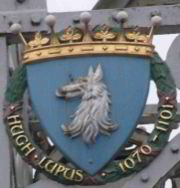 Hugh d'Avranches, 1st Earl of Chester
- (died 27 July 1101), called the Fat or the Wolf (Latin:
Lupus, Welsh:
Flaidd), was the first Earl
of Chester and one of the great magnates of early Norman
England. ...
Hugh d'Avranches, 1st Earl of Chester
- (died 27 July 1101), called the Fat or the Wolf (Latin:
Lupus, Welsh:
Flaidd), was the first Earl
of Chester and one of the great magnates of early Norman
England. ...
In time Hugh became so fat he could hardly walk; he is often
referred to as "the Fat".
The Welsh, for his brutality, called
him Flaidd ("the Wolf"). ...
Hugh married Ermentrude of Claremont, by whom he had one son, Richard, who succeeded him. Richard married Matilda of Blois, daughter of Stephen, Count of Blois and Adela, a daughter of William the Conqueror. Both Richard and Matilda died in the White Ship disaster (1120), and Hugh was then succeeded by his nephew Ranulph le Meschin, Earl of Chester. Hugh was buried beneath the stained glass windows in the Chapter House of Chester Cathedral.
Chester was one of the last towns in England to fall to the Normans in the Norman conquest of England. William the Conqueror ordered the construction of a castle, to dominate the town and the nearby Welsh border. In 1071[4][5] he created Hugh d'Avranches, the 1st Earl of Chester.
ENGLISH EARLS 1067-1122 - Orderic Vitalis states that Hugh was "a slave to gluttony, he staggered under a mountain of fat" and was "given over to carnal lusts and had a numerous progeny of sons and daughters by his concubines...
The Sword of Dignity!
In 1724 the remains of Hugh Lupus were "discovered" in Chester Cathedral, wrapped in leather, and deposited in a stone coffin, having a cross on the breast. They were re-buried with the following terrible verse:
Altho my corpse it lies in grave
And that my flesh consumed be,
My picture here, now that you have
An Earl some time of this city
History, gazetteer, and directory of Shropshire: comprising a general survey ... By Samuel Bagshaw
Cheshire sheaf, Volume 2 By Francis Sanders, William Fergusson Irvine, J. Brownbill
An analysis of the Domesday book of the County Norfolk- George Munford
HUGH EARL OF CHESTER.
Hugh de Abrincis, or Avranches, surnamed Lupus, was half-nephew of
William the Conqueror.
...
This earldom he was to hold as free by the sword,
as the King held England by his crown.
...
Upon receiving his earldom in sovereignty, which was probably conferred upon him
that he might the better be enabled to restrain the
incursions of the Welsh, Hugh Lupus
created twelve barons,3 whom he called his peers,
and enjoyed all the rights of
royalty in his sovereign court. But, with all his greatness, his
character, as drawn by Ordericus Vitalis, appears to have been a very worthless
one. "He was a most luxurious and prodigal nobleman. His attendants,
whenever he travelled, were so numerous, that they looked more like an
army than a family of servants. He gave
away vast sums of money, without reason or
measure, and was equally extravagant in the bribes
and presents he extorted from people under his authority. He was excessively
fond of the country sports of
hunting and hawking, in the pursuit of
which he destroyed the fences, and laid
waste the arable lands, of
his county of Cheshire in a miserable
manner, having no regard to the interest of
the farmers who occupied them, or to the remonstrances
of the clergy, but being governed entirely by the
hawkers and huntsmen who were his companions in those sports. He was
also an excessive glutton, and indulged himself
so much in the pleasure of
eating and drinking, that he grew enormously fat and heavy, so as to be
hardly able to walk. He was also a great whoremaster, and had a great number of
illegitimate children, by several different women, who almost all came to
untimely deaths; and he had one lawful son by his wife, Ermentrude, the
daughter of Hugh of
Clermont, in the country of
Beauvais in France; he was named Richard, and succeeded him in the
possession of the county of
Chester, and died a young man, and without children, in the
reign of King Henry the
First, being drowned in the same ship with
William called Adeling, or the prince royal of
England, the only son and heir apparent of
that king."
Don't know where I'd need this, The Norfolk "Holt" has nothing to do with the family, although I think there are a few "De Holt's"....
Holt Ancestry The Origin of the Holt name - The topographic name of HOLT means dweller by a wood or copse, a small area of undergrowth and small trees grown for periodical cutting. This old English term Holt, a wood or a grove, was often preceded with de or del. The Holt name first appeared in 1185 in Kent in the Templars Records with the name of Hugo de Holte. There are many different spellings of the name Holte, Hoult, Holtzer, Holts, Hoults .. as church officials recorded and spelled the name as it sounded. The surname of Holt is one of the oldest Anglo Saxon surnames on record.
The name Holt, seated in Lancashire, appears there from ancient times and possibly before the Norman Conquest and the arrival of Duke William at Hastings in 1066
A.D.
The Holt name appears in manuscripts and ancient documents such as the Doomsday Book, the Ragman Rolls, the Curia Regis rolls, the Pipe Rolls, the Hearth Rolls, parish registers, baptismals and tax records.
The Saxon gave rise to many English surnames not least of which was the Holt surname. The
collapse of Roman
Britain drew migrants from across the channel and the arrival of Anglo Saxon settlers caused social and political unrest mainly in the south and east of
Britain. The Saxons gradually relocated to the north and west, and during the next four hundred years forced the Ancient Britons back into Wales and Cornwall in the west and Cumberland to the north.
Under Saxon rule England prospered under a series of High Kings, the last of which was Harold. In 1066, the Norman invasion from France occurred and their victory at the battle of Hastings. Subsequently, many of
the vanquished Saxon land owners forfeited their land to Duke William and his invading Norman rule, and many moved northward to the midlands, Lancashire and Yorkshire away from the Norman oppression.
This notable English family name, Holt, emerged as an influential name in the country of Lancashire where the Holts were recorded as a family of great antiquity seated with manor and estates in that
shire. This ancient Lancastrian name was first recorded about 1190 in Lancashire when Hugo Holte was lord of the manor and estates. The Holt surname can be found in many places, but this site is mainly looking at the distribution of the name in Lancashire, England.
By the 13th Century the Holts held many halls and lands, the principal families located at Castleton Hall; Stubley Hall; Bispham Hall; Shevington and
Ince; and other branches at Ashworth Hall; Grizlehurst Hall; Bridge Hall; Stubbylee Hall; Little Mitton Hall and Balderstone Hall. The family history and genealogy is most intriguing. The Holt name in the parish of Rochdale has been associated with wealth and dignity.
http://www.genuki.org.uk/big/eng/DBY/NamesPersonal/Holt.html ...
Otherwise many bearers of the surname would have derived the name from being associated with the numerous places called "Holt". The earliest example of the word itself in writing occurs about 800 AD and of the surname in 1185 (Hugo de Holt: Warwick).
In reference to Holt/Hindringham another link: An Essay Towards a Topographical History of Norfolk Vol IX Holt page 394 - Hindringham page 226
An Essay Towards a Topographical History of Norfolk - Hindringham
The National Archives Access to Archives - HINDRINGHAM HALL RESTORATION PAPERS 1891-1981
Hindringham Hall Gardens - North Norfolk website - E&A Details
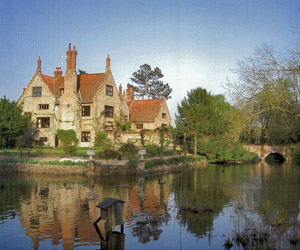 The
moat dates form 1200 and is one of only a handful of complete moats in Norfolk.
It originally enclosed a number of wooden medieval buildings and a community
working for the Prior of Norwich to produce fish from the adjacent fish
ponds. The outlines of the medieval fish ponds can still be seen. The moat still
contains carp and eels. The moat is crossed by a brick and stone bridge to the
south and a wooden bridge to the north.
The
moat dates form 1200 and is one of only a handful of complete moats in Norfolk.
It originally enclosed a number of wooden medieval buildings and a community
working for the Prior of Norwich to produce fish from the adjacent fish
ponds. The outlines of the medieval fish ponds can still be seen. The moat still
contains carp and eels. The moat is crossed by a brick and stone bridge to the
south and a wooden bridge to the north.
In the 18th century there was an earth causeway instead of the wooden bridge
and the tunnel which had been under the earth to permit the free flow of water
can still be seen. The moat is mainly revetted on the inner walls and partially
revetted on the outer walls. It has a natural white clay base and is mainly fed
by springs, but a system of sluice gates in the south east corner permits the
topping up of the moat from the river Stiffkey in hot weather.
The south east wing dates from the 15th century (Henry VII) and the remainder is
Elizabethan (16th century). It is virtually unchanged from when it was enlarged
by Martin Hastings in 1562. It remained in the ownership of the Church until
1880 being let on long leases together with many acres comprising the manor
to gentlemen farmers. By 1880 it was virtually derelict due to the slump in
farming and in multiple occupations by farm labourers. It was then acquired by
Gerard Gosselin whose arms appear above the 15th century front door. Gerard
Gosselin repaired the house over a period of 15 years and his widow lived there
until 1947. The outlines of external projecting medieval garderobes can still be
seen at first floor level at the back of the house. The entrance porch is built
from stone taken from Binham Abbey after its dissolution by Henry VIII. The rest
of the construction is of medieval brick and flint. The stepped gables show the
Flemish influence.
A guided tour of the house and its history is available to parties of 20 or
more by prior arrangement.
Norfolk
Churches -Hindringham_St Martins - The ancient chest
that sits there. Generally considered the oldest in England, it probably
dates from the end of the 12th century. Astonishing.
King Arthur's Cave - This has nothing to do with anything - but it is interesting... Herfordshire... another early Giant story....
UBSS University of Bristol Spelaeological (Caving) Society
http://www.ubss.org.uk/resources/proceedings/vol20/UBSS_Proc_20_1_75-76.pdf
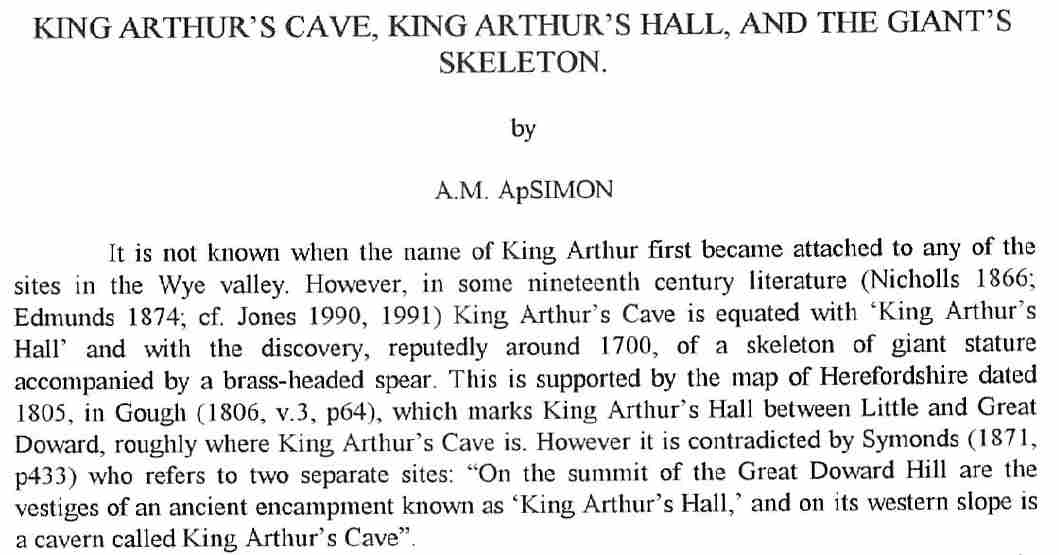
King
Arthur's Cave
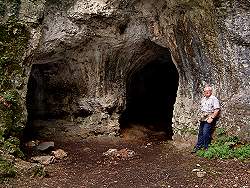 The
cave is situated at the foot of a low cliff at the north-western end of Lord's
Wood on the hill of Great Doward at Whitchurch
near the River Wye. It consists of a broad entrance platform, a double
interconnected entrance and two main chambers. The platform entrance lies 300
feet above the Wye and faces the north west commanding a good view of the
saddle-back of Great Doward Hill. All of the deposits that have filled this
cave seem to be either Late Pleistocene or more recent.
The
cave is situated at the foot of a low cliff at the north-western end of Lord's
Wood on the hill of Great Doward at Whitchurch
near the River Wye. It consists of a broad entrance platform, a double
interconnected entrance and two main chambers. The platform entrance lies 300
feet above the Wye and faces the north west commanding a good view of the
saddle-back of Great Doward Hill. All of the deposits that have filled this
cave seem to be either Late Pleistocene or more recent.
[Mr] Cave, B V refers to a skeleton discovered in 1695. In that year a
woman herding goats went into the cave and found a skeleton apparently with
the remains of a spear. The skeleton was reported as being of gigantic
proportions. The bones were collected and given to a surgeon in Bristol
called Mr Pye. Extraordinarily though it seems he took them with him on
a sea voyage to Jamaica, but the ship sank and the bones were lost.
![]() Whitchurch, Herefordshire
- named after the church of Saint Dubricius
which was originally white in colour. Whitchurch is situated on the A40,
connecting nearby Ross-on-Wye
to Welsh town Monmouth. It
is located near Symonds Yat
and the Doward hills, so the village is used to tourists. Until the 9th
century, when it was taken over by Mercia,
this area was within the Welsh
kingdom of Ergyng. After
the Norman conquest, the area became known as Archenfield
and was governed as part of the Welsh
Marches - Pictures of
Great Doward
Whitchurch, Herefordshire
- named after the church of Saint Dubricius
which was originally white in colour. Whitchurch is situated on the A40,
connecting nearby Ross-on-Wye
to Welsh town Monmouth. It
is located near Symonds Yat
and the Doward hills, so the village is used to tourists. Until the 9th
century, when it was taken over by Mercia,
this area was within the Welsh
kingdom of Ergyng. After
the Norman conquest, the area became known as Archenfield
and was governed as part of the Welsh
Marches - Pictures of
Great Doward
Little Doward, King Arthur - Vortigern, fled to one of his strongholds in Wales to escape St Germanus. He had a number of them from Gwynedd in the north, Dyfed in the west to this one, Little Doward, set high above a loop of the river Wye. - According to legend, Vortigern was trapped in a stronghold called Little Doward and burnt alive when Ambrosius, his successor, chased him there in his successful quest to take the high kingship.
EBK King Ambrosius
Aurelianus alias Emrys Wledig - While under siege at Caer-Guorthigirn (Little
Doward, Herefordshire), the fortress was miraculously struck by lightning.
Vortigern and his entire garrison were burnt to death.
Ilketshal Manor - Alan de Utlage - son of Robert de Utlage and Bartholomew de Brancestr of Ilketshal - Ilketshall St. Andrew - Ilketeshale's Manor
Harold's freemen abovementioned held, and were ejected .... (I wish I had a dollar every time I read that...)
There seems the possibilty that the Utlag's were pushed off their land by Hermer de Ferrers who became "De Wormgay" , and that somehow there is a connection to the TRE owner -Thorketel (or Turchetel or Turketel)
1199 - IBER
FEODORUM - Alan Utlage, Wormegay Quarter fee in Hindringham and Homeresfeld
- Norfolk - Robert Utlag
1207 - Hubert
de Burgh purchased of Roger de Burnham and Julian, his wife, William
de Noiers, Robert Fitz Ralph, and Alice his wife, and Robert de
Utlagh, their several nine parts of two knights fees in Runton and
Beeston and Hinderingham, for which they paid castle gaurd to Dover.
9th of King John * The
Norfolk antiquarian miscellany - West
Runton - Beeston
Regis - Hindringham
- "Hindringham
Outlagh Manor"
1207 - Alan
the son of Robert de Vtlage, granted the land of Beston and Runton to
the Prior of Walsingham by deed , sans date, bounded as there. - (The
Saxons would give land to a friendly church in order to keep from having to sell
(give) it to the Normans , this ploy often didn't work)
1218 - Alan
le Ultage
- 21 Aug. Winchester. Suffolk. Alan Outlaw gives the king 20s. for
having a writ to attaint the jurors of novel disseisin before the justices at
Westminster at Michaelmas three weeks, as last above . Order to the sheriff to
take security from Alan for rendering those 20s. to the king for this writ. 1
Witness the earl. - 2 Henry III
1230 - Alan
le Utlage in the Tax Rolls 'Feet of Fines' for the county of Essex
1232
- Emma
who was wife of Alan Le Vtlage v. Bartholomew de Brancestr
of Ilketshal - Suffolk - 16 HENRY III
Ilketshall St. Andrew
belongs to The
Saints, Suffolk, a group of villages near the border with Norfolk.
| - - - - -
Ilketeshale's
Manor - Was that which Harold's freemen abovementioned held, and were
ejected, and the Ilketeshalls possessed it after Ralph.
Sir Gilbert de Ilketeshale was lord of this manor, with that of Hedenham
in Norfolk, and of Ilketeshale in Suffolk, from whence they assumed
their name; and
Sir Thomas was his son and heir, as appears from the register of [St
Benet's?] Holm
abbey, and a fine levied in the 7th of Henry III.
Gilbert was son and heir of Sir Thomas, and had a charter for freewarren
in Kelling, Salthouse and Hedingham, and Ilketeshale, in the 32d of that
King.
Bartholomew
de Brancestr of Ilketshal - Ilketsal Parish
- Ilketsal - Ilketshall or Ilcheteleshala
There are four parishes so called, namely: St. Andrew, St. John, St. Lawrence, and St. Margaret; which are here noticed generally, and collectively. These with the foregoing parishes, of
Bungay St. Mary and Trinity, with Mettingham, which follows, are commonly termed
"The seven parishes of Ilketshal."
...
The several churches in these parishes were impropriated to the house of Benedictine
Nuns at Bungay, by the gift of Roger de Glanville, and Gundreda his wife, founders of that Monastery.
...
The Abbot of West Dereham, in Norfolk, had a lordship at Ilketsal, called
Lion's; of the gift of Bartholomew, son of Peter de Brancaster, of
Barton, in Norfolk. - Bartholomew
de Brancestr of Ilketshal - Suffolk
Of course anytime we hear of West Dereham we think of Hubert Walter and John de Bernewelle Outlawe "a canon of West Dereham, and one of the three brothers of that name" and also notice " Barton Cambridgeshire - which is very close to Barnwell Priory " :
1188 - Walter Hubert
founds West
Dereham Abbey for Premonstratensian
house of canons
- The canons were to pray for the souls of the founder and his parents, his
brothers and sisters and all his relatives and friends, as well as for the
souls of Ralph de Glanville, justiciary of England, and Bertha his wife.
1193 - Hubert
Walter becomes Archbishop of Canterbury - St.Andrew
- His home was West Dereham Abbey
1392 - Priory
of Barnwell - John de Bernewelle, or John Outlawe, elected March 1392, died Nov.
1408 - John de Bernewelle, (fn. 213) whose personal name was Outlawe; (fn. 214)
possibly a canon of West Dereham, and one of the three brothers of that name
So now I am looking for some Outlaw connection to this "lordship at Ilketsal, called Lion's; " and any info on the "Lion's manor "...
Oh and again all these guys are involved with the Crusades and the Templars.... and I find it interesting that some of these "Outlawe's" appear after 1308, the end Templar's...which was one of my early theories of "Outlawe" origins at the end of the Templar's ie they Outlawe's seem to appear from the Abbey's after the suppression in 1308-1312...always very near Templar sanctuaries like Waterbeach.
Barton Hall – A Potted History — The Berney Arms
The earliest recorded local landowner is Thorketel (“Turchetil” in Domesday book), a Saxon Thane known to have lands as far apart as Lincolnshire and Middlesex.
Thorketel (or Turchetel) ousted from his seat by William Hermer de Ferrers, a loyal Norman freeman given the seat by William the Conqueror some time before 1085, possibly directly following Hereward the Wake’s failed resistance in 1071 or the Earl’s Revolt in 1075.
Hermerus de Ferrars was a Norman nobleman who came over with the
Conqueror, and who for his services was well rewarded with twenty-five
lordships in Norfolk ; but not content with these lands, he invaded and
seized on other lands without any authority from the King.
He seized on the lands of thirty-two freemen in West Dereham. He had
sixteen manors in Clackclose, ten in Freebridge, one in Shropham, three in
Launditch, eleven in Mitford, and one in Humbleyard, including what he seized on
without any authority from the King.
William I. granted the manor of Wormegay, in Clackclose, to Hermerus de
Ferrars, on the deprivation of Turchetel, a Saxon thane, who held many lordships
in the Hundred and county. According to the Norman custom, the
descendants of Hermcrus took the name of de Wormegay, from "Wormegay, which
was the chief manor of a barony.
Clackclose Hundred and Half -
Barton British History Online - BARTON.
Lovel's Manor.
Called Bertun by the Saxons, from its site by the hills; thus Barley in Hertfordshire, Barton in Suffolk, &c. Bergh or Bar signifying a hill. At the grand survey, made by King William I. in the year 1085, it was possessed by three great lords; one of these,
Hermerus de Ferrars, or De Ferrers, was lord of this manor, by a grant of the Conqueror, on the deprivation of Turchetel. William was enfeoffed of it under
Hermerus. ...
Turchetil was a Saxon thane, or nobleman, held many lordships in this hundred and
county, most of which were granted to Hermerus.— William, who held it of him, was probably ancestor of the family of De Wormegey, which was also a lordship of Hermerus: he is styled a freeman.
Godwin, father of King Harold, and his sons, are thus also called in the grand
survey.
In the book of Domesday, we frequently meet with the word commendatio. Romulus, the first King of Rome, placed the Plebeians (as a trust) in the hands of the Patricians, allowing every Plebeian the liberty to choose any Patrician he thought proper for his patron. Terence, in his play called the Eunuch, says,—Thais patri se commendavit in clientenam, et fidem nobis se dedit.—It is probable, the Britons learned this of the Romans, and so came to the Saxons.
Another thing to be observed here is, that great Norman lords at the conquest, frequently invaded, or seized on the lands of many freemen and Saxon lords, without any authority or grant from the Conqueror, by force and
violence.
...
Brancaster Hall.
The ancient family of Brancaster gave name to it; Robert de Brancaster was living, and lord, in the reign of Henry II. (fn. 5)
[ so this maybe the Lion's Lordship: ]
Bartholomew, son of Peter de Brancaster, gave by deed, sans date, (with his body,) the chapel of St. John Baptist, in Barton Eastmore, to the abbey of West
Dereham, and Adam, son of Thomas de Brancaster, by deed, s. d. gave to Adam de Fincham, and Annabel his wife, one messuage, with the appertenances in Berton, called Brancaster Hall crofts, and 5s. rent per ann. of free tenants; 2 villains, with all their goods and chattels, with 2 acres of land, all the homages, wards, escheats, &c. of the free tenants.
| - - ----
Barton Eastmore - This appears to be next to Barton Bendish:
Barton Bendish, Norfolk - White's 1854 Directory - BARTON BENDISH, a scattered village, 4 miles N. of Stoke Ferry, contains in its parish the hamlet and enclosed fens of Eastmore, near the great foss and rampart called the Devil's ditch. ...
Eastmore hamlet had formerly a chapel dedicated to St. John the Baptist
"the house of Benedictine Nuns at Bungay, by the gift of Roger de Glanville,"
Houses of Benedictine nuns - Priory of Bungay British History Online
About the year 1160 Roger de Glanville and the Countess Gundreda, his wife, founded the priory of Bungay, in honour of the Blessed Virgin and the Holy Cross, for nuns of the Benedictine order. The first endowment consisted of benefices, lands, and rents, the greater part of which had been part of the dower of Gundreda on her marriage, and included the four churches of All Saints, Mettingham, Ilketshall St. Margaret, Ilketshall St. Andrew, and Ilketshall St. Laurence.
"the prioress of St. Cross, Bungay"
The prioress obtained licence in 1318 to appropriate the church of St. John Baptist, Ilketshall, which was of their own advowson
This priory came, of course, under the Act of 1536 for the suppression of the smaller houses. The exact date on which it was dissolved is not known. In April of that year a memorandum in the hand of the Duke of Norfolk was forwarded to Cromwell, wherein he stated that he had obtained possession of Bungay, worth £60 last St. Andrewtide. The nuns seem to have forestalled forcible action and deserted the house, knowing what was in store for them, for at that date the duke found ' not one nun left therein.
Bungay - is a small town in Suffolk (East Anglia, England), within The Broads National Park. It lies in the Waveney valley, about 7 km west of Beccles.
The origin of the name of Bungay is thought to derive from the Anglo-Saxon
title 'Bunincga-haye', signifying the land belonging to the tribe of Bonna,
a Saxon chieftain.
Britain was invaded by Saxon
tribes, and the extensive settlement at Bungay is indicated by the large burial
site in the Joyce Road area dating from the 6th - 7th century. Bungay
Castle was built by the Normans,
but was later rebuilt by Roger
Bigod and his family, who also owned Framlingham
Castle. The 12th century parish
church of St. Mary was once the church of the Benedictine
Priory (founded by Gundreda,
wife of Roger Bigod).
Gundred, Countess of Surrey - Gundred or Gundreda (Latin: Gundrada) (Normandy?, ca. 1048/1063 – Castle Acre, Norfolk, 27 May 1085[1]) was probably born in Flanders, sister of Gerbod the Fleming, 1st Earl of Chester.[2]
Gundred married in Normandy before 1070 or in 1077 William de Warenne, 1st Earl of Surrey (d. 20 June 1088), who rebuilt Lewes Castle, making it his chief residence. In 1078 he and Gundred founded a Cluniac Priory at Southover, adjoining Lewes, where both were buried.[3][4]
The Countess had died at Castle Acre, Norfolk, one of her husband's estates, and was buried beside him at the Chapterhouse of Lewes Priory.
Lewes Priory - The Priory of St Pancras was the first Cluniac house in England and had one of the largest monastic churches in the country ... In 1845 the London, Brighton and Hastings Railway (subsequently the London Brighton and South Coast Railway) drove their new line through the site, digging down to a track bed level to meet the new Lewes railway station (and constructing a line of railway cottages at the east end of Priory Street. This line bisected the foundations of the chapter house and church apse exposing the foundations and burials including those of William de Warenne and Gundrada. The destruction and collateral damage to the Priory remains was significant and the site was split in two but the construction triggered archaeological investigation.
So earl Warrene's wife was Countess Gundreda's, sister of Hugh the Fat - Gerbod the Fleming, 1st Earl of Chester
A later ancestor of William De Warrene is another Gundreda married twice:
Genealogy Roster - pafg3545 - Generated by Personal Ancestral File
Roger de Glanvill was born about 1125. He married Gundred de Warwick Countess of
Norfolk about 1178 in of, , Norfolk, England.
Gundred de Warwick Countess of Norfolk was born in 1130 in Warwickshire, England, Great Britain. She died in
1200.
She was buried in 1208. She married Roger de Glanvill about 1178 in of, , Norfolk, England.
... her maternal grandparents were William
II De WARENNE (WARREN) and Isabel
(Elizabeth) De VERMANDOIS.
Other marriages: Bigod, Hugh
Hugh Bigod was born about 1095 in Of, Belvoir Castle, Leicestershire, England. He was christened in Of, Framlingham, Suffolk, England.
He died before 6 Mar 1176 in Thetford Abbey, Norfolk, England. He was buried on 16 Mar 1176 in Thetford Abbey, Norfolk,
England.
He married Gundred de Warwick Countess of Norfolk about 1165 in of, Warwick, Warwickshire, England.
Hugh
Bigod, 1st Earl of Norfolk
- Bigod kept his lands and his earldom, and lived at peace with Henry II until
his death reportedly in 1176/1177, in Palestine.
| - - - -
1199 - IBER
FEODORUM - Alan Utlage, Quarter fee in Hindringham and Homeresfeld
- Norfolk - Robert Utlag
Liber Feodorum Part II Appendix
- 1198-1199
NORFOLK. 1329
S.ij.1 - cont.
Hugo de Stivekei viij.d. ad vigiles de predicto feodo.
Rannulfus de Torp' xxj.d. eidem castello. Alanus de Nuiers x.d. et ob.
Rogerus de Nuiers x.d. ob.; Robertus Utlag' xxj.d.
...
NOMINA FEODORUM MILITUM TENENCIUM DE HONORE DE WORMEGEYE.
[ holding a
knight's fee of the Honour of WORMEGEYE.
]
...
Alanus Utlage, iij. quarteria in Hindringham et Homeresfeld. - Hindringham
in the quarters and
Homeresfeld.
1199 - IBER
FEODORUM - Alanus Utlage, iij. quarteria in Hindringham et Homeresfeld
NOMINA FEODORUM MILITUM TENENCIUM DE HONORE DE WORMEGEYE.
THE
NAMES OF THE holding
of the
knights' fees Honore
De WORMEGEYE.
( Wormegay
Castle Watlington Norfolk East Anglia England) - Norfolk
Heritage Explorer -Wormegay
Alan
Utlage,
Knights
fee - three
quarters,
Hindringham
and
Homeresfeld.
Wormegay Castle - is a motte and bailey earthwork, located next to the village of Wormegay in the English county of Norfolk. The castle was probably built by Hermer de Ferrers after the Norman Conquest . Wormegay Castle is located in the village centre, off Front Street. 7 miles south of King's Lynn, on the A10-A134.
What is interesting was that Alan Utlage had an interest in Homersfield -
Why?:
Later his wife is in court with
Bartholomew de Brancestr
of Ilketshal for what? They both had interests in Barton and
in the "The Saints" land area. It also connects with "De Wormegay"
Ferrers...
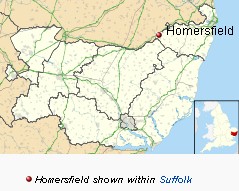 Homersfield - South
Elmham St Mary, known as Homersfield, is a small village
and civil
parish located on the banks of the River
Waveney in Suffolk, UK,
on the border with Norfolk.
It is one of The
Saints.
Homersfield - South
Elmham St Mary, known as Homersfield, is a small village
and civil
parish located on the banks of the River
Waveney in Suffolk, UK,
on the border with Norfolk.
It is one of The
Saints.
Full text of A history of Norfolk
The Berney Arms - South West Norfolk region in the delightfully quiet village of Barton Bendish, nestles The Berney Arms. The village is mentioned in the Domesday Book of 1086 were the name is given as Bertuna. The main tenant of the village was William from Hermer de Ferrers. Other tenants were Reynald Fitzlvo and Ralph Baynard.
[ So who was Wormegeye ? Again ]
The Honor of Wormegay
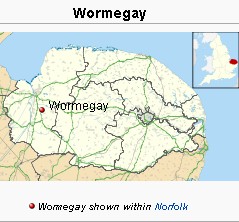 Wormegay
- is a civil
parish in the English
county of Norfolk.
The village is situated some 9 kilometres (5.6 mi) south of King's
Lynn and 60 km (37 mi) west of Norwich.
For the purposes of local government, it falls within the district
of King's
Lynn and West Norfolk.
Wormegay
- is a civil
parish in the English
county of Norfolk.
The village is situated some 9 kilometres (5.6 mi) south of King's
Lynn and 60 km (37 mi) west of Norwich.
For the purposes of local government, it falls within the district
of King's
Lynn and West Norfolk.
The place-name 'Wormegay' is first attested in the Domesday Book of 1086, and means 'the island of Wyrm's people'.[3]
Just to the west of the village centre lies Wormegay Castle, a motte and bailey earthwork.
 Wormegay Castle was originally a late
Saxon manorial complex, which was fortified in the 11th century, by Hermer de
Ferrers. In the 12th century, Reginald de Warenne modified the fortification and founded the earthwork motte and bailey castle....
Wormegay Castle is located in the village centre, off Front Street. 7 miles south of King's
Lynn,
Wormegay Castle was originally a late
Saxon manorial complex, which was fortified in the 11th century, by Hermer de
Ferrers. In the 12th century, Reginald de Warenne modified the fortification and founded the earthwork motte and bailey castle....
Wormegay Castle is located in the village centre, off Front Street. 7 miles south of King's
Lynn,
Wormegay Castle - The castle was probably built by Hermer de Ferrers after the Norman Conquest, and remained in the de Ferrers family until 1166.[1]
The motte is 5 metres high and 77 metres by 62 metres wide at the base.[2] The motte is surrounded on three sides by a ditch up to 15 metres wide and 2 metres deep.[2] The bailey is 150 metres by 88 metres across, and raised about 1 metre from the ground.[2] The castle would have been highly visible in early medieval times, more so than in the 21st century, and would have formed a local landmark as well as controlling the local causeway across the Fens.[3]
Wormegay formed the centre, or the caput, for an honour of feudal properties across East Anglia.[4] As the centre of a major estate, Wormegay provided castle-guard duties to Norwich Castle
An analysis of the Domesday book of the County Norfolk- George Munford
Hermer de Ferrariis, ancestor of the early lords of Wormegay, in this
county—his descendants, according to the Norman custom, taking the name of De Wormegay from the lordship which he held in that
parish—was rewarded for his services at the Conquest with the grant of twenty-two
manors in Norfolk, from many of which Turchetil, a Saxon, had been ejected. Hermer is conspicuous in Domesday Book, as being
by far the largest unlawful invader on the lands of the freemen of the county, and
was probably one of the most violent and tyrannical of the powerful Norman barons who accompanied Duke William to England.
His lands were worth, T. R. E. £63. 6*. 4c/., and T. R.W. £67. 0*. Sd.; while the value of the lands he invaded, or laid unjust claims to, was T. R. E. £19. 19*. 5d., and
T.R.W. £20. 19*. 9d.
| - - - - -
Introduction to the Ilketshalls
Four parishes to the east of South Elmham bear the name Ilketshall. These communities, named after the dedications of their churches, St Andrew, St John, St Lawrence and St Margaret, together with three adjacent parishes bounding the Waveney, namely the village of Mettingham (All Saints) and two communities of Bungay town (All Saints and St Mary), have been known since at least the 18th century as 'The Seven Parishes'. Together with the 'Nine Parishes' to the west based on South Elmham, this district is known to local people as 'The Saints'. It comprises the western section of Wangford Hundred.
Like the South Elmhams, the Ilketshalls are a unified topographical unit sharing the same flat glacial landscape broken by amost impercepible dips and troughs of melt water 'brooks' and 'becks' . It is impossible to descern where one village ends and another begins and easy to get lost in a maze of angular roads, lanes and footpaths.
The name Iketshall is said to relate to Ulfcytel
(died 1016) an [ Danish] Anglo-Saxon nobleman. He was apparently an
important warlord of East Anglia from 1004 to his
death 1016 at the battle of Assandun. Scandinavian sources refer to
him as Ulfkell Snillinge, the byname meaning bold. Ulfcytel
also appears as a character in Saint
Olaf's saga in the Scandinavian Heimskringla,
and here East Anglia is called "Ulfcytel's
land
[ Battle of Assandun 1016 - It was a victory for the Danes, led by Canute the Great, who triumphed over the English army led by King Edmund II ('Ironside'). The battle was the conclusion to the Danish reconquest of England.
It appears that the Seven Parishes estate had developed as a distinct property in Saxon times because Bungay, Mettingham and Ilketshall were grouped together in the Domesday folios under the ownership of Earl Hugh (Earl of
Chester). From this point of view the estate predates the formation of Wangford Hundred into which it was incorporated together with the South Elmham bishopric estate to the east. The ancient interdependence of the seven parishes through a common origin is reinforced by the practices of sharing common lands (intercommoning) which persisted into the 19th century. According to the local historian, Norman Scarfe, the whole of
the 'Seven Parishes' was also known as the 'Duke of Norfolk's Liberty', because it descended to the dukedom from
the Bigod family. Roger Bigod was a henchman of William The Conqueror who was rewarded with lands in nine of Suffolk's Hundreds, and in particular with a small parcel of land in Ilketshall. The Bigod family became firmly established in their
castle at Bungay during the following century. Their Bungay property descended with the ancient rights of the Bigods to the Howard Dukes of Norfolk of
Arundel, and in 1987 the castle was presented to the town by the Duke of Norfolk with an endowment towards its preservation.
1327 - Roger Utlagh , Prior of the Hospital (Knights Hospitallers) of Ireland - PETITION TO THE KING
PETITIONS TO THE KING; TO THE KING AND COUNCIL; TO THE COUNCIL; TO THE PARLIAMENT; AND THE LIKE.
Petitioners: [Roger Utlagh], Prior of the Hospital (Knights Hospitallers) of
Ireland Addressees: King and council
Places mentioned: Carlingford, [County Louth, Ireland]; Dromre (Drumcree), [County Westmeath, Ireland]; Martry, [County Meath, Ireland]; Duncormick, [County Wexford, Ireland]; Clonkeen, [County Louth, Ireland]; Kilmaynan (Kilmainham), [County Dublin, Ireland].
Nature of request: The Prior of the Hospital of Ireland asks the king and council to accept, and to confirm, his order's appropriation of the churches of Carlingford, Drumcree, Martry, Duncormick, and Clonkeen, to support a convent of chaplains at Kilmainham, to say mass for the king, his ancestors, and all Christians.
Famous Michelin Chef - Nathan Outlaw - our Man from Kent, how very appropriate
National Trust Land & country Great British Menu
- Chefs who took part in the fifth series of Great British Menu were challenged to source ingredients in and around their local National Trust property.
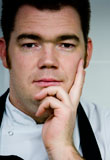 Nathan
Outlaw - South West
Nathan
Outlaw - South West
Nathan Outlaw - Seafood and Grill (Cotehele)
Nathan grew up in Kent and was born into a culinary life: his father was a chef
and he began cooking with him aged eight. After qualifying as a chef he went on to work under Peter Kronberg, Gary Rhodes, Eric Charvot, Rick Stein and Paul Ripley. He now owns Restaurant Nathan Outlaw in Rock which opened in February.
Michelin-starred Nathan Outlaw to launch new restaurant - 4-7-2009 - Caterer Search
Michelin-starred Nathan Outlaw to launch new restaurant - Kerstin Kühn Tuesday 07 April 2009
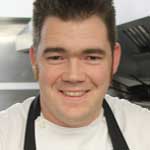 Michelin-starred
chef Nathan Outlaw is to launch a new restaurant in Cornwall, Caterersearch
can reveal. The chef, who runs his eponymous restaurant at the Marina Villa
hotel in Fowey, will take over the food and beverage operation at the St Enodoc
hotel in Rock next month. As part of his remit at the 20-bedroom property
overlooking Cornwall’s Camel Estuary, he will launch a new restaurant called Nathan
Outlaw Seafood and Grill in June. The 65-seat restaurant will serve a menu
of classic British fare with a focus on Cornish seafood and meat dishes
including steaks and casseroles.
Michelin-starred
chef Nathan Outlaw is to launch a new restaurant in Cornwall, Caterersearch
can reveal. The chef, who runs his eponymous restaurant at the Marina Villa
hotel in Fowey, will take over the food and beverage operation at the St Enodoc
hotel in Rock next month. As part of his remit at the 20-bedroom property
overlooking Cornwall’s Camel Estuary, he will launch a new restaurant called Nathan
Outlaw Seafood and Grill in June. The 65-seat restaurant will serve a menu
of classic British fare with a focus on Cornish seafood and meat dishes
including steaks and casseroles.
Head chef will be Peter Biggs, who previously worked with Outlaw at the Black Pig in Rock, where he first gained a Michelin star in 2004. Outlaw told Caterersearch the restaurant would be open seven days a week from breakfast through to dinner but would be closed for two months in the winter. “It’s not all about Michelin ambitions and this will be a vibrant place and a lot more relaxed than my other restaurant,” he said.
“I have taken over the lease and will divide my time between the two
restaurants, overseeing breakfast at the Seafood and Grill and cooking dinner at
the restaurant in Fowey.”
Nathan Outlaw joined the Marina Villa hotel at the end of 2006 and gained a
Michelin star in 2008, while also being tipped as a future two-star restaurant.
He previously held a star at St Ervan Manor.
Guide Girl:
starred Nathan Outlaw to launch new restaurant in Cornwall >>
Nathan Outlaw,
Fowey, Cornwall >>
England gains six new Michelin stars >>
RootsWeb
G - Ivo la Zouch
...
1399 - In the Writ 26 October 1399 to prove age of Ivo Harleston, son of
Margaret, a daughter and heir of Margret, wife of John de Wauton...Hugh Plowrigh
and
Richard Outlawe, each 58, on that day went with master Ivo la Zouch,
chancellor of Cambridge University, to the church, and after the baptism to
the house of the friars minor to hear the preaching of holy scripture
1399 - Richard Outlawe, 58, on that day went with master Ivo la Zouch, chancellor of Cambridge University, to the church
Sometimes facts are staring at you and you just don't see them until you come back at them later .... Early connection of Ramsey to The Round Church of Cambridge and Barnwell
Updated page: Barnwell Priory - John Outlaw (de BernewelIe) - Cambridgeshire
John de Bernewelle - So this seems to be John Outlawe and his "brothers"John O. junr., and Thomas. O from West Dereham and be goes on to become John de Bernewelle Outlawe at Barnwell Priory....:
What threw me was John Outlaw senior/junior ARE BROTHERS, their FATHER was Nicholas Outlaw, and the senior seems to have been fast tracked for some reason , keeping in mind this was after the 1350's Black Plague .... the 1387 date is clear...". a canon of West Dereham, and one of the three brothers of that name, all professed there, who were manumitted by Bishop Arundel with papal permission in 1387 at the request of the Bishop of Norwich. "
What's interesting is that you have a "White canon" of West Dereham becoming a "Black canon" at Barnwell....
This has me reviewing the Holy Sepulchre connection to St. John's Hospital and Barnwell Priory
1100 - SIR LORD PAYNE PEVEREL, son of William Peverel the Elder, started the Fraternity of the Holy Sepulcher a Chivalric Order. He was awarded lands and holdings in Salop in addition to his holdings in Bourne, Barnwell and Cambridge...he built the magnificent church of the Holy Sepulcher in Cambridge near the Castle
1125 - the St. Mary Magdalene Leper Chapel, Cambridge - the oldest surviving building in Cambridge
1130 - The Round Church of Cambridge was built in about 1130 and was originally a wayfarers' chapel - but soon became a parish church, served by the Austin Friars from the nearby Hospital of St. John (now St. John's College)
1211 - The Cambridge Fair was granted by King John with the revenues from the fair going to the Priory of Barnwell - one of the oldest fairs in the UK
1340 - Presentation of Reginald le Outlawe, parson of the church of Esthattele, in the diocese of Ely, to the church, of Risshenden, in the diocese of[ Esthattele is connected to Barnwell Abbey - St Michaels Cambridge - St John's Hospital - John de Hattele - Estenhale: its eastern extremity towards Barnwell Priory was called Estenhale] - Both St. John's Hospital and Barnwell Priory were built on common land St John's College, Cambridge - The college was founded on the site of the 13th century Hospital of St John in Cambridge at the suggestion of Saint John Fisher, Bishop of Rochester and chaplain to Lady Margaret.
reviewing the Cambridge Guilds: Cambridge Guild Records
1387 - Manumission of three nativi by licence from the Holy See : John Outelawe senr., John O. junr., and Thomas. O., lay brethren of Norwich dioc. Bull addressed to West Derham Abbey. They were born of a free mother, but their father Nichs. O. / laicus was " servus " of the Bp. fo. 61. - BISHOP ARUNDELL'S REGISTER. See: The abbey of St. Albans from 1300 to the dissolution of the monasteries on the freeing of Villiens (serfs) and the Peasants Revolt. - Thomas Arundel
1388 - Parliament met at Cambridge. The king and his court lodged at Barnwell Priory until the end of the session - 9 September 1388
1392 - Ralph Norton died, and was succeeded by John de Bernewelle, (fn. 213) whose personal name was Outlawe; (fn. 214) possibly a canon of West Dereham, and one of the three brothers of that name, all professed there, who were manumitted by Bishop Arundel with papal permission in 1387 at the request of the Bishop of Norwich. (manumitted - to free) - A lease involving the tithes of Holy Trinity, Cambridge, was negotiated between Barnwell and West Dereham after Bernewelle [ John Outlawe ] became prior
1408 - John de Bernewelle dies....
This is just another interesting story - but does have connections to Ireland and the Hospitaller's (and Roger Outlawe) AND the Templars ... somewhere I found the papers of King Henry III's assassination attempt at Woodstock in 1238 .. need to find it again....
The Marisco's were in charge of Ireland and "owned" Lundy island (between Ireland and Bristol, England) then the King gives Lundy to the Templars and then all hell breaks loose from William de Marisco :
This material has been moved to : Outlaw Family History in Ireland
New page of this material: Outlawe - Hanseatic League History
This is the Hanseatic League history. I thought I already
did this. ...
I was looking for some record to directly link the Hanse guild to the
Outlawe's, several Outlawe ships were used to transport goods to Danzig and
Lubeck is clear...
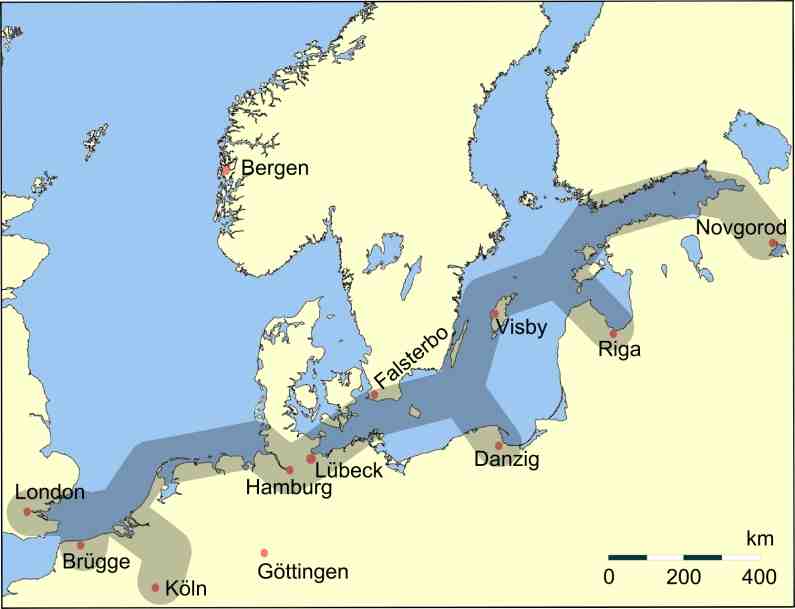 King's Lynn -
Hanseatic town guide to King's Lynn - Hanse.org
King's Lynn -
Hanseatic town guide to King's Lynn - Hanse.org
The Norfolk town accepted them as “the fraternity of the German Hanse” (fratres de hansa alemanies in Anglia existentes, Lynn 1302) ....
Lynn merchants sent cargoes to Prussia in Danzig ships and to Bergen in Lübeck bottoms, but none of them appear to have been resident in Norway or Hanseatic cities until the 1380s. Lynn was soon more heavily dependent on the Prussia trade through Danzig than any other English port. ...
The Treaty of Utrecht was signed in 1474 and the English King conveyed a quay and tenements in the Norfolk town to the Hanse. Lübeck invited Danzig to take charge of the property, the complex now known as St Margaret’s House. This is today the only surviving Hanseatic business headquarters or steelyard in England ...
In 1537 Bishop’s Lynn became King’s Lynn when the charter of Henry VIII finally dispossessed the Norwich bishops and transferred full political power to the town’s merchants.
Hanseatic League - The Hanseatic League (also known as the Hanse or Hansa) was an economic alliance of trading cities and their guilds that dominated trade along the coast of Northern Europe in the later Middle Ages. It stretched from the Baltic to the North Sea and inland during the Late Middle Ages and early modern period (c.13th–17th centuries). The Hanseatic cities had their own legal system and furnished their own protection and mutual aid, and thus established a sort of political autonomy and in some cases created political entities of their own.
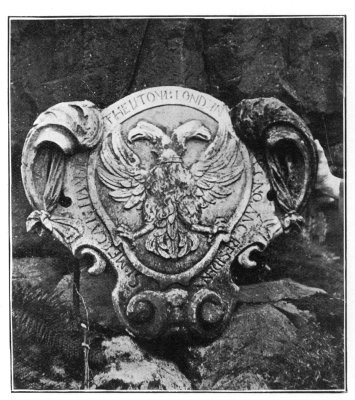 Coat
of Arms of the Hanse
- Merchants of London
Coat
of Arms of the Hanse
- Merchants of London
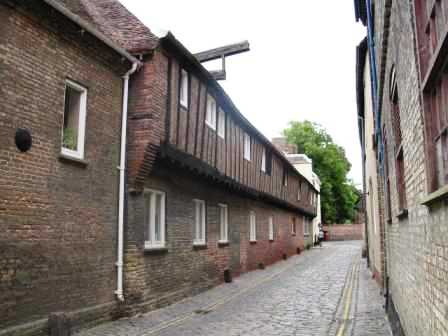 Hanse
House is situated between the riverbank of the Great Ouse and St.
Margaret's Church. The building is of considerable architectural and
historic interest and forms a picturesque feature of the street scenery of
King's Lynn. The building comprises of Hanseatic warehouses dating from
1475. Built around a narrow court, these large warehouses were
owned by Hanseatic League merchants until 1751.
Hanse
House is situated between the riverbank of the Great Ouse and St.
Margaret's Church. The building is of considerable architectural and
historic interest and forms a picturesque feature of the street scenery of
King's Lynn. The building comprises of Hanseatic warehouses dating from
1475. Built around a narrow court, these large warehouses were
owned by Hanseatic League merchants until 1751.
Prince Charles joins campaign to save King’s Lynn’s Hanse House - News - Eastern Daily
Press - Friday, January 14, 2011
The Prince, who is president of the Prince’s Regeneration Trust, will visit Hanse
House, in St Margaret’s Place, in the town’s medieval quarter, on
January 25. - St Margaret’s House, is suffering from years of
neglect....Prince Charles is said to have become concerned about the Hanse House
after hearing that the building was falling into disrepair.
BBC -
Prince of Wales visit to save King's Lynn's Hanse House
Hanseatic
Warehouse
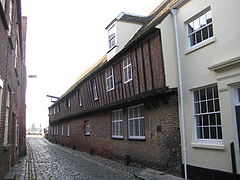 Located
on St Margaret's Lane, the Hanseatic Warehouse (52°45′04″N
0°23′41″E
/ 52.7512°N
0.3946°E / 52.7512;
0.3946 (Hanseatic Warehouse, King's Lynn))
is the only surviving Hansa
building in England. It was constructed in 1475 as part of the Treaty
of Utrecht allowing Hansa to establish a trading depot in Lynn for the first
time. It was used as such until 1751, by which time the river had receded. It
was then sold to Lynn merchant Edward Everard for £800. He added the Georgian
town house at the East side of the building which is now known as St. Margaret's
House (and Grade I listed[25]),
after the nearby church.
Located
on St Margaret's Lane, the Hanseatic Warehouse (52°45′04″N
0°23′41″E
/ 52.7512°N
0.3946°E / 52.7512;
0.3946 (Hanseatic Warehouse, King's Lynn))
is the only surviving Hansa
building in England. It was constructed in 1475 as part of the Treaty
of Utrecht allowing Hansa to establish a trading depot in Lynn for the first
time. It was used as such until 1751, by which time the river had receded. It
was then sold to Lynn merchant Edward Everard for £800. He added the Georgian
town house at the East side of the building which is now known as St. Margaret's
House (and Grade I listed[25]),
after the nearby church.
Archives of the Corporation of the City of London at the Guildhall
Hanseatic Timeline :
1230 - Peter
- Petrus le Utlage de Depa (Dieppe) - leads the ship - Patent Rolls
of Henry III - Dieppe,
Seine-Maritime
1309 - Ranulph
Galicien & Philip le Utlagh plaintiffs & Jordan Reynald &
Juliana his sister concerning the obstruction of a certain way - Rolls of the
Assizes - Common pleas in Jersey
1347 - Ship
James of Lynn - Edward III - Robert son of John Agnes is Master
- Later this ship belongs to John Owtelawe
1392 - Ship
of John Owtelawe, called James of Lynn, departing the last
day of February - customs levied thereon at Lynn
This document provides a glimpse, over the course of a year, into part of the export trade conducted, through the port of Lynn, with parts of northern Europe stretching between the Low Countries and the Baltic ... the vast majority of merchants and ship-owners mentioned in this account were either Lynn citizens or foreigners suggests that all of the traffic reported by the collectors went through Lynn's port; not surprisingly, the majority of the Lynn exporters were men from the upper echelon of borough society, characterized by membership in the town council of jurats. Judging from the places of origin of the ships, the most prominent destinations for the exports were Gdansk, Briel and Durdrecht. Most commercial ventures were conducted by individuals; partnerships were few, and joint-stock companies a thing of the future.
1403 - Commission to Robert Outelawe and Adam Outelawe (and others) That no persons banished from the said realms nor sea-robbers be received in any ports or ships of the realm. Feb 17- Feb 24 - Henry IV Patent Rolls. - Reference is made of Robert & Adam OUTLAWE being appointed, with others, to take certain enemies of the King into custody.
1408 - William Asshebourne, Lynn’s town clerk received a letter from Lynn men in Danzig setting out their ordinances recently drawn up for “their company” there. - Lynn and the German Hanse. - Gdansk - (formerly Danzig; see Names below), is a city on the Baltic coast in northern Poland - Historically an important seaport and shipbuilding centre, Gdańsk was a member of the Hanseatic League. - Lübeck which was also the primary origin of many settlers
1413 - Margery Kempe settled debts, and set off from Kings Lynn for pilgrimage of the Holy Land
1431 - The
son of Margery Kempe married a Prussian woman and both travelled
to Lynn, leaving their child in Danzig.
Margery’s son died in Lynn and Margery Kempe escorted her
daughter-in-law back to Danzig - So Margery Kempe probably knew Henry
Outlawe or (Richard or John Outlawe)
1454 - Protection
to John Owtelawe in the retinue of John earl of Worcester - Oct 23 - 33 Henry VI
- French Rolls - John
Tiptoft, Earl of Worcester - "the butcher of England" - in 1449 Lord
High Treasurer and then as Lord
Deputy of Ireland (1456–1457) - King
Henry VI's seizure with madness, in August 1453, supplied York with an
opportunity of getting control of the government without the use of force
against the King. ... the lords came up to London, early in 1454, with great
retinues
1456 - Kings
Lynn - John Outlawe, the son of Richard Outlawe, upon whom was conferred the
freedom of our burgh - Given The Keys to the City !!!
1456 - John
Outelawe, son of Richard Outelawe, app. of Adam Okey (A.) - Freemen
of Lynn
1462 - A
commission was granted to Sir John Howard and Sir Thomas Walgrave
to arrest the ships, the Mary Talbot and the Mary
Thomson,
both of Lynn, and other vessels in Norfolk, Suffolk, and Essex, for a fleet
which the King was fitting out - 29th May 1462
1463 - Auguste,
wytnessyth what my mastyr hath payd to Rechard Owtlaw, mastyr of the Mary
Talbott of Lynne, at the goynge to the see. - list of the retainers who
accompanied Sir John Howard to Wales in 1463 - crew Rechard Owtlawe
mayster - John Owtlawe.
Direct link the Mary (Talbott"?) of Lynn going to Danzig:
1468 - Robert
Deryng of Lynne, maistre of the ship called the Marye of Lynne,
wherof is owners Richard Outelawe and Aleyne Thomsone, satth, he sailed from
the towne of Lynne towardes Pruce in Dantzike - DRÁP BJÖRNS. -
VERZLUN
1474 - The Treaty of Utrecht - the English King conveyed a quay and tenements in the Norfolk town of Lynne to the Hanse. Lübeck invited Danzig to take charge of the property, the complex now known as Hanse House - King's Lynn and the Medieval Hanseatic League - A number of Lynn merchants and their associates seem settled in several Baltic seaports by the early 15th century, particularly in Wismar, Stralsund and Danzig
1481 - 1st Duke of Norfolk - Lord John Howard, commanded the fleet in the war with Scotland with great success - In the late spring of 1481 John Lord Howard sailed into the Firth of Forth destroying and capturing Scottish ships and burning Blackness - Mary of Lynne - take mariners for the said ship, as the king has ordered an armed force to go to sea to resist his old enemy the king of Scots. - The schippes that foloweth goeth to Scotland with the Lord Howard - The Mary of Lynne
Bernard Cornwell Book The Pale HorsemanUhtred's Women
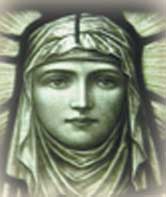 Possible Hagenild origins:
[ Hildr "sort of" sounds like Hage-nild ]
Possible Hagenild origins:
[ Hildr "sort of" sounds like Hage-nild ]
Hild or Hildr may refer to
Hildr, a common noun meaning "battle" in the Old Norse language. Hildr or Hild is one of the Valkyries in Norse mythology, a
personification of battle.
Hild or Hilda of Whitby is a Christian saint who was a British abbess and nun in the Middle Ages
A dictionary of English and Welsh surnames _ 347 - Hagenild - Haenyld
St Bene't's Parish Cambridge
1327 - Grant
to William de Saham of a plot of land - Eudo de Helpringham, mayor; John
Outlawe; Alan de Badburham, bailiffs - 23 June 1327 - Cambridge, St
Bene't's parish
1327 - Grant
to William de Saham of a plot of land - Eudo de Helpringham, mayor; John
Outlawe; Alan de Badburham, bailiffs - 24 June 1327 - Cambridge, St
Bene't's parish
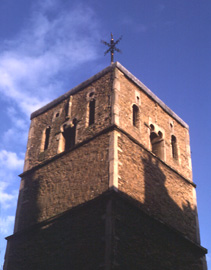 St
Bene't's Parish Church - Its Saxon tower is the oldest building in
Cambridge. Officially named St Benedict's, the church is called St
Bene't's by the locals. The church is on the south side of Bene't
Street adjacent to Corpus
Christi College - St Bene't's served as the college chapel until 1579
and the college remains the patron
St
Bene't's Parish Church - Its Saxon tower is the oldest building in
Cambridge. Officially named St Benedict's, the church is called St
Bene't's by the locals. The church is on the south side of Bene't
Street adjacent to Corpus
Christi College - St Bene't's served as the college chapel until 1579
and the college remains the patron
This ancient parish church is an Anglo-
The Tower
is Saxon, and the round holes are thought to have been made to encourage owls to
nest -
The church tower was probably completed around 1033. It is likely that it was built to contain bells from the beginning, but the earliest record of bells in the tower dates to the 13th century - the bell of St Bene’t’s was used to summon students to special lectures and to examinations. The Rector, Alan, complained about this in 1273, but was persuaded by the Bishop of Ely to permit the bell to be used 'in a civil and honest way'. Thereafter the parish clerk was paid an annual fee of six shillings and eightpence for such ringing. It is likely that there was more than one bell in the tower so it may have possessed a peal of four bells; the tenor was the best bell in town
800 Years of Death and Disease in Cambridge St Bene't's Church - Monasteries provided the only form of social security to the ordinary man in the street, as those in religious orders were expected to work for the community, offering shelter to all travellers and pilgrims and caring for the sick, poor and the elderly.
Another look at and search for early Hagenild's:
Amazingly how these references come up at just the right time
period:
Amazing: The "Englefield's" appear to be royal Saxons from the
time King Edgar that retained their lands even after the conquest. How?
Big question - what connection has "Hagenild" to the Utlage's or
have to do with the Englefield's?
Why was Peter son of Hagenild so important? Who is Hagenild'e' ???
National Archives - Peter Hagenild
1170 - Alan de Inglefeld to Peter son of Hagenilde and whichever of his boys he chooses for their lives, for 10s. annual rent and all services saving the King's. Witnesses: Ilger de Inglefeld, Peter the lord's uncle, Robert Puncun, Nicholas Pincerna, Robert de la More, William de Holme and Walter his brother, Walter de Molesford, and Hugh Amis. Seal missing. ½ virgate without house or 'curia' (formerly held by Roger, brother of the grantee) and 1 a. of meadow in 'Hyda Calcebuef'. Berkshire Record Office
The National Archives The Catalogue Full Details E 210-3653 - Hagenild
The Domesday of St. Paul's of the Year MCCXXII
1222 - Hagenild, the daughter of the
molendinarius, tenant at Navestock, 80 - The Domesday of St. Pauls of
London (a miller).Navestock
So a little info on Berkshire:
Berkshire - The county is one of the oldest in England.... Berkshire has been the scene of many battles throughout history, during Alfred the Great's campaign against the Danes, including the Battle of Englefield, the Battle of Ashdown and the Battle of Reading.
Englefield, Berkshire - is a village and civil parish in Berkshire, England. The village is mostly within the bounds of the private walled estate of Englefield House. ... In 870, the village was the site of the Battle of Englefield. This was fought between the Anglo-Saxons, under Æthelwulf, Ealdorman of Berkshire, and the Danes, and resulted in a resounding victory for the Saxons. The battle was the first of a series in the winter of 870-1. The village is thought to be named after the battle: Englefield meaning either "English field" or "warning beacon field".
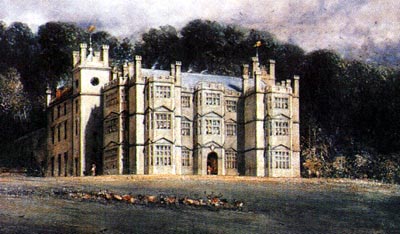 Englefield
House was the home of the Englefield family, supposedly from the time of King
Edgar.
Englefield
House was the home of the Englefield family, supposedly from the time of King
Edgar.
[ No not true ...William Fitz Ansculf (de Picquigny) Pinkney a NORMAN became the "Englefield"s Saxon - Alwin was dispossessed]
Sir Thomas Englefield was the Speaker of the House of Commons. In 1559, the house was confiscated from his grandson, Sir Francis Englefield, a servant of the Catholic Queen Mary, for "consorting with [the] enemies" of the new Protestant monarch, Elizabeth I. The family later lived at Whiteknights Park in Earley and continued to be buried in Englefield parish church until 1822.
Berkshire History Englefield House - ... The ancient Englefield family, who were supposedly lords of the manor since the reign of King Edgar the Peacemaker, in the early 9th century, and knights of the shire in the 14th and 15th centuries, therefore occupied at least part of the present edifice.
Parishes - Englefield British History Online -
ENGLEFIELD was held under King Edward the Confessor by a certain Alwin, and
after the Norman Conquest it was apparently granted to William Fitz Ansculf.
[A NORMAN] (fn. 5) At the time of the Domesday Survey the overlordship of the manor was vested in William Fitz Ansculf, (fn. 6) who
also held the neighbouring manor of Bradfield. (fn. 7) Englefield was one of a small group of manors which were dependent on Bradfield and were held by military service from its lords, the families of Paynell, Somery, de la Beche and Langford
...
The Englefield family, which for many years held this manor under the lords of Bradfield, claims great antiquity.
The tenant of the manor under Edward the Confessor was Alwin (see above), (fn. 11)
who was apparently dispossessed, since the manor was acquired by William Fitz
Ansculf. The immediate tenant in 1086 was Gilbert, (fn. 12) but there is no proof that he was the founder of the Englefield family, and his name does not appear in the Englefield pedigrees. (fn. 13) A possible supposition seems to be that
William Fitz Ansculf (de Picquigny) had enfeoffed a member of his own family, and that this
Gilbert was the ancestor of the Pinkneys, who had a considerable holding in Englefield in the 12th century and may have been sub-tenants of the manor. The first record of the Englefield family seems to be in the 12th-century charters in which
Ansculf de Pinkney granted a hide of land in Englefield to Guy and the meadow of Middleham to Ellis, sons of Ansculf Englefield. (fn. 14) By 1166 the manor was probably in the hands of the Englefields, for in that year Ellis Englefield was one of the military tenants of Gervase Paynell. (fn. 15) The next lord of the manor may have been
William Englefield, probably the son of Ellis, who was the donor of Englefield church to Reading Abbey. (fn. 16) The gift took place before 1184. Another William Englefield was in seisin of the manor at the close of the 12th century; he seems to have come into his inheritance shortly before 1195–6, (fn. 17) in which year he received a quitclaim of half the vill of Englefield and lands there from his mother Maud and her husband
Giles Pinkney. (fn. 18) He died childless and was succeeded before 1219 by Sir Alan Englefield, said in the family pedigrees to be his brother and heir. (fn. 19) This seems, however, to be unlikely from the evidence of a law-suit of the date of 1242–3. (fn. 20) In this Emma de Dunsterville was said to have been the mother of Sir Alan, but as William presumably was the elder, and his mother Maud was alive at the date of his succession, (fn. 21) it seems impossible that Alan could have been his younger brother; he may perhaps have been a nephew. Sir Alan was a justice for Berkshire in 1226, (fn. 22) but he seems to have died shortly after that date. (fn. 23) His son William held Englefield for many years, (fn. 24) the last mention of him being in
1258 ...
Guillaume Fitz Ansculf de Picquigny
William Fitz Ansculf, also called William of Pinkeni, was from Picquigny, Somme. He was the son of Sheriff of Buckinghamshire. Castle at Dudley, Worcs. Holdings in 12 midland and western counties.
Picquigny - is a commune in the Somme department in Picardie in northern France.... On 29 August 1475, with the Treaty of Picquigny, Louis XI brought to an end the Hundred Years War. The French king had to pay Edward IV an annual sum of fifty thousand crowns.
This information will be moved to :Barnwell Priory - John Outlaw (de BernewelIe) - Cambridgeshire
We need to keep researching the connections of "Bourn" Manor to Ramsey Abbey Cambridge in relation to Barnwell Abby
Ramsey Abbey provided the land for the Cambridge Round Church with connections to Templars/Hospitallars and had connections to Bourn and connections to Mandeville ... Later Mandeville's and Glanville's go on crusades .
1100 - SIR LORD PAYNE PEVEREL, son of William Peverel the Elder, started the Fraternity of the Holy Sepulcher a Chivalric Order. He was awarded lands and holdings in Salop in addition to his holdings in Bourne, Barnwell and Cambridge...he built the magnificent church of the Holy Sepulcher in Cambridge near the Castle
That and the Mandeville connection in that some of Queen Edeva's land
went to Mandeville :
1143-1144 - Geoffrey
de Mandeville, 1st Earl of Essex - Geoffrey maintained himself as an
Outlaw and a bandit in the fen-country,
using the Isle
of Ely and Ramsey
Abbey as his headquarters.
Ramsey Abbey had land in Bourn! Of the 20 hides which Bourn was assessed before the Conquest, Ramsey Abbey owned, as a berewick of its estate in Longstowe, 1 hide, which had been given to it by Ethelgiva (died 985), wife of Ailwyn, Earldorman of East Anglia.
Subsequently the
Ramsey land at Longstowe may have been appropriated by Picot the sheriff, for it was
recovered from his successor, Pain Peverel, lord of Bourn, by Abbot Bernard (d. 1107).
... retained by the abbey until the Dissolution, after which it may have come to Richard Williams alias Cromwell, who acquired much Ramsey land from the Crown in
1540
Bourn - is a small
village and civil
parish in South
Cambridgeshire, England.
Surrounding villages include Caxton,
Eltisley and Cambourne....The
name Bourn is derived from the Old
English burna or Old Scandinavian brunnr, meaning '(place
at) the spring(s) or stream(s)'. It was spelled Brune in the
1086 Domesday
book , ...
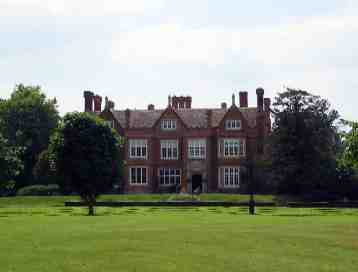 The
present Bourn
Hall is built on the site of a wooden castle that was burnt down during the Peasants'
Revolt....
The
present Bourn
Hall is built on the site of a wooden castle that was burnt down during the Peasants'
Revolt....
Following the Norman Conquest, a wooden church at Bourn was given to the monks of Barnwell Priory by Picot, the Sheriff of Cambridgeshire, who built his wooden castle next to it...Following the Reformation, the church was given to Christ's College, Cambridge
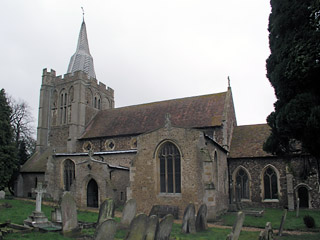 [ This
Church is: dedicated to St
Mary and St Helena, dates from the 12th century onwards and is built of field
stones and ashlar, with
dressings of limestone and clunch,
in the Transition Norman, Early English and Later styles... So here we have a
Barnwell connection.. ]
[ This
Church is: dedicated to St
Mary and St Helena, dates from the 12th century onwards and is built of field
stones and ashlar, with
dressings of limestone and clunch,
in the Transition Norman, Early English and Later styles... So here we have a
Barnwell connection.. ]
Parishes - Bourn British History Online
- BOURN
The parish of Bourn lies 7 miles west of Cambridge, and covers 3,955 a., stretching between the road from
Cambridge to St. Neots on the north and Ermine Street on the south-west. Its irregular eastern and western boundaries are mostly determined by those of open field furlongs, although to the south-east the boundary with
Kingston runs for some way along an ancient track called Porter's way. In 1949 59 a. at the north-east corner of Bourn by the St. Neots road were transferred to the adjacent
parish of Caldecote, (fn. 1) which was probably once itself a hamlet of Bourn. (fn. 2) The parish is divided by the Bourn brook, from which it takes its name, which flows through it from north-west to south-east. On either side the land rises gently to over 200 ft.
The high flat ground north of the village was from 1942 used for an airfield during the Second World War. (fn. 3) Along depressions in the downs run water-courses falling into the main brook. The soils are mostly heavy clays, overlying boulder clay on the higher ground and gault in the valley, with some gravel by the stream. The parish was predominantly arable. Until its inclosure between 1809 and 1820 it was cultivated in three open fields. (fn. 4)
...
Bourn was the most populous parish in the hundred in the Middle Ages, and remained so until overtaken by Gamlingay in the 17th
century
...
In 1086 Ramsey Abbey retained its hide, and Almar still held the 4¼ hides of Count Alan, successor of
Eddeva the Fair whose man Almar had
been. Most of the vill had come to Picot the sheriff, who had obtained 13 hides for two manors, and held 1¾ hides, formerly Almar's, of Peter de Valognes, sheriff of
Essex
...
In 1279 Bartholomew Hauteyn held c. 270 a. on the Pecche fee in Bourn of his brother,
Sir Hamon Hauteyn of Oxnead (Norf.), for £10 a year during Hamon's life. (fn. 145) Hamon later granted land in Bourn to his daughter Alice, from which, after his death in 1289, his son and heir William attempted to oust her. (fn. 146) The property has not been traced later. Baldwin St. George also held 100 a. under the Pecches, (fn. 147) which may have descended with the
St. George manor in Kingston. (fn. 148) Sir William St. George (d. 1472) included land in Bourn in a feoffment, (fn. 149)
...
Barnwell had the largest estate of those created by the large alienations from the Peverel manor. The priory's original endowment from Pain Peverel included 1 hide of his demesne at Bourn, ½ hide owned by a priest, and 1½ virgate. William Peverel gave ½ hide, Hamon Pecche 76 a., and Gilbert Pecche 15 a. c. 1275. The estate, of c. 400 a., was reckoned as a manor in 1279 and 1316, (fn. 175) and remained with the priory until its dissolution. In 1552 it was given by the Crown to Christ's College,
Cambridge, in place of a £20 annuity long in arrears. (fn. 176) The college retained the manor, the second largest estate in the parish, until
1920, when it was sold to Lawsell Long of Balsham. (fn. 177) Manor Farm, formerly the farm-house of the college
estate, retains, within its modern brick casing, the structure of a timber-framed aisled hall of
the late 13th century, probably that of Barnwell's manor-house rebuilt after it had been
burnt in 1266 by Montfortian rebels raiding from the Isle of Ely. Much of
the roof-timbers survives. (fn. 178)
The bulk of the estate of St. Neots Priory in Bourn, later called MONK
FIELDS, also came from the Peverel fee. William Peverel (d. 1148) gave the priory 100 a., or 1 hide, at
Bourn, (fn. 179) William de Verley 22 a., his son Ralph 11 a. of their fee, and Alan of Beach ½ virgate. (fn. 180) The priory's temporalities in Bourn were worth £5 3s. in
1291
...
The Knights Hospitallers of Shingay held 20 a. at Bourn in free alms of the honor of Richmond in
1282, and part of the Verley fee was held of them in 1279
...
St. John's Hospital, Cambridge, owned 9 a. of Robert Mile's fee in 1279, and received more land in Bourn c. 1380, all of which passed to St. John's
College
Bourn Hall (Clinic) - in Bourn, Cambridgeshire, England, is one of the world's leading centres for the treatment of infertility in couples. The original building, Bourn Hall, is about 400 years old. Since becoming a medical centre the clinic has seen great expansion.
Parishes - Bourn
British History Online ...The clay uplands were probably once well wooded, and wood for building and fencing was recorded in 1086. (fn. 5)
Bourn wood, by Ermine Street, belonged to Barnwell Priory's estate, (fn. 6) and passed with it to Christ's College, which, being the impropriator of the church, probably used the profits from the wood for repairing the chancel. A survey of 1796 found 195 trees there, which had been included in a lease of 1788 to St. John's College. Christ's then brought back its rights over them. (fn. 7)
At inclosure the wood passed by exchange to Earl de la
Warr, [ A Lord DELAWARE ]
(fn. 8) who had plantations covering 105 a. in the grounds of Bourn Hall by
1871. (fn. 9) ... Settlement was by the 19th century concentrated on the area of rising ground south of the brook, along the high street, close to the church and Bourn
Hall, but the inhabited area had probably once been more extensive. North and south of the brook run two streets, parallel to it and joined at their ends, leading to a group of houses at the western end of the village called Caxton End.
Between the streets and the brook, and also surrounding them, lie many ancient
closes.
Views of
the seats of noblemen and gentlemen, in England Wales Ireland Scotland
1823 Vol6 - Bourn House Cambridgeshire - The seat of George
John West - Earl de la Warr
...
| - - - - - - -- - Update:
Well Hey! Eddeva the Fair was King Harold II gal!!! So this opens up again a source where the Utlage's came from if they had been Harold's "men"or the Utlag'es were Edith's men! ... and that would explain our East Anglia / Norfolk roots.....
It is often said that the Queen Edith area in Cambridge was named after Edith the wife of Edward the Confessor and Queen of England from 1045 until 1066
[ But.... there is Eddeva ! ]
It appears that all of Edith’s land, including Hinton manor, was given to Alan Rufus ‘the Red’, one of the Counts of Brittany (later known as the Dukes of Richmond) who
fought beside William at Hastings. In a bizarre twist Harold and Edith’s youngest daughter Gunhild ended up marrying Count Alan so it is possible that the Godwin family retained connections in the Cambridge area for a short while7. There are also various records in Domesday of an “Ulf” and a “Godwin Child” - possibly Harold and Edith’s youngest son - still holding lands around Cambridge after 1066, but in effect the Godwin line was finished.Again, possibly an Utlage Bodygaurd to protect the Saxon royalty? Makes me wonder....
| - - - - - - - - - -- - - - - -- - - - - - - - - - -
Related:
"Medieval Bourn: A Cambridgeshire Village in the Later Middle Ages" by David Baxter, published by Mission Computers, Cambridge, 2008.
This book has several references to John Outlawe and Henry Outlawe at Bourn (Brunne) near Cambridge during the period of the Black Plague (1340-1400) :
1279 - Peasants in Bourn with three or more holdings - Richard Houtclawe (Outlawe) 4 holdings - 29 acres
1329 - Bourn raiding party of Kingston - John Outlawe and others, rescue 2 horses for the "lord" Priory of Bernewelle - Pg 64/65
1348 - 1350 - The Black Death under Edward II - caused the death of more than half of the nation's inhabitants - visitations of the plague again in 1361 , 1369 , 1375 - Population began to rise again in 1520
1352 - Bernewelle Priory acquires Hauteyns Estates 1350 - Henry Outlawe for 2 pence - pg 67
1381/3 - John
Outelawe
was Bailiff at Bourn/Cambridge 1381-1383 - Pg 98
1384 - Thomas
Baret relieves John Outelawe of the office of Bailiff at
Bourn/Caqmbridge - 7th year of Richard II - Pg27
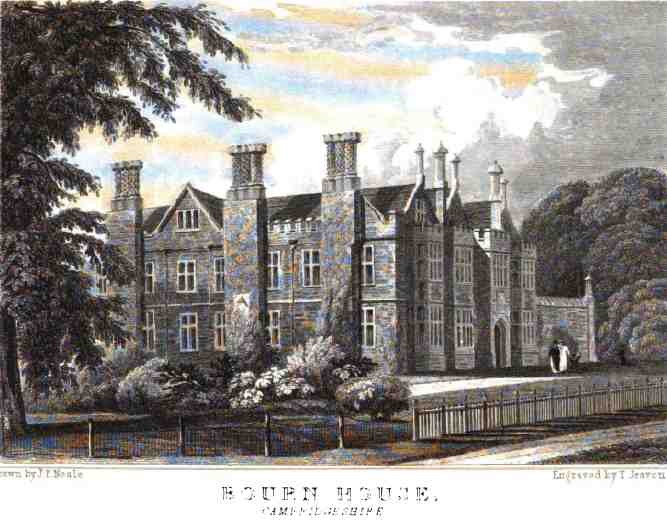 the
post office directory of cambridge, norfolk and suffolk By E. R. KELLY
the
post office directory of cambridge, norfolk and suffolk By E. R. KELLY
Pagan Peverel
- ... The youngest Peverel brother, Pagan, pursued a military
career and served as standardbearer to Robert of Normandy in the Holy Land
1096-1100. Upon his return he evidently found favour with Henry I and he
is listed for the first time witnessing a charter in January 1103.10
In 1105 he was granted the
manor of Shefford in Berkshire.11
`Payn' Peverel appears as witness to charters up to 1129,12
in which year also his daughter Matilda was granted the manor of Shefhord on her
marriage
...
The land which brought Pagan Peverel into dispute with the abbey of Ramsey, the
barony of Brunne, was conferred on him by Henry I who had confiscated it from
Robert son of Picot for conspiring against his life. The date of the grant
is not known, but it was before 1110, in which year the grant of
Barnwell to the Augustinian canons was made.14
The Liber describes Pagan as `a member of the king's household, an outstanding soldier ... and praiseworthy above all the nobles of the kingdom in matters of warfare.15 He came to Cambridge and took on the Augustinian canons there, declaring it was thirty years since his baptism and thirty years till he would go to heaven, so he would have thirty canons to intercede for him.16 (Assuming some hindsight on the part of the chronicler this suggests a date in the 1070s for Pagan's birth, and one in the 1130s for his death.)
In 1112 Pagan removed the canons' house to
Barnwell and endowed it generously. He also gave the canons ‘very true,
precious relics set in gold and topaz which he had acquired on the expedition to
Antioch with Robert Curthose while he was performing the office of
standard-bearer’.17
If there is a disparity between Pagan's great generosity to the canons at Barnwell and his rapacity concerning the estates of Ramsey Abbey, it should be observed that both traits are reported by monkish chroniclers with vested interests. They agree at least in so far as they reflect a strong sense of property.
This has be been moved to : Barnwell Priory - John Outlaw (de BernewelIe) - Cambridgeshire
Photo's of Barmwell Priory Roof('s) from Angel Roof, St. Mary and All Saints, Willingham, Cambridgeshire and Rampton Church All Saints' Church, Rampton, Cambridgeshire
see a more complete analysis : Laurence Outlaw - Lynn - Hospital of Mary Magdalen Len - This is on it's own page now.....
1204-1220 - Deed
of grant, Lynn - 1d annual rent from a certain [piece of land] 4 feet wide in
Dam[p]gate held by Peter Strac
Grant by Laurence Outlaw (Utlator) of Len to the
Hospital of the Blessed Mary Magdalen of Len and to the infirm brothers
there for the souls of his parents and his benefactors, the 1d to come from his
purse during his lifetime Anglo-Norman Studies
Proceedings of ...
-
There was an epidemic of leprosy in Europe from 1000 to 1200 A.D., which
was probably started by the returning soldiers of the Crusades. Leprosy
occurred in Britain from 625 to 1798, and at one time there were 326 lazar
houses (leprosaria) in Great Britain.
Witnesses: Robert the mayor of Len, Ralph Kelloc, Adam de Gernemut, William clerk of Gernemut, Robert the son of David, Richard de Brecha., William son of Aelld., William son of Milon, John de Geywdia, Michael de Beaw., Yvone de Lincoln, William the son of Richard, John the son of Astin and many others Endorsed as relating to Lenne. Gernemut = (Great Yarmouth),
What I find interesting were all the important people of Lynn that witnessed this deed. Like EVERYBODY witnessed it. Plus we have the "clerk" or bailiff from, Gernemut which is Yarmouth, who were probably setting up Lazar's themselves. Also we maybe able to narrow the date of this record by the witnesses i.e. the mayor since Mayor "Robert" is most likely the first mayor of Lynn, Robert fitz Sunolf. That date looks to be between 1204-1220 ... Then there is the Hospitaller connection with the Lazar houses
Why???: Everyone in town was there..... These Lazar - Mary Magdalen - Hospitals were like a franchise and connected with the crusades Hospitallers.
Back to the Crusade's...
1102 - Robert fitz- Godwin was an English knight who had served in the Anglo-Saxon fleet operating on behalf of the Byzantine Empire under Edgar Atheling. He settled in Palestine but was killed in 1102.2 - Robert fitz-Godwin seems to have been a disinherited Anglo- Saxon
The Herald and genealogist - Edgar Atheling and Robert Fitz-Godwin in Durham
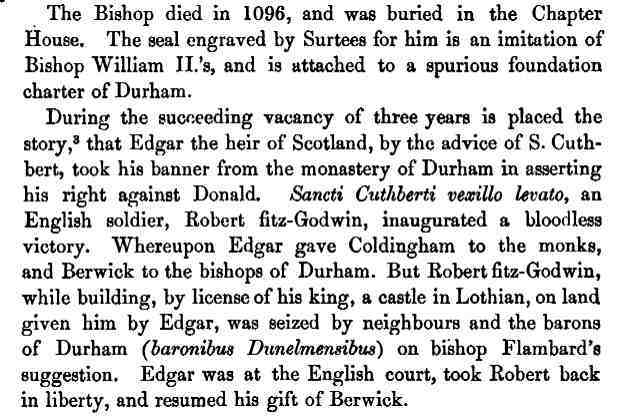
Britannia History
The Last Aetheling
...
Whilst Rufus, Malcolm, et al had been bloodying noses, Christendom had been
embarking on its holy wars: the Crusades. There is some confusion as to when
Edgar took part, although there is no doubt that he did take part, and bravely.
Nicholas Hooper gives this quote from Orderic (OV v 270)
"about ten thousand pilgrims journeying from England and the other islands of the ocean to the Lord's Sepulchre, had landed (at the port of Lattakia) at the time that the infidels were besieging Antioch and blockading the Christians in the city … amongst them the most distinguished was Edgar Aetheling ... and he immediately took the city under his protection and preserving his loyalty to Duke Robert (Curthose) transferred it to him after his victory over the Pagans"
It is possible that Orderic may have confused times and dates, for we know that Edgar was busy in Scotland in 1097, and would have been hard-pressed to reach Antioch at the appropriate time - June 1098. There is a more likely account of Edgar's adventures in the Holy Land in 1102 by William of Malmesbury.
Edgar was accompanied by his good friend and companion, Robert (the name Robert may indicate a fashion in names rather than prove Norman parentage) son of Godwine was brutally killed at Ramleh for refusing to renounce his faith and Edgar returned home - with a possibly bitter view of holy wars. The Dictionary of National Biography has Edgar crusading in 1099.
William of Malmesbury reports that Edgar was offered places at the courts of other nobles but declined. He is said to have preferred to return to his home England. If this was so, it cannot have been the nobility that he missed, not now He maybe missed the peace of his land and the people in Hertfordshire. There may have been other members of the Godwine family there, also.
It is interesting that a Godwine figures in the crusading adventures of the Aetheling, Edgar also had a Godwine as heroic companion in Scotland and they may have been the same person. Maybe he was the son of the Godwine of Winchester mentioned in the apocryphal story of the trial by combat. The story is this: An ambitious young knight, Ordgar, accuses Edgar of treason and plotting to kill Rufus (I expect a lot of people, including Edgar, had something like that in mind). Ordgar demanded trial by combat. The Aetheling was no longer in his prime as a warrior and Ordgar probably thought that he had a chance. Then a champion appeared to fight for Edgar - the mysterious Godwine of Winchester. The champion defeated and killed Ordgar. The Aetheling gladly took Godwine into his household. The Norman law of trial by combat was never really successful in England, but sometimes fact is stranger than fiction and perhaps this trial really did take place. In the records of Domesday, there is a Godwine mentioned as Steward of the Aetheling's land in Hertfordshire.
It is interesting that Roger Mowbray was connected to Durham and the Lazarus Hospitaller connection....
England and the Crusades, 1095-1588 - Google Books
1147 - The Second Crusade.... English take the cross and joined Louis VII army ... Roger of Mowbray (survived ) , William of Warenne (died), William FitzGilbert of Clare, Philip of Gloucester, William Peverel (died)...
Syria and Sir Roger - In Search of Sir Roger de Mowbray
Sir
Roger must have been a tough sort of chap, a survivor who lived to be an old man
in times when life expectation, even for an extremely wealthy man like him, was
short. In the 1180’s, ten years after he rebelled against Henry II, for
which some of his castles were destroyed, we find him in the Holy Land again,
but this time further south. He was captured at the battle of Hittîn but soon
ransomed by the Templars and is believed to have died near Tyre in present day
Lebanon.
There
is an alternative story that after his release he came home to Thirsk in
Yorkshire, accompanied by a grateful lion he had met on the way back and had
saved from certain death as it fought a terrible dragon. Some believe he is
buried at Byland Abbey, which he had co-founded with his mother.
The Mowbray Legacy - The story of one of England’s great medieval families. With genealogical tables of famous descendants including Anne Boleyn, Elizabeth I, Sir Winston Churchill, Diana, Princess of Wales, Audrey Hepburn, George Washington, Thomas Jefferson and George W. Bush.
This information will be moved to :Barnwell Priory - John Outlaw (de BernewelIe) - Cambridgeshire
East Hatley Cambridge - Esthattelle - Reginald Outlawe - Chaplin - St. Denis - 1340
Mysteriously, and surprisingly, there were once 12 or 13 moats in East Hatley. - This sounds to me like a Pre-conquest Saxon/East Anglian STONGHOLD.
1339 - The parson of the church of Potton was robbed in 1339 of wheat, barley, beans, peas and other goods and chattels to the value of forty marks by William, son of William de Hurle of Potton, John Wymond of Potton and John Lettice of Potton, The same William de Hurle and another assaulted ReginaldOutlawe, parson of the church of Esthattelee at Potton and wounded him, and William was presented as a common assaulter and disturber of the peace. - THE LANDS OF THE SCOTTISH KINGS IN ENGLAND - Potton - Wikipedia
1340 - Presentation of Reginald le Outlawe, parson of the church of Esthattele, in the diocese of Ely, to the church, of Risshenden, in the diocese of Lincoln, in the king's gift by reason of the temporalities of the priory of Lenton being in his hands, oni an exchange of benefices with Hugh de Luffenham. [ Esthattele seems connected to Barnewell Abbey - St Michaels Cambridge - St John's Hospital - John de Hattele - Estenhale: its eastern extremity towards Barnwell Priory was called Estenhale - This seems to be the only connection between East Hatley St. Denis and Barnwell ]
So the question is - What was the "church of Esthattele" ( in
the diocese of Ely) ? I haven't found any records....
Well it looks like "Hattele" is Hatley and Esthattele is East Hatley -
Cambridgshire and that the "church" was St. Denis in East Hatley...
Hatley, Cambridgeshire - Hatley is a civil parish in South Cambridgeshire, England. It lies between the villages of Gamlingay and Croydon, 12 miles south-west of the city of Cambridge and eight miles south-east of the town of St Neots. ... The Hatley name was in use as early as 986,[1] derived from 'laie' or 'ley', a woodland clearing,[2] or 'woodland clearing on the hill'.[3] The spelling Hatelaie was used in the 1086 Domesday Book.
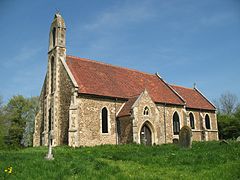 Church
of St Denis, East Hatley
Church
of St Denis, East Hatley
East Hatley is a row of houses along a smaller road. It was formerly known as Castell Hatley.[15] In 1929, the hamlet was owned by the Master and Fellows of Downing College, Cambridge.[16] Sir George Downing, 1st Baronet, after whom Downing Street is named, owned land in East Hatley (his grandson, Sir George Downing, 3rd Baronet, founded Downing College).[2]
CHURCH OF ST DENIS, - Detailed Record
Hatley St George and East Hatley - St. Denis church – also Grade II* listed and now an empty shell no longer in use and on the English Heritage Buildings at Risk register, although the churchyard is still consecrated – retains its moat; other moats can be seen from the road near Manor Barn and The Palace. - A feature of the Hatleys is that the more important buildings were once surrounded by moats. These can still be seen, especially in East Hatley.
St. Denis's church in East Hatley retains its moat, as do the ruins of what is thought to be Quy manor in the ancient Buff Wood, which in 1086 belonged to Picot, the sheriff of Cambridge.... Their lands in East Hatley passed to Sir George Downing, after whom Downing Street is named and whose grandson's money paid for the foundation of Downing College, Cambridge
Taken from Archaeology of Cambridgeshire , Vol. 1: South West Cambridgeshire, by Alison Taylor, pp 68-71. Published by Cambridgeshire County Council, 1977. ISBN 1-870724-84-4.
Possibly "The Rectory" part of the Downing Estate now....
Parishes - East Hatley - ... The living, although it always remained a rectory, was not wealthy in the Middle
Ages. It was worth only £5 or less in the 13th century, (fn. 142) and £7 16s. 6d. in 1535.
.
The rectory house formerly stood within a moat just south of the manor
house. (fn. 152) In the 1660s it had 4 hearths. (fn. 153) It was dilapidated in 1722, (fn. 154) and although inhabited by the rector in 1728 and 1775, (fn. 155) was described in 1807 as a miserable cottage, unfit for a clergyman's family. (fn. 156) It was burnt down in 1821 and not rebuilt, (fn. 157) the incumbents thereafter living at
Tadlow.
From the 14th century the parish proved too poor to keep incumbents long. Between 1340 and 1345 there were five rectors: the last was absent in 1347 in his patron's service. (fn. 158) In 1349 a fellow of Michaelhouse, Cambridge, held the cure. (fn. 159) One chaplain served in 1378 for the sometimes absentee rector. (fn. 160) Another rector was licensed in 1384 to be away for 3 years, to study at Cambridge or attend his patroness. (fn. 161) Between 1390 and 1398 three more rectors quitted the parish by exchange (fn. 162) and another in 1435 left it for a London chantry. (fn. 163) The St. Georges began to present graduates after 1500. (fn. 164) A cottage given for an obit was sold in 1550 and the church house c. 1577. (fn. 165)
The old church, named after ST. DENIS by the 18th century, (fn. 184) was built of field stones dressed with clunch. It had only a short chancel and nave with south porch. (fn. 185) The church was probably built mainly late in the 13th century, although re-consecrated in 1352
East Hatley, Cambridgeshire
- The living is a rectory in the diocese of Ely, value £175, in the
patronage of the Master and Fellows of Downing College, Cambridge, who are lords
of the manor and owners of the parish. The church is dedicated to St.
Dennis.
...
The church of St. Denis is a building of stone in the Early English
style, consisting of chancel, nave, north and south porches and a western tower
containing one bell: the chancel dates from 1260 and the nave from 1200
So who was St. Denis?
Basilica of St Denis - Founded in the 7th century by Dagobert I on the burial place of Saint Denis, a patron saint of France, the church became a place of pilgrimage and the burial place of the French Kings, nearly every king from the 10th to the 18th centuries being buried there, as well as many from the previous centuries.
Saint Denis is a patron saint of France and, according to legend, was the first bishop of Paris. A shrine was erected at his burial place. There Dagobert I, king of the Franks, who reigned from 628 to 637, founded the Abbey of Saint Denis, a Benedictine monastery.
Saint Denis (also called Dionysius, Dennis, or Denys) is a Christian martyr and saint. In the third century, he was Bishop of Paris. He was martyred in connection with the Decian persecution of Christians, shortly after A.D. 250. After his head was chopped off, Denis is said to have picked it up and walked ten kilometres (six miles), preaching a sermon the entire way, making him one of many cephalophores in hagiology.
Bristol:
1210~ - Margam Abbey - John, son of Ralph de Utlage, of the land in the meadow of Leowine, known as Lewin's-mead, near to St. James' Church, Bristol. - dated in the early years of the thirteenth century.
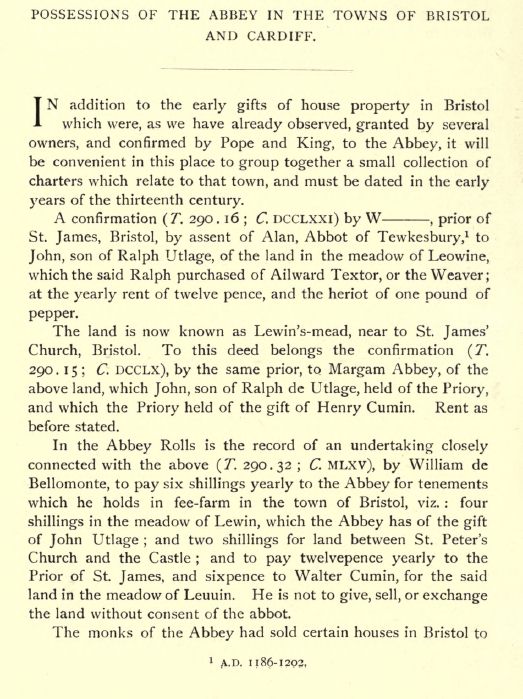
Earlier research to Early Outlaw's in Kent - Follow this link for detail
Kent Pipe Rolls - John 1198 full English translation from Latin text
Concerning the tallage made by Stephen de Turneham and his
fellows
[Rot. 5, m. 2]
And half a mark from John, son of Hildith. [ Hildith Vtlag? ]
[Rot. 5d, m. 2]
Philip, son of Roger de Wermedal, [blank] half a mark, as is
written in the roll, the record concerning Maud, niece of William de Wermedal
and Roger de Wermedal made by the barons, who are noted in the preceding
roll, just as is contained there. And half a mark, as is written in the great
roll, which is recorded by the same barons, which after the fine and
concord had been made between the aforesaid Maud and Roger,
...
...
impleaded the aforesaid Roger concerning the tenement, which is noted
in the preceding roll, and because it was adjudged that Roger should
hold the aforesaid tenement in peace, just as is contained in the chirograph
made between him and the aforesaid Maud, and because none of the aforesaid
people could implead him on account that were in the country when that fine was
made and they did not place any claim in that land, just as the aforesaid
Roger said against them in the king’s court in a plea and they did not defend
this.
| - - - - - -
I can find no information on "Roger de Wermedal" , and he is the principal so this is very frustrating....
Well Wermedal is WORMDALE , a place nearby now called Wormdale Hill...
Wormdale, Kent, ME9 7PX, United Kingdom
1213-14 - Philip son of Roger of Wormdale , prior and convent of Canterbury Cathedral Priory Witnesses: William Utelage - Wormdale, Kent
From: Philip son of Roger of Wormdale
To: the prior and convent of Canterbury Cathedral Priory
An annual payment of 20d, payable by Peter son of Ailred ('Elredus') and William
and Hamo, sons of Algar ('Elgarus') le kinghe, for 2 salt-pans ('salina'). Also
the whole part of the marsh of Warden which fell to him, which he held of the
court of Leysdown, reserving to himself 3 salt-pans and the third part of a
mill, all in the same marsh. He will, however, pay the same amount for the lands
he retains as he used to pay for the whole tenement, namely 15d and one-third of
a penny, payable in the court of Leysdown. The grant is made for a light ('ad
luminare') for the cathedral church. Made, confirmed and read ('recitata') at
the priory's court. Dated the first year after the lifting of the general
interdict in England. Slip of parchment attached to the plica through slit for
seal tag, stating that the priory recovered an annual payment of 15½d and suit
of court of the manor of Leysdown which had been lost and not paid or performed
for 50 years from William langle and Lucy, his wife, Lucy being Philip's
heir. This was done and agreed on 16 Jul 1420, in the year of St Thomas
Becket's Jubilee, when the boundaries between the demesnes of Leysdown and
Warden were fixed there with the consent of the parties and marked with a cross
('specialiter consignata'). Witnesses: Henry of Ospringe ('Ospreng''), steward
('senescallus'); Thomas de Dene'; Daniel de londonesforde; Nicholas the forester
('forestar''); William utelage; William of Godmersham; Henry ferre; James
de Hag'; Columbinus; Henry Grapinel; Adam son of Godeleva ('Godelef''); William
brabazin Endorsed with description in late 13th cent hands.
( Notice the small u - I bet that Utlage was lost in latin translation - William utelage = William Utlage )
1200-1220 - Stephen
son of Roger of Wormdale To: the prior and convent of Canterbury Cathedral
Priorys
| - - - -
1215 - Haghenild Vtlaghe - lands of Newton and Newington - Heirs One part to Hildith married Norman and William , two parts to Simon, and Adam, and Henry and Roger son of Thomas and his heirs - The register of St. Augustine's abbey, Canterbury, commonly called the Black book - Hubert de Burgh, the justice of England
The register cannot be later then 1212 - the death of Abbot Roger of St. Augustines Canterbury. But the document refers to Hubert de Burgh as Lord Justice and King John named him Chief Justiciar in June 1215. So let's say the document is 1215.....
So :
1198 - Philip and Henry and Richard and William and Jordan, sons
of Vtlag’ - Kent
Pipe Rolls - John 1198
??? Norman de Heterham ... [ Hildith married to Norman? ] So is
this "Norman"
And the third part Hildith shall take hold of the son of, to wit, Norman, and William and heirs of his. And this agreement for Vtlaghe has pledged his faith to be held faithfully, and his brethren and heirs of Hildith, Norman and William ...
This maybe Hildith married a Norman, named William ? or Hildith has a son
Norman by a father named William...
I am confused. Can you tell?
Now we need to figure out who Norman de Heterham is.... What/Where is Heter-ham today?
The Phoenician Origin of Britons, Scots &
Anglo-Saxons - Lawrence Austine Waddell
Orig. pub. by Williams & Norgate, 1924 2nd ed., 1925
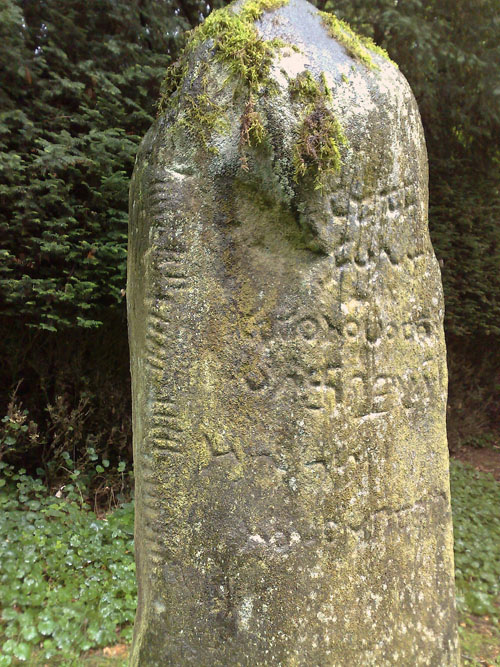
PLATE I. Aryan Phoenician inscriptions on Newton Stone of "Part-olon, King of the Scots" about 400 B.C., calling himself "Brit-on," "Hittite," and "Phoenician."

FIG 2.-Swastika Crosses on dress of Phoenician Sun-priestess carrying sacred Fire.
From terra-cotta from Phoenician tomb in Cyprus. (After Cesnola, 30.)
...
In the course of my researches into the fascinating problem of the Lost Origin of the
Aryans, the fair, long-headed North European race, the traditional ancestors of our
forbears of the Brito-Scandinavian race who gave to Europe in prehistoric time its Higher
Civilization and civilized Languages--
researches to which I have devoted the greater part of my life, and my entire time for the
past sixteen years--I ascertained that the Phoenicians were Aryans in race. That is to say,
they were of the fair and long-headed civilizing "Northern" race, the reality of whose
existence was conclusively confirmed and established by Huxley, who proved that
"There was and is an Aryan Race, that is to say, the characteristic modes of speech,
termed Aryan, were developed among the Blond Long-heads alone, however much some
of them may have been modified by the importation of Non-Aryan elements."
("The Aryan Question" in Nineteenth Century,
1890. - 766.)Thomas Henry Huxley T. H. Huxley, President of the Royal Society
Leonard Huxley, (1860–1933) author.
Huxley's descendents include children of Leonard Huxley:
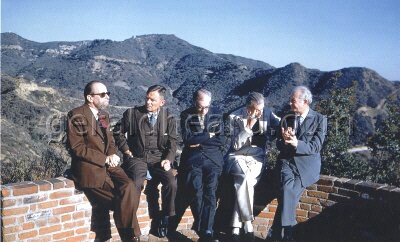
Gerald Heard, Christopher Isherwood, Sir Julian Huxley, Auldous Huxley and Linus Pauling L.A. 1960
Laurence Waddell - Lieutenant Colonel Laurence Austine Waddell[1] F.L.S., M.Ch., I.M.S. (1854–1938) was a British explorer, British army surgeon,[2] collector in Tibet, and author.
Waddell traveled extensively in India throughout the 1890s (including Sikkim and areas on the borders of Nepal and Tibet) and wrote about the Tibetan Buddhist religious practices he observed there. Stationed with the British army in Darjeeling, Waddell learned the Tibetan language and even visited Tibet several times secretly, in disguise. He was the cultural consultant on the 1903-1904 British invasion of Tibet led by Colonel Sir Francis Edward Younghusband, and was considered alongside Sir Charles Bell as one of the foremost authorities on Tibet and Tibetan Buddhism.
As an example of the early art work Notice they call it "Celtic" but it really isn't:
CELTIC SWASTICA CHARIOT ORNAMENT, c. 1st -3rd century AD.
Large bronze swastica found as a decoration for a chariot. Rust from iron attachment tenons on reverse. Intact and very rare. 3.25 x 3.25 inches
|-----
Notice the importance of the Cathars is the connection that Mary Magdalene probably had the TRUE GRAIL and the Cathars became the holders of the relic.... Notice the Phoenician connection to the Cathars , in short the Phoenicians were the remnants of Troy - The Trojan Empire.. and these were to become known as the indo-european proto-aryans
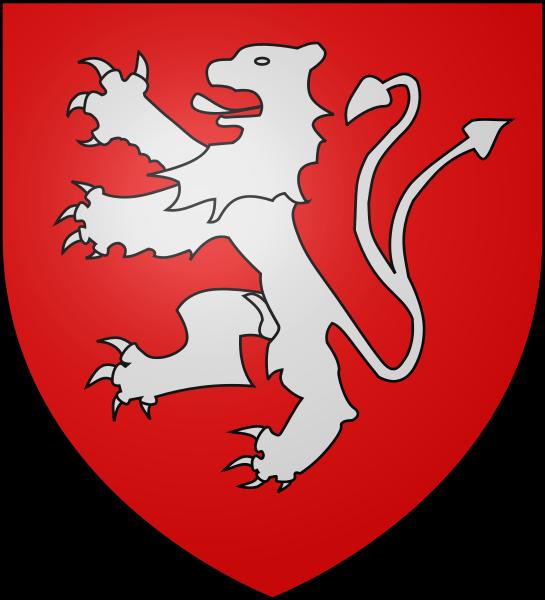 This
Simon de Montfort as Earl of Leicester is important as another Templar/Hospitaller
Holy Grail seeker....
This
Simon de Montfort as Earl of Leicester is important as another Templar/Hospitaller
Holy Grail seeker....
His son was - Simon V de Montfort - Simon's father died in 1218; one son Guy died in 1220, and in 1229 the two surviving brothers (Amaury and Simon) came to an arrangement whereby Simon gave up his rights in France and Amaury gave up his rights in England. Notice again the Lion Rampant arms..
1209 - Albigensian Cathar Crusade (1209–1229) was a 20-year military campaign initiated by the Catholic Church to eliminate the Cathar heresy in Languedoc - Notice Twenty Years!
Cathars - Cathars, Latin, Cathari, or possibly cattus, cat, a common association for witches and heretics; Greek, katharoi, "pure ones"; were Christian dualists in Western Europe which during the 13th and 14th centuries seriously threatened the Catholic Church especially in Southern France and Northern Italy...The Cathars believed Mary Magdalene was the Grail Mother.
The Phoenician Origin of Britons, Scots &
Anglo-Saxons - Lawrence Austine Waddell
...
...evidence for the presence of early Khatti in the Orkney region is forthcoming
from the district-names on the adjoining mainland. Thus "Caithness," the ancient
"Kataness" or "Nose (of the Land) of the Caiths or Kata," a people who are now disclosed
to be the Catti or Khatti (or Hittites). And the contiguous "Sutherland" was, up till the
Norse period of about the ninth century A.D., called "Catuc" or "Catland" or "Land of
the Cats," that is, the "Catti" or Hitt-ites.
Dynasty of the Holy Grail Mormonism - the Cathars became identified with the Teutonic Aryan race
Albigensian Crusade - 1209 - Simon de Montfort now took charge of the Crusader army,[24] and was granted control of the area encompassing Carcassonne, Albi, and Béziers. After the fall of Carcassonne, other towns surrendered without a fight. Albi, Castelnaudary, Castres, Fanjeaux, Limoux, Lombers and Montréal all fell quickly during the autumn.[25] However, some of the towns that had surrendered later revolted.
Simon de Montfort, 5th Earl of Leicester - ... In 1213 he defeated Peter II of Aragon at the Battle of Muret. The Albigensians were now crushed, but Simon carried on the campaign as a war of conquest, being appointed lord over all the newly-acquired territory as Count of Toulouse and Duke of Narbonne (1215).
He spent two years in warfare in many parts of Raymond's former territories; he besieged Beaucaire, which had been taken by Raymond VII of Toulouse, from 6 June 1216 to 24 August 1216. ...After maintaining the siege for nine months Simon was killed on 25 June 1218 while combating a sally by the besieged. His head was smashed by a stone from a mangonel, operated, according to the most detailed source, by donas e tozas e mulhers ("ladies and girls and women") of Toulouse.[3] He was buried in the Cathedral of Saint-Nazaire at Carcassonne.
Ok, Let's compare the Hanseatic league arms symbol ( Coat of Arms of the Hanse - Merchants of London ) to Hittite Eagle from an Anatolia Hittite vessel... ~1300 B.C. :
Antiquities Dealer and interesting photos:
An interested reader came up with this:
I need to check out is these are related to THE PECCHE's of Norfolk... Also it seems to me the family were crusaders....
1260 - Witness Richard le Utlawe - Essex - Grant of Rent William de Wateville to John de Vallibus and his heirs of land in Hempstead, Essex witnessed by Sir Nicholas Peche, Sir Andrew de Helyun, Sir Simon Peche, Philip de Codree, John de Bosco, Richard de Kanne, Richard le Utlawe, Hugh de Sanford, Roger de Reymes, Geoffrey de Bello, Simon Clericus
Related:
1260 - LITTLE WENHAM CASTLE - circa 1260-1290 for Sir John de Vallibus - Fortified House, now used as a private museum.... The house is of great importance as it represents one of the earliest uses of home made brick in England and it was built as a house, not a keep. The hall came to the Holbrooks & Debenhams
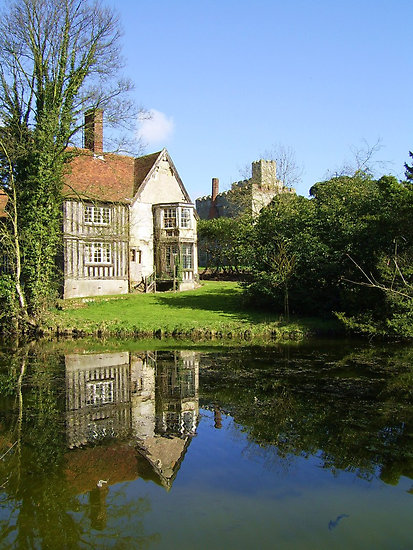
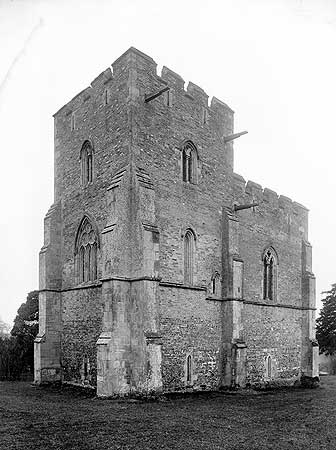
Found these supporting records that seem to be the same reference:
Essex, Hempstead.- Grant of a rent
Essex, Hempstead.- Grant of a rent and quitclaim for the release of annual payment, William de Watevile to John de Vallibus, his wife Alice and his heirs by her: grant of four shillings rent in Hempstead to be taken from a half-virgate of land in Hempstead which William de Estone held of Watevile, and quitclaim of two shillings rent from the tenement in Hempstead of Alan Lovesone, to hold of Watevile for a pound of pepper on 25 December for all services, in return for a release by John and Alice of an annual payment of a buck and a doe and ten cartloads of wood which he is bound to make to them and their heirs from his park of Hempstead, witnesses: Sir Nicholas Peche, Sir Andrew de Helyun, Hugh de Sanford and others, manuscript in Latin, on vellum, 16 lines, green wax seal appended showing a mounted knight with raised sword leaping a star with the legend "Sigill' Willelmi de [Watevi]le", some wear, chipped, docket on verso: "this is a dede of honnor to rattewell", folds, a little creased and planet, 102 x 178mm., [c. 1260].Found:
Lot 275 Essex. A fine and very early medieval charter - Dominic Winter Book Auctions Artfact
Description: *Essex. A fine and very early medieval charter made during the reign of Henry III, (c. 1260), being a grant of a rent and quitclaim for the release of an annual payment, William de Watevile to John de Vallibus, his wife Alice and his heirs by her, 1/ Four shillings rent in Hempstead (Hamstede) to be taken from a half-virgate of land in Hempstead which William de Estone held of William de Watevile, saving the customs which are owed to him, 2/ Two shillings rent from the tenement in Hempstead of Alan Lovesone to hold of William de Watavile gor a pound of pepper on 25th December for all services, William de Watevile grants 1 above and quitclaims 2 above in return for a release by John and Alice of an annual payment of a buck and a doe and ten cartloads of wood which he is bound to make to them and their heirs from his park in Hempstead, witnessed by Sir Nicholas Peche, Sir Andrew de Helyun, Sir Simon Peche, Philip de Codree, John de Bosco, Richard de Kanne, Richard le Utlawe, Hugh de Sanford, Roger de Reymes, Geoffrey de Bello, Simon Clericus, [this document without a trace of a seal, so would appear to be a contemporary copy issued with the original at that time] (1)
related:
Amazing a Glanville connection Julian Glanville is Symon Peche's wife:
Sir Simon de Pecche &. Julian de Glanville Mini Biographies
~1225, Simon born in England, s/o §Sir Gilbert Peche & Maud Leach.
~1225, Julian born in England, d/o 11817222. Sir Geoffrey de Glanville & 11817223. Margaret de la Haye.
Julian coheir [with her sister Alianore married to Lord Almuric Peche] of her brother
Sir Geoffrey de Glanville.
1246, Royal grant to Simon Pecche. (S) Magna Britannia, V5, Derbyshire, 1817.
1255, Simon Pecche of Brandeston had free warren in his manor, William Pecche his son. (S) History and Antiquities of the County of Norfolk, Armstrong, 1781, P96.
3/1256, Simon Peche has paid in the king’s Wardrobe to Arcald de St. Romano etc. at Norwich five marks of gold to be bought
there from for having a charter of warren and acquitting it. (S) Fine Rolls of Henry III.
7/10/1270, … Protection with clause volumus, for four years from Easter, for Robert de Ufford, crusader, who is going with the King and with Edward the king’s son to the Holy land.
The like for the following crusaders … Simon Peche … (S) Fine Rolls of Henry III. [Simon’s son William also went on crusade.]
8/1270, Simon left on the 8th crusade with Lord Edward.
11/10/1270, Simon, with Edward, arrived in Tunis.
8/1274, King Edward and the English [likely including Simon] returned from the crusade.
8/3/1279, Commission … where by danger might arise by lapse of time to Simon Pecche and Julianan his wife, touching the advowson of the church of Rollesby, co. Norfolk, now long void. (S) Calendar of Patent Rolls.
1281, Simon de Peche and Julian his wife granted lands here to Clement, son of Edmund de Paston, by fine, and also to Laurence de Repp.
1281, Nicholas de Castello v. Symon Peche and Juliana his wife in
Cringelford. (S) Feet of Fines for Norfolk, V1.
1286, William de Rollesby v. Juliana the wife of Symon Pecche, of the advowson of Rollesby. (S) Feet of Fines for Norfolk, V1.
6/18/1289, To Roger Lestrange (Extraneo), justice of the Forest this side Trent. Order to deliver on bail Simon Pecche of Mundene, imprisoned at Colchester for trespass of venison in the forest of Essex. (S) Calendar of the Close Rolls.
2/5/1290, Licence for the alienation in mortmain to the prior and convent of Norwich of … 7.5 acres of land in Marcham by Juliana Pecche, … (S) CPRs.
(S) Norfolk Archaeology, V4, 1855, PP11.
Family notes:
• 1222-3, The grant of a Wednesday market to Simon Peche at Castleton.
• 1234, Symon Peche held 3 parts of a fee of the king in Gukenton, Norfolk.
• 1242-3, Gilbert Pecche held three knight’s fees in Kingston, Wimpole, and Eversden; held by Hamon Pecche in 1166. (S) County of Cambridge and the Isle of Ely, V5, 1973.
Child of Simon and Julian:
i. Cecily de Peche (2954305), born ~1245 in England. [Heir]
Posted by Bond0007 at 10:38 PM
| - - - -
House of Glanville from A.D. 1050 to 1880 - Pages 1 to 20
In the year 1240 Sir Geoffrey held one Knight's fee of the Lordship of Castle Acre, which, with his other extensive possessions, on his death went to his daughters and coheirs on the decease of his son Geoffrey. In the same year he conveys by fine to Thomas the son of Richard de Backeton free lands in his Lordship of Bacton.
Sir Geoffrey de Glanville married Margaret daughter of Sir Geoffrey de-la-Haye, and by her had issue:-
(1.) Geofrey de Glanville, who dying without issue, his property descended
to his five sisters and coheirs. [fn 19]
Margaret de Glanville, married Edmund, Earl of Cornwall.By the death, of Geoffrey de Glanville, the elder line of the Glanvilles failed, and a part of the lands of that branch went into the families of his sisters, which will be seen under the account of the following manors.[fn 20]
Alianore de Glanville, married Lord Almuric Pecche.
Agnes de Glanville, married Baldwin, a Norman.
Emma de Glanville, married Sir John de Grey.
Basilia de Glanville, married Sir William Boville.
Julian de Glanville, married Sir Simon Pecche.
Alianore de Glanville, first daughter and coheiress, brought her portion of Lordship of Bacton to her husband Lord Almuric Peche.
Edmund Earl of Cornwall granted, in 24 Edw. I., the wardship of William de Leach to John de Walcot, which belonged to him on account of the custody of Thomas son and heir of Sir Edmund Peche Kt., and of Richard Leche his brother, if William died under age. Julian fifth daughter and coheiress, married Symon Peche, brother to Almuric. In 9 Edward I. Simon de Peche and Julian his wife granted lands here to Clement, son of Edmund de Paston, by fine, and also to Laurence de Repp. In 30 Edward I William Peche and Rose his wife and John their son were seised of a manor in Bacton, which had been afore granted by Julian Peche and held of the honour of Eye by the service of 6d. every 32 weeks; it was valued at £7 12s. 8d. This manor then came to the Pastons by the marriage of Cecily, daughter and heiress of Sir Simon Peche, with Walter de Paston. A park is mentioned at Bacton in ancient times, and there is a place called to this day Bacton Wood.
1682 - Thomas and Edmund Outlaw - Thelnetham Suffolk - Bokenham Family
Thelnetham - is a village and civil parish in the St Edmundsbury district of Suffolk in eastern England. Located on the southern bank of the River Little Ouse (the Norfolk-Suffolk border), six miles west of Diss, in 2005 its population was 230
West Suffolk - The Bokenham Family
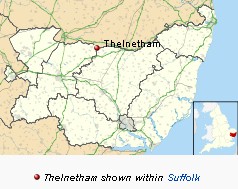
The Manors of Suffolk - Bokenham - Thelnetham

Everyone in Cambridge attacks a clerk and his men ? hmmm... Why? There was a Great Famine going on...
Commission of oyer and terminer to William de Ormesby, Robert de York. Maddingie and John de
Crek,
on complaint by Thomas Baynard, clerk,
that Henry de Toft, John Baroun, Thomas Bateman, Geoffrey Seman, Berard Le Baker, John de
Leyk,' fisher/ Robert Dunnyng, John Morice,
Robert de Comberton, Bartholomew le Baker, Peter de Bernyngham, Walter de
Bedeford,' baker,' Geoffrey de Wardeboys, James Godelombe, Ralph
de Cumberton, * wollemonger,' William Redehode, Robert Scot, William de Walden, William
Seman, Simon le Grey, John Toylet, Michael Pilet and
John his son, John le Eyr, Michael Wolwarde, Walter de Berkyng, Miles de
Trompeton, Bartholomew Morice, William de Bninne, Ralph de
Cumberton,' ireinongere/ Robert de Shefford, Robert de Brune, Nicholas le Barbur and Alexander his son, John
Berfote, * barker,' Peter de
Newenham, William Holay, 'barker,* Richard de Silham, John Robelard, Henry de Berton the younger, Robert
Lorfevre", William de Hyndercle the
younger, Walter le Pestoure, William de Hyndercle the elder, Stephen le Boghier, John Petit, *
boucher/ James le Boucher, Ivo le Boucher,
Bartholomew le Walshe, Richard de Hadyngham, John Goldecorne, Richer le Spicer, Adam le Spicer, William
Flemyng, John de Cumberton, * boucher/
Walter le Flesshehewer, Robert Wornbe, ' boucher,' Roger le Keu, John Edward, John de Lincoln, John de
Kymberle, Thomas bis brother, Hugh
le Flemyng, John his brother, John Andreu, John de Coulyng, John de Bitering, William
Godeyer, Simon de Stocton, Henry de Trumpeton, Ralph
Alum, 'fevre/ Geoffrey de Thacstede, John de Snoring, Richard do Thacstede, Geoffrey de Ely,
John Utlagh, Robert de Belton, John de
Denford, Robert de Pynchebek, John de Brunne, John de Leyk, Thomas de Tychewell, William
Carbonel, Simon de Refpharn, Robert le Sherman,
John ' the prestesone' of Norwich, Thomas de Neuton, John de Tychewell, Stephen
Godesone, John le Sherman, Thomas le Roper, Thomas le Turner,
Maurice le Cordewaner, John de Oklee, Stephen de Thetford, Robert Godyns, William le Baker, Robert le Barbour, Robert
Baroun, John Vescy,
Richard Gerewey, Alexander le Beer, Robert le Long, John Payn, John Pawe, John de Ware, Alan de
Badburgham, Ralph le Taillur, William de
Elsingham, William Alum, John de Letton, Roger le Wollemongere, John Doke, Hugh de Burgh, John le
Mareschal, Wakelin le Taillur, Geoffrey
de Haverhill, Roger Utlagh, John Martyn, Robert Waryn, Bartholomew Pawe and John his brother, William de
Byry, John de la Sale, Hugh le
Tynuour, Roger Hound of Henney, Robert le Piper, Laurence Otes, John Fresel, Alan de
Lege, John Ravel, Robert Rye, William Derlyng, John de
Lyngwode, John le Peutrer, Robert de Gretton, James de Gapton, Henry le Glovere, Robert
Biry, William de Wyndesore, Robert Hassok, John
Goggyns:, Nicholas Seman, Walter le Wise, Humphrey de Pynchebeck, Roger de Sancto
Neoto, John de Cestreton, William le Keu, Robert de
Grantesden, Thomas de la Marche.l baker,' Robert de Thurrok, Thomas de Leycestre, John de Sutton, Thomas
Leyflif, Henry Denys of Eye,
Gerard atte Grene, William Toillet, Roger de Kendale, Nicholas le Pestour, William de London, Robert le Baker, Richard Laurence, Adam de
Leveringion, Simon le Baker, Robert le Salter, Robert de Cleyhith, Roger de
Hokyton, John de Ellesworth, Edmund le Keu and Henry Peryn of
Cambridge, with the commonalty of the town of Cambridge and others,
assaulted him at Cambridge, carried away his goods and assaulted his men and
servants. By K.
Found another similar record five years later... Roger Utlagh in Cambridge again:
Calendar of the Patent rolls preserved in the Public record office, Volume 3 - Google Books

Grantchester - is a village on the River Cam or Granta in Cambridgeshire, England. It is listed in the Domesday Book (1086) as Grantesete and Grauntsethe.
Bletsoe - is a village and civil parish in Bedfordshire, England. It is on the A6, and about eight miles north of Bedford. The village has a small park, and a church. Nearby places are Sharnbrook, Milton Ernest, Riseley, Thurleigh, Odell, Souldrop, and Swineshead. The nearest town to Bletsoe is Rushden, over the border in Northamptonshire. The small hamlet of Bourne End borders Bletsoe and is part of the civil parish.
Bletsoe Manor - The first record of Bletsoe Manor is stated to be in the early 13th century when Robert de Broi, son of Walter, granted land in Bletsoe to the Hospital of the Holy Trinity in Northampton. The Broi/Broy family also owned land in Colmworth and other nearby parishes. At any rate in 1219 Robert de Broy and his son-in-law Walter de Pateshull disputed the ownership of the advowson of Bletsoe church with the Hospital.
Walter de Pateshull's son Simon was recorded as tenant of the manor under the overlordship of the Barony of Bedford between 1247 and 1253 when he gave land in Bletsoe to John de Berdefeud and others. The de Pateshulls held Bletsoe until 1359 when William de Pateshull left four sisters as co-heiresses and it was Sybil, wife of Roger de Beauchamp who received Bletsoe. The manor passed to the Saint Johns in 1421 when Margaret de Beauchamp, then aged eleven, inherited it. She married Sir Oliver Saint John and, after his death, John Beaufort, Duke of Somerset, to whom she bore Margaret Beaufort, mother of King Henry VII (1485-1509). When the elder Margaret died in 1483 John Saint John, the son she had with her first husband inherited Bletsoe and the manor remained with the family from that point onwards.
Bedfordshire County Council Bletsoe Church
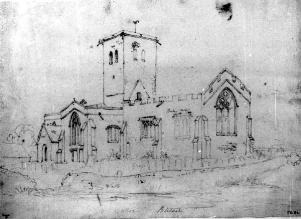

List of Rectors ...
- Roger de Pateshull;
- Thomas de Pateshull - 1 May 1310 [acolite; on
resignation of Roger de Pateshull];
- Roger de Pateshull - 17 Sep 1310 [subdeacon; on resignation of
Thomas de Pateshull];
- William de Wasseburn - 8 May 1317 [priest; on death of Roger de
Pateshull];
Richard Outlawe 1399 Cambridge : The Zouch's were a great family in the day...
1399 - Richard Outlawe, 58, on that day went with master Ivo la Zouch, chancellor of Cambridge University, to the church - See : Richard Outlawe 1399 Cambridge
Updated information regarding Outlaw Farm road provided by Mr. Speller - Thanks! :
Outlaw Farm Rd.
The farm was part of Edward Ralph Outlaw's Plantation Estate left to him by his father, Edward Cherry Outlaw. David Stanley Outlaw was his uncle and not his father as has been record by some other researchers. David Stanley Outlaw was the brother of Edward Cherry Outlaw and became Edward Ralph Outlaw's guardian upon his father's death.
Edward Ralph Outlaw had a son, James Outlaw, in 1858. When James Outlaw married about 1878 or 1880, Edward Ralph Outlaw deed him most of that tract of land that you see and James Outlaw acquired the rest and also cleared some of these tracts for farming.
James Outlaw also acquired tracts of land in the Indian Woods area that has belonged to the Outlaws. Rascoes, Bonds, Coopers, and Smallwoods. I have been told by relatives that James Outlaw owned more than 2,500 areas of land when he died in 1925.
James Outlaw married Malinda Mitchell. One of their children was Maggie Outlaw. Maggie Outlaw married Turner R. Speller. My father, Benjamin F Speller, was their son. Some of James Outlaw descendants still own parts of this farm and other land in the area. Others sold their shares of this farm to my cousin, Dr. Horace Ward, who is also a Bond and Speller descendant as am I.
The James Outlaw Family Cemetery is located on the right hand side of the Outlaw Farm Road in the slight curve near the end of the road shown on the map.
Here is a web address that will provide more information about my relationship to the Outlaws, Bonds, Spellers and others in the area.
Outlaw - http://www.sallysfamilyplace.com/Rayner/african.htm - Benjamin F. Speller, Jr., Ph.D.
Historic Hope Plantation Windsor, NC
"Blood's Thicker Than Water"
Family History and Genealogy Fair - July 29 - 30, 2011
Learn More! - Historic Hope Plantation Windsor, NC
NewsRelease%20and%20Flyer%20InformationFinalPDF
Peoples of Native American, European, and African origins all share in the economic and cultural legacy of what is now Bertie County and surrounding counties in northeastern North Carolina. Historic Hope Foundation is offering a family history and genealogy fair that will allow participants to share and learn about their diverse ancestors who lived in Bertie County from early colonization to the present.
Cecilia Utlaghe / Outlawe - 1279 - Rochester ----
>>> from Ireland!!!
1279 - June
12 Rochester - Simple Protection, for three years, for David de
Pembrok, and Cecil[ia] la Utlaghe - Kings Writ - 7 Edward I
Interesting record / what exactly was the connection Cecilia Outlawe to David de
Pembroke ????? They seem to be young, traveling from Ireland
and staying in England, possibly schooling.
For a woman to get a writ of protection from the King in this time period had to
be from a family of importance (to the king).
Just amazing.
There is a De Clare - Ireland - Templar connection - Why were they in
Rochester?
This seems to be the same David Pembroke that travels from Ireland to go to war
in Scotland thirty years later. :
He seems to ready for war by giving power of attorney in 1313 then dies
sometime in battle with the Scots by Aug. 1314 ,
This would probably mean he died at the Battle of Bannockburn
24 June 1314, which is interesting in that it also has a Mowbray connection with
Sterling castle:
related: Laurence Outlaw (Utlator) - Lynn - Mary Magdalen - The "Master of Burton" originally was Roger de Mowbray : Roger de Mowbray was the son of Nigel d’Aubigny, one of Henry I’s leading men, and Gundreda de Gournay. Roger took his surname from Robert de Mowbray, earl of Northumberland..
| = = = = =
Around Lent of 1314 Edward
Bruce, brother of the Scottish king, began the siege of Stirling
Castle, which was commanded by Sir Philip
Mowbray. Unable to make any headway, Bruce agreed to a pact with Mowbray -
if no relief came by midsummer
1314, the castle would surrender to Bruce.
...
The English army marched rapidly to reach Stirling before Mowbray's agreement
expired on 24 June. Edinburgh
was reached on 19 June and by 22 June, it was at Falkirk,
only 15 miles short of its objective
Of course , by June 24th, the English lost this battle badly and Edward II's army was destroyed:
Edward fled with his personal bodyguard, ending the remaining order in the army; panic spread and defeat turned into a rout. He arrived eventually at Dunbar Castle, from here he took ship to England. From the carnage of Bannockburn, the rest of the army tried to escape to the safety of the English border, ninety miles to the south. Many were killed by the pursuing Scottish army or by the inhabitants of the countryside that they passed through. Historian Peter Reese says that, "only one sizeable group of men—all footsoldiers—made good their escape to England."[9] These were a force of Welsh spearmen who were kept together by their commander, Sir Maurice de Berkeley, and the majority of them reached Carlisle.[9] Weighing up the available evidence, Reese concludes that "it seems doubtful if even a third of the footsoldiers returned to England."[9] Out of 16,000 infantrymen, this would give a total of about 11,000 killed. The English chronicler Thomas Walsingham gave the number of English men-at-arms who were killed as 700,[7] while 500 more men-at-arms were spared for ransom.[27] The Scottish losses appear to have been comparatively light, with only two knights among those killed
| - - - - - -
Robert de Scales, 1st Baron Scales - Lord Robert de Scales was a Knight Templar[1] and loyal supporter of Edward I in his campaigns in Wales, Scotland, France and Flanders. In 1299 he, and his heirs, were bestowed with the title, Baron Scales and were henceforth known as 'Lord Scales'.[2] Robert died in 1304......In 1301 Robert, along with one companion, two knights and eleven horsemen, accompanied Edward I on his campaigns against William Wallace in the First War of Scottish Independence
30+ years later:
1314 - May 6 - Protections
- David de Pembroke - Calendar of documents relating to Scotland
1314 - Aug
24 - Lenton - Pardon, on account of the good service in Scotland of David de Pembroke, deceased, to Elena his wife of the 32 marks in which he was bound to the king for
the farm of the manor of Templeton in Notherd, late of the Templars, in the county of Katherlagh in
Ireland, and which he held of the king's grant during four years. The said Elena and the heirs of the said David de Pembroke are to be entirely quit of the said 32
marks. - 8 Edward II.
JSTOR Irish Historical Studies, Vol. 13, No. 51 (Mar., 1963), pp. 197-211
| - - - - -
This "de Pembrok" and Utlaghe may connect with the original Invasion of Ireland:
New Ross - New Ross was in the territory of Dermot McMurrough and came to prominence when the Anglo-Normans conquered the region. The Norman knight William Marshall and his bride Isabella arrived during the early part of the 13th century...Isabella was the only child of Strongbow who was married to Aoife, daughter of Dermot McMurrough, King of Leinster. The arrival of Isabella and William is described in the Chronicles of Ros, which are in the British Museum. It records that in 1189, Isabella set about "building a lovely city on the banks of the Barrow". The town's fortunes further increased when King John made William Earl of Pembroke at his coronation in 1199. A year later, the Earl Marshal transferred the Norman capital of Leinster to Kilkenny and New Ross became the main port. ... The town grew around the bridge built by William Marshal, son-in-law of Richard de Clare, 2nd Earl of Pembroke (Strongbow), and a leader of the Norman invasion of Ireland. The town of New Ross (the town of the new bridge) was granted a Royal Charter in 1207.
Pembroke Castle (Wales) - In 1189, Pembroke Castle was acquired by William Marshal. The Earl Marshal then set about turning the earth and wood fort into an impressive stone castle ... In August 1189 Richard I arranged the marriage of Isabel, de Clare's granddaughter, to William Marshal who received both the castle and the title, Earl of Pembroke. He had the castle rebuilt in stone; establishing the great keep at the same time. Marshall was succeeded by each of his five sons. His third son, Gilbert Marshal, was responsible for enlarging and further strengthening the castle between 1234 and 1241. However, all of Marshal's sons died childless
Isabel Marshal - (9 October 1200 – 17 January 1240) was a medieval English countess. She was the wife of both Gilbert de Clare, 4th Earl of Hertford and 1st Earl of Gloucester and Richard, 1st Earl of Cornwall (son of King John of England). With the former, she was a great grandparent of King Robert the Bruce of Scotland.... Born at Pembroke Castle, Isabel was the seventh child, and second daughter, of William Marshal, 1st Earl of Pembroke and Isabel de Clare. She had 10 siblings, who included the 2nd, 3rd, 4th, 5th and 6th Earls of Pembroke; each of her brothers dying without a legitimate male heir, thus passing the title on to the next brother in line
*Maud de Clare
born about 1276 Gloucestershire, England died 1 February 1327
father: *Thomas de Clare born about 1248 Tonbridge, Kent, England died February 1287/88 Thomond, Connaught, County Clare, Ireland
mother: *Juliana FitzGerald born about 1243/49 Ireland died after 1309 married Essex, England
father: *Richard de Clare born 4 August 1222 Gloucestershire, England died 15 July 1262 Ashenfield Manor, Waltham, Kent, England
buried 28 July 1262 Tewkesbury, Gloucestershire, England
mother: *Maud de Lacy born about 1223 Lincoln, Lincolnshire, England died before 10 March 1288/89
father: *Gilbert de Clare Earl of Gloucester born 1182 Hertford, Hertfordshire, England
died 25 October 1230 Penrose, Brittany, France
buried 10 November 1230 Tewksbury, Gloucester, England
mother: *Isabel Marshall born 1206 Pembrokeshire, Wales christened April 1206 St. David's, Pembrokeshire, Wales
died 16 January 1240 Berkhamstead, Hertfordshire, England buried Beaulieu, Southampton, England
married 9 October 1217 England
|- - - - - -
Ok, why did they name her Cecilia??? After Saint Cecilia of course!
Saint Cecilia - is the patron saint of musicians[2] and Church music because as she was dying she sang to God. Her feast day is celebrated in the Roman Catholic, Anglican, Eastern Orthodox, and Eastern Catholic Churches on November 22
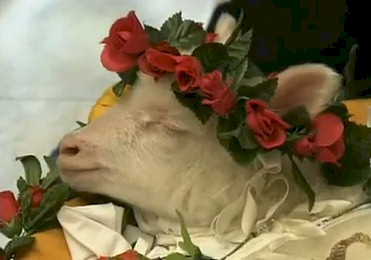 The
Sisters of Saint Cecilia are a group of women consecrated religious
sisters. They are the ones who shear the lambs' wool used to make the
palliums of
new metropolitan archbishops. The lambs are raised by the Cistercian
Trappist
Fathers of the Tre
Fontane (Three Fountains) Abbey in Rome. The lambs are blessed by the
Pope every January 21, the Feast of the martyr Saint
Agnes
The
Sisters of Saint Cecilia are a group of women consecrated religious
sisters. They are the ones who shear the lambs' wool used to make the
palliums of
new metropolitan archbishops. The lambs are raised by the Cistercian
Trappist
Fathers of the Tre
Fontane (Three Fountains) Abbey in Rome. The lambs are blessed by the
Pope every January 21, the Feast of the martyr Saint
Agnes
Meaning of the name - The name "Caecilia" was shared by all women of the Roman gens known as the Caecilii, whose name may be related to the root of 'caecus', blind. Legends and hagiographies, mistaking it for a personal name, suggest fanciful etymologies. Among those cited by Chaucer in The Second Nun's Tale are: lily of heaven; the way for the blind; contemplation of heaven and the active life; as if lacking in blindness; a heaven for people to gaze upon...
Dominican Sisters of Saint Cecilia
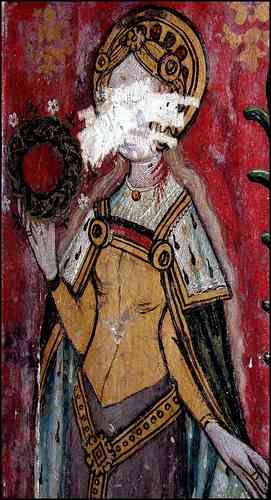 St
Andrew, North Burlingham, Norfolk
St
Andrew, North Burlingham, Norfolk
This is pure speculation but a possible Utlage origin via Bodeham -> Bodiam:
It also shows that place names in Norfolk sometimes came from place names of the south which were named after the new Norman owners....
Bodiam Castle - East Sussex - England
Bodiam Castle
- Sir Edward Dalyngrigge was something of a character in his day, he belonged to an old established Sussex family who came from present day Dalling Ridge, near East Grinstead, but returned from France in 1377 much more wealthier and powerful. It was after
he married Elizabeth Wardeux he came into possession of the manor of Bodiam in
1378.
This manor house was not where the present Castle stands, but to the North of
Bodiam Church in the adjacent valley of the Kent ditch. The site was excavated
in the 60's and 70's and pottery finds indicated it was in use from the late
13th century until the building of the Castle.
The Wardeux family had acquired the manor by marriage to the de Bodeham family, who had held it since the conquest when it was given to Hugh of Eu. He gave it to his son who took the name de Bodeham from the name of the Saxon settlement on the site.
The Gentleman's magazine library ... - Google Books
Bodiam - is a small village and civil parish[2] in East Sussex, England, in the valley of the River Rother near to the villages of Sandhurst and Ewhurst Green. It is home to Bodiam Castle, ...There is also a 12th-century church, which contains a brass of a knight with the arms of the de Bodeham family, one of the first lords of the manor....Originally it was a port and crossing point from Battle to North Kent. During the medieval period a great moated castle was built and is now a popular visitor attraction.
| - - - - -
"The Wardeux family had acquired the manor by marriage to the de Bodeham family, who had held it since the conquest when it was given to Hugh of Eu."
Now the reason I get into all this is that they may have been Saxon's or (Norman's?) pushed out and forced to move north up to Norfolk to be called "Bodham" ie .. they were left landless after the Norman Wardeux family got it by marriage (right! what a stretch...):
Bodham - is a coastal village and a civil parish in the English county of Norfolk... Bodham has an entry in the Domesday Book of 1085.[3] In the great book Bodham is recorded by the names Bod(en)ham, and Botham. The main landholders Hugh de Montfort and Walter Giffard. The main tenant was said to be Ralph.
1270 - Eighth
Crusade - 20 August Edward sailed from Dover
for France, brought with him around 225 knights and all together
1000 men
1270 - Hugo
le Utlagh - Close Rolls, May 1270 - Henry III - Hugh le Utlagh is
come before the king and asked for the land of Thomas le Utlagh to the
same Thomas in Bodeham released on pledges, etc.
1270 - Hugh
le Utlaghe de Bodeham gives
half a mark for having a writ ad terminum. Order to the sheriff of
Norfolk. Oct/1270-1
1271/4 - Ninth
Crusade - Edward continued on to Acre,
crusader outpost in Syria. His time spent there is often called the Ninth
Crusade. - 2 August 1274 did Edward returned to England, and
was crowned on 19 August
1272 - Norfolk.
Thomas le Utlaghe, Hugh le Tayllur, Olyva his wife and John le Bakun have
made fine with the king by 40s. for having a writ of appeal, concerning
which they have paid 20s. into the king’s Wardrobe for which they are
quit, and they are to pay the other 20s. at the king’s Exchequer. And
they have lands in Norfolk.- 56 Henry III
1272 - Whereas Thomas le Utlagh of Bodham, by a writ obtained from the chancery in his name without the king's knowledge and will, is drawn into a plea before the justices of the Bench over a messuage and 50 acres of land in Bodham for this that these were said to be the king's escheats of the lands of Normans ; the king because he now knows for certain that they are not his escheats and that the said writ was obtained by enemies of the said Thomas to annoy him, being unwilling that he should be worried by reason of his suit contrary to justice, to provide for the discharge of his soul and of the souls of his heirs, at the instance of Augustin Auger, king's yeoman, remits to Thomas and his heirs his suit so far as regards any exaction or challenge of the messuage and land. - Westminster - May 8 1272 - 56 Henry III
Escheat (pronounced "ee-sheet") is a common law doctrine which transfers the property of a person who dies without heirs to the crown or state ...At the Norman Conquest of England all the land of England was claimed as the personal possession of William the Conqueror under allodial title. The monarch thus became the sole "owner" of all the land in the kingdom, a position which persists to the present day
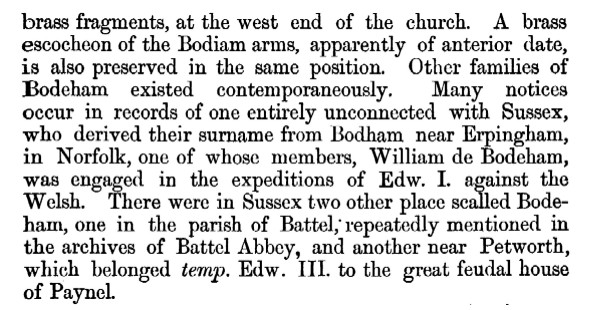
---- > Go to Outlawe Research Journal Page 2